Blog > The 10 best PowerPoint Games to play in Workshops, Classrooms & Presentations

The 10 best PowerPoint Games to play in Workshops, Classrooms & Presentations
01.01.20 • #fun #game #powerpoint #presentation.
In our last blog post, we talked about tools and tips on how to boost the audience engagement in your presentation. One of our recommended ways to do so was to play games, as they release tension and function as a fun element that lightens the mood. That’s why today we are going to list the Top 10 best games to play in your presentation.
1. Would you rather
Is it a game that everyone knows already? Probably. But did we have to include it on the list because it is just perfect for playing with your audience? Definitely. The game is pretty much self-explanatory – You give your attendees two (or more) scenarios and they have to choose which one they’d rather experience. Combining the Would you rather – question with your presentation topic is usually very easy, but we also thought of some questions you could use for any topic (e.g. as an icebreaker, to get to know your audience a little better, to ask about their opinion or just as a fun element in between). You can let your audience vote by letting them raise their hands or by using an interactive poll tool such as SlideLizard .
- Would you rather A. travel back in time OR B. travel to the future OR C. stay in the present
- Would you rather A. have a long lunch break now OR B. have a short break and finish early
- Would you rather A. be able to read minds OR B. be able to fly OR C. be able to turn invisible
- Would you rather A. receive a letter from Hogwarts OR B. join Frodo on his journey OR C. Hog-what?
- Would you rather A. never be able to go on Social Media again B. never be able to read a book again

2. Charades
The popular game is not only great for your family’s game-night, but also for your presentations and workshops. Prepare a few cards that have words related to your presentation’s topic on them, let some volunteers in your audience draw and act them out. The rest of the audience has to guess the word. You can be sure that these terms and the associated performances will never be forgotten!

Small Trivia quizzes are perfect for checking and manifesting the audience’s knowledge at the end of your presentation. Instead of repeating and summing up what you have already said, you can let your participants test their knowledge right away. However, you can also use a quiz in the beginning to test your audience’s existing knowledge about a topic. But there are not only trivia quizzes: Questions about personality can also be interesting and work well as an ice breaker in the beginning. Again, we recommend a tool for poll creation, as that is the easiest way to conduct quizzes. In a recent article we listed 50 great questions (a mix of personality and trivia) , that you could use for your next presentation! And if you're a fan of quiz game shows, we also got a full Who wants to be a Millionaire PowerPoint template for you to download for free! You'll see how it looks like in the following video (be sure to turn up your sound!):
PowerPoint can be used for way more than most people know. Even we were amazed by people on the internet who created extensive games by animating content using PP. We don’t want to go that big today, but we are going to provide you with a free-to-download template of memory. You only have to add it to your presentation and customize the pictures or terms you want under the cards. Download free PPT Memory Template
5. Two Truths and a Lie
Here is another game that is just perfect when you play it with interactive poll tools. It is great for getting the audience to know you as a presenter better. Think of a fun, interesting or astonishing fact about yourself, and then invent two fake ones. Your attendees have to vote which statement they think is true. Be prepared to see some very surprised faces in your audience!

6. PowerPoint Karaoke
PowerPoint-Karaoke is the perfect improvisation game. Players are confronted with a set of slides they have never seen before and try to give a presentation as convincingly as possible. If you want to know all about this game and get some slides you can use for playing, check out our detailed blog post on PowerPoint-Karaoke .

7. Where do you stand?
For the game “Where do you stand?”, your attendees will actually have to stand up. Therefore, it is only convenient if you have enough space. If you want to get your participant’s opinion about something and get them to move a little, look no further! Create an imaginary line across the room. One end stands for one opinion, the other end for the exact opposite opinion. Your attendees can now place themselves on this line wherever they like (right in the middle, on either end or somewhere in between). You can then even interview people on the line (it is always interesting to choose two from opposite sites) and learn about their views. If you’re a little overwhelmed now, here are some examples you could use for this game:
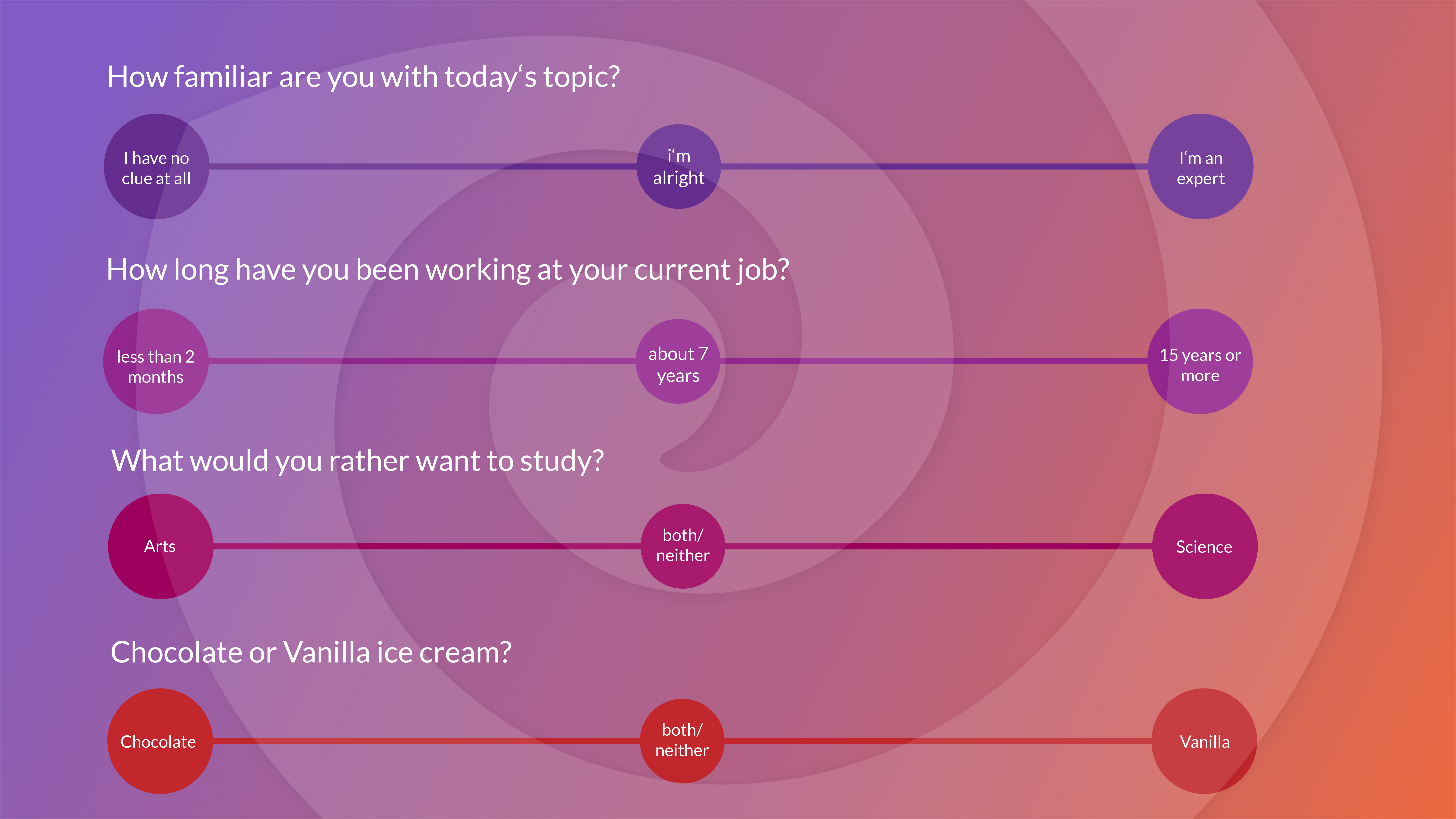
Attention – you can of course ask about political or more controversial topics, but that may escalate and turn into a fight, which is not the purpose of the game or your presentation.
8. Describe That
Let your audience draw from cards with words on them and then describe it for the other attendees. It is basically like charades, but with words instead of acting. Some may find that too easy. In that case, you can either choose terms that are extremely hard to describe or add some “Taboo-words” to the card that can’t be used for describing.

9. True and False
Have you ever heard a crazy, bizarre fact where you didn’t think that it could be true? Perfect. You can use it in the well-known “True and False”-Game. You pick out a fact (ideally something related to your presentation topic) and then let your audience vote (you know – via an interactive poll tool like SlideLizard ) if they think it’s true or not. A tip for making statements false: Change little things about the them, like numbers, dates or names or use common misconceptions and see how many of your attendees buy into them, e.g. “Bulls are enraged by the color red” (which is false, bulls are simply enraged by movement, not specific colors).

10. The never-ending sentence
The never-ending sentence is a great game that incorporates many of your attendees and awakens their brain cells. It is perfect for keeping up their engagement and interest, especially for long presentations or workshops when you feel like some people are getting a little tired. Simply start by saying a word – it can be related to the presentation’s topic if you want – and ask a person in your audience to repeat that word and add another one – the next person to repeat those two words and add another one as well , and so on, until a sentence forms. As it gets longer the game gets a lot more difficult, because there is a lot more to remember and to repeat. The sentence can’t be ended, it has to be continued until someone makes a mistake (or until the last person in the room has added a new word). We promise that you will be left with a lot of fun, creative, and straight-up weird sentences that will make your audience laugh a lot.

Related articles
About the author.

Pia Lehner-Mittermaier
Pia works in Marketing as a graphic designer and writer at SlideLizard. She uses her vivid imagination and creativity to produce good content.

Get 1 Month for free!
Do you want to make your presentations more interactive.
With SlideLizard you can engage your audience with live polls, questions and feedback . Directly within your PowerPoint Presentation. Learn more

Top blog articles More posts
Best Sources for free Icons to use in PowerPoint Presentations

How to highlight image area in PowerPoint

Get started with Live Polls, Q&A and slides
for your PowerPoint Presentations
The big SlideLizard presentation glossary
Visual communication.
If there are used images or videos for communication, it is visual communication. Visual Communication is almost used everywhere like on television, posts on social media (Instagram, Facebook), advertisement.
.odp file extension
.odp files are similar to .ppt files. It's a presentation which was created with Impress and contains slides with images, texts, effects and media.
Vocalized pause
A vocalized pause means the pause when the silence between words is filled by the speaker with vocalizations like "um", "uh" and "er".
Student Response System (SRS)
With Student Response Systems (SRS) it is possible to get live student feedback in the classroom. Questions and answers can usually be asked and given anonymously, which increases participation and engagement. An SRS may be used for any grade, including university.
Be the first to know!
The latest SlideLizard news, articles, and resources, sent straight to your inbox.
- or follow us on -
We use cookies to personalize content and analyze traffic to our website. You can choose to accept only cookies that are necessary for the website to function or to also allow tracking cookies. For more information, please see our privacy policy .
Cookie Settings
Necessary cookies are required for the proper functioning of the website. These cookies ensure basic functionalities and security features of the website.
Analytical cookies are used to understand how visitors interact with the website. These cookies help provide information about the number of visitors, etc.
- Skip to main content
- Skip to primary sidebar
- Skip to footer
- QuestionPro

- Solutions Industries Gaming Automotive Sports and events Education Government Travel & Hospitality Financial Services Healthcare Cannabis Technology Use Case AskWhy Communities Audience Contactless surveys Mobile LivePolls Member Experience GDPR Positive People Science 360 Feedback Surveys
- Resources Blog eBooks Survey Templates Case Studies Training Help center
Home LivePolls
15 Interactive Presentation Games to Engage Your Audience
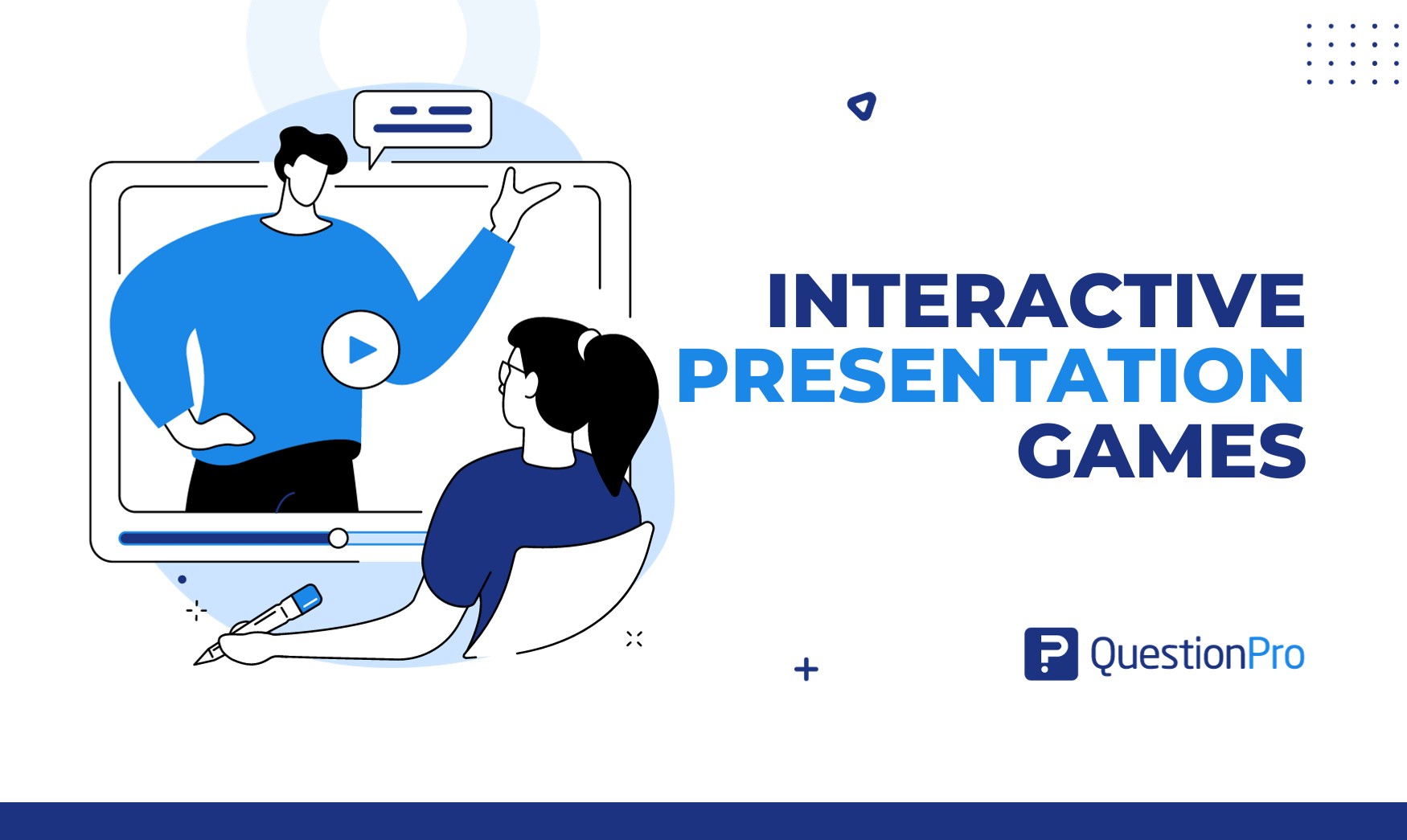
In the world of presentations and public speaking, engaging your audience is crucial. A captivating presentation can leave a lasting impact and ensure that your message is heard and retained. One effective way to achieve this engagement is by incorporating interactive presentation games into your talks.
Interactive presentation games break the monotony of traditional slideshows and transform passive listeners into active participants. In this blog, we’ll explore 15 interactive presentation games that can make your presentations more dynamic, memorable, and enjoyable for your audience.
Why Use Interactive Presentation Games?
Traditional presentations often involve passive listening, which can lead to disengagement and limited retention of information. On the other hand, interactive presentation games create an environment of active participation.
Making your presentations more memorable and impactful. They foster interaction, feedback, and collaboration, turning your audience into active participants rather than passive observers.
Benefits of Engaging Your Audience
Engaging your audience with interactive presentation games offers numerous benefits:
- Increased Engagement: Interactive presentation games grab your audience’s attention and keep them actively involved throughout the presentation.
- Improved Information Retention: Active participation enhances the retention of key information, ensuring that your message sticks with your audience long after the presentation is over.
- Enhanced Learning: Games encourage a deeper understanding of the subject matter, making it easier for your audience to grasp complex concepts.
- Better Audience Connection: By involving your audience, you establish a stronger connection, making them feel valued and heard.
- Immediate Feedback: Games provide opportunities for instant feedback, allowing you to address questions and concerns in real time.
- Fun and Entertainment: Interactive fun games add an element of fun and entertainment to your presentations, making them more enjoyable for your audience.
How to Choose the Right Presentation Games
Selecting the appropriate presentation games depends on your audience, topic, and objectives. Consider factors such as the size of your audience, the level of interactivity you desire, and the technology available. Tailor your choice of games to align with your presentation goals, ensuring they enhance your message rather than distract from it.
Now, let’s explore 15 interactive presentation games that you can incorporate into your presentations to engage your audience effectively:
01. Polling and Surveys
Polling and surveys involve asking questions to your audience and collecting their responses in real time. This game is useful for engaging the audience and gathering valuable data or opinions.
Example: During a marketing presentation, you can use polling to ask the audience which social media platform they use most frequently for product discovery, with response options like “Facebook,” “Instagram,” or “Twitter.” The results can guide your marketing strategy.
02. Quiz and Trivia
Quiz and trivia games challenge the audience’s knowledge of a specific subject. Correct-answer questions encourage competition and learning because participants’ scores are added up.
Example: In a history lecture, you can organize a trivia quiz about historical events. Ask questions like, “Who was the first President of the United States?” and award points for correct answers to make learning history engaging.
03. Interactive Q&A Sessions
Interactive Q&A sessions allow the audience to ask questions and engage in a live dialogue with the presenter. This interactive presentation game promotes engagement, clarification, and in-depth discussions.
Example: After a business strategy presentation, open the floor for an interactive Q&A session where the audience can ask questions about the proposed strategies, fostering a deeper understanding of the material.
04. Gamified Scenarios
Gamified scenarios present real-world situations or challenges to the audience. Participants make decisions, and the consequences of those choices are revealed, creating an immersive learning experience.
Example: In leadership training, simulate a business scenario where participants make decisions as managers. Their choices affect the company’s success, making the learning process engaging and interactive.
05. Virtual Reality and Augmented Reality Experiences
Virtual reality (VR) and augmented reality (AR) games provide immersive 3D experiences. Participants can explore virtual environments or interact with augmented elements.
Example: In a product launch presentation, use AR to allow the audience to visualize how the product would fit into their homes. They can use their smartphones to see a virtual presentation version of the product in their living rooms.
06. Storytelling Challenges
Storytelling challenges encourage participants to create and share their stories, fostering creativity and personal expression.
Example: In a team-building workshop, ask each participant to share a personal success story related to teamwork. This engages the audience and builds a sense of connection among participants.
07. Collaborative Whiteboard Activities
In real-time, collaborative whiteboard activities involve multiple participants contributing ideas, drawings, or annotations on a digital whiteboard. This game fosters teamwork and brainstorming.
Example: During a brainstorming session for a new project, use a digital whiteboard tool where team members can simultaneously sketch out their ideas and add comments. This promotes collaboration and idea generation.
08. Interactive Polls and Word Clouds
Interactive polls and word clouds engage the audience by having them vote or input keywords related to a topic. The results are displayed dynamically.
Example: In a conference PowerPoint presentation about technology trends, ask the audience to submit keywords related to the most exciting emerging technologies. Display the results in a word cloud to visualize the collective interest.
09. Simulations and Case Studies
Simulations and case studies replicate real-life scenarios for participants to make decisions and see the outcomes. This game is effective for practical learning.
Example: In a business strategy workshop, provide participants with a case study of a struggling company. Have them analyze the situation and propose strategies to turn the business around. The best solutions can be discussed as a group.
10. Role-Playing Exercises
Role-playing exercises involve participants taking on specific roles or characters to act out scenarios. This game promotes empathy and communication skills.
Example: In customer service training, participants can take on the roles of customers and service representatives. They act out various customer service scenarios to practice effective communication and problem-solving.
11. Breakout Rooms and Group Discussions
Breakout rooms and group discussions split the audience-focused audiences into smaller groups to discuss specific topics or tasks. This great game promotes active participation and in-depth exploration of ideas.
Example: In an educational webinar, use breakout rooms to divide participants into smaller groups. Each group discusses a different aspect of the topic and then shares their insights when they return to the main session.
12. Live Challenges and Competitions
Live challenges and competitions introduce competitive elements to the best presentation games. Participants can compete individually or in teams to solve problems or complete tasks.
Example: In a team-building event, organize a friendly competition where teams compete in a series of challenges. Challenges could include problem-solving tasks, physical activities, or trivia quizzes to foster teamwork and camaraderie.
13. Interactive Presentations
Interactive presentations incorporate multimedia elements, quizzes, and audience participation throughout the entire presentation screen to keep the audience engaged.
Example: During a product launch presentation, embed interactive elements such as polls, quizzes, and live demos within your slides. This ensures constant engagement and information retention.
14. Icebreakers and Energizers
Icebreakers and energizers are quick, fun activities designed to create a relaxed atmosphere and engage the audience at the beginning of a presentation or during breaks.
Example: At the start of a team meeting, use a fun icebreaker like “Two Truths and a Lie,” where each participant shares two true statements and one false one about themselves. It lightens the mood and promotes bonding.
15. Creative Challenges and Brain Teasers
Creative challenges and brain teasers stimulate creativity and problem-solving. They present puzzles, riddles, or creative tasks to engage the audience stand.
Example: During a creativity workshop, present participants with a riddle or a creative problem to solve as a group. Encourage them to think critically and come up with innovative solutions, fostering creative thinking.
How QuestioPro LivePolls can help in Interactive presentation games
When you use any tool for an interactive show, you need to think about how your audience votes and your presentation’s goals. Make sure the interactive elements enhance the learning or engagement experience rather than becoming a distraction.
Here are some ways a survey-based tool like QuestionPro can assist in creating interactive presentation games:
Question and Quiz Creation
Many interactive presentation game tools allow you to create questions and quizzes that you can integrate into your presentations. These questions can be multiple-choice, true/false, open-ended, or other formats. Participants can then respond to these questions during your presentation.
Interactive presentation fun game tools often include features that engage your audience. This can include things like timers for questions, leaderboards to display scores, and interactive survey elements that make your presentation more engaging and fun.
Feedback and Scoring
These tools typically provide instant feedback to participants. Correct answers might be rewarded with points, while explanations could follow incorrect answers. Scores are often tallied in real time, creating a competitive or gamified atmosphere.
Data Collection
Interactive presentation game tools can help you collect data on audience response software . This data can be valuable for assessing learning outcomes, understanding audience vote opinions, or tailoring your content to your audience’s preferences.
Customization
You can often customize the appearance and behavior of interactive elements to fit your presentation’s theme or style. This allows for creative and engaging presentations.
Audience Participation
Such tools enable audience members to actively participate and feel involved in your presentation. This can lead to higher engagement levels and better retention of information.
Reports and Analytics
Some tools provide analytics and reports after your presentation, which can help you assess the effectiveness of your interactive elements and the overall presentation.
Incorporating interactive presentation games into your talks can elevate your engagement, foster learning, and make your message more memorable. Whether you choose polls, quizzes, simulations, or storytelling challenges, tailoring the games to your audience and objectives is key.
By doing so, you’ll transform your presentations into dynamic and unforgettable experiences that leave a lasting impact on your audience. So, level up your presentations with these interactive games, and watch your audience become active participants in your message.
LEARN MORE CREATE FREE ACCOUNT
MORE LIKE THIS

Experimental vs Observational Studies: Differences & Examples
Sep 5, 2024

Interactive Forms: Key Features, Benefits, Uses + Design Tips
Sep 4, 2024

Closed-Loop Management: The Key to Customer Centricity
Sep 3, 2024

Net Trust Score: Tool for Measuring Trust in Organization
Sep 2, 2024
Other categories
- Academic Research
- Artificial Intelligence
- Assessments
- Brand Awareness
- Case Studies
- Communities
- Consumer Insights
- Customer effort score
- Customer Engagement
- Customer Experience
- Customer Loyalty
- Customer Research
- Customer Satisfaction
- Employee Benefits
- Employee Engagement
- Employee Retention
- Friday Five
- General Data Protection Regulation
- Insights Hub
- Life@QuestionPro
- Market Research
- Mobile diaries
- Mobile Surveys
- New Features
- Online Communities
- Question Types
- Questionnaire
- QuestionPro Products
- Release Notes
- Research Tools and Apps
- Revenue at Risk
- Survey Templates
- Training Tips
- Tuesday CX Thoughts (TCXT)
- Uncategorized
- What’s Coming Up
- Workforce Intelligence

20 Interactive Presentation Games
- Employee Engagement , Event Planning , Leadership Techniques

Meetings and conferences can be painfully tedious and dull. So much so that the phrase “Death by PowerPoint” has made it into our lexicon. According to Thomas Sowell , an American political economist and commentator, “People who enjoy meetings should not be in charge of anything.”
But if the problem with meetings is that they tend to be boring, the solution lies in finding ways to better engage and entertain your audience. You probably know the feeling of sitting in a meeting, trying to pay attention while one person drones on for an hour.
Even if the purpose of the meeting is to train, disseminate new developments, or even get everyone up to speed on weekly goals, engaging your audience creates a motivation to pay attention.
That’s why interactive presentation games are a great way to re-energizing meetings by involving audiences in the presentation. Interactive presentation turn passive listeners into active participants. Audience participation games also allow the attendees to learn new skills, think of solutions within a short time period, and solve problems together.
MeetingPulse’s audience participation tools equip your team with the tools and resources to create engaging events. With that in mind, here’s our guide to a few popular interactive presentation games.
20 Interactive Audience Participation Games
1. project jeopardy.

This game is designed to make the presentation of reports more fun and interactive. The lead person on the report creates cards that have answers from the report.
For example, the card reads “25%.” The rest of the team is supposed to ask the correct question corresponding to the “25%” answer on the card. The question could be something like, “What was the company revenue growth for the quarter?”
How to play: Give everyone the URL to your MeetingPulse meeting. Display the question on your screen and create multiple choice answers or leave it open-ended. The answers will pop up on the administrator’s screen in real-time, and you can share the answers to see how many people got it right.
2. Idea Box Game

The Idea Box game is excellent for brainstorming meetings where employees can share ideas about a project or product . It helps get the creative juices flowing and might even lead to some usable prototypes. Instead of having one speaker after another speak about their idea, having a team create an idea box creates a space for collaboration to further spark innovation.
How to play: Use the MeetingPulse brainstorming tool to have teams vote and collect feedback about the products. Have each attendee log in to your MeetingPulse link — a virtual Idea Box. Give small groups thirty minutes to brainstorm, then allow submissions.
At the end of the exercise, each team should have the product name, features and functions, marketing taglines, and other vital product details.
Once each team has completed their box they’re invited to share it with the rest of the team who finally vote for the best box. Their ideas will appear on the screen right away, and participants can upvote or downvote in Reddit-style fashion and even submit emoji reactions.
3. The Introduction Game

This game is ideal for a new group of team members meeting for the first time on a mutual project or new hires joining a team. Give the new hires a chance to introduce themselves in an unforgettable manner.
How to play: Ask the new members to bring a personal item or a favorite song. During the meeting, introduce them by letting their song blare for a few minutes on the sound system and then ask them to say something about themselves. If you’re using the personal item, ask them to talk about the item and what it means to them.
4. The talking stick

This activity makes sure that anyone who has a contribution not only gets to do so, but also that they get to speak uninterrupted. Using the talking stick is a great, rapid-fire way to focus the meeting on deep and meaningful contributions.
How to play: Form a circle and make sure everyone’s seated. Before the discussion begins, everyone should agree that the moderator has the power to choose whoever speaks next. Once a member finishes talking, they should put the stick back in the center for the next person.
Use the MeetingPulse audience feedback capability to gain insight right away. Choose up to four emojis and allow your audience to react as they listen to new ideas.
5. Telephone game

The telephone game is used typically as an ice breaker or to liven up a group after a couple of mind-numbing presentations. While it doesn’t really work with a very large group, a sizable number like 10 to 15 people is just right.
How to play: The meeting leader whispers the latest company marketing strategy used to the person on their left who is then supposed to relay the message to the next person and on and on until the last person gets the message.
The last person then gets to tell the rest of the team the final message, and you can compare it to the primary message from the lead.
6. The trivia competition

You can use this game to test the attendees’ trivia knowledge of the company or of general business trends . Create a trivia competition where the members play for points and the winner gets a prize. Project the points for everyone to see the winner.
How to play: Formulate questions related to the company and use them for the trivia test. You can use MeetingPulse to create the questions with its live Q&A session software platform capabilities , and set the timer to begin the game together. To add an extra touch of fun, include images with your multiple choice questions. Visuals add to the level of engagement and give your meetings an extra edge.

7. Fill in the phrase

Check out Meeting Pulse for Cool and creative ways to make polling questions and Quizzes!
This game requires participants to fill in blanks on a survey or report. The survey or report should not be complete until the end of the presentation. This game rewards audiences for listening, and you can even provide some sort of prize.
How to play: Create a report for attendees that has blanks. As you continue with the presentation, invite them to fill in the blanks from the information you are giving. Not only does the audience remain engaged, but they retain crucial information better.
MeetingPulse integrates with Powerpoints , so you can use our single answer polling feature to play this game and display the results directly in your PowerPoint presentation.
8. Word of the day

Have a word of the day game as part of your presentation or meeting. It can be a phrase or a word.
How to play: The presenter should weave the word or phrase into their presentation and the audience acknowledges its use by shouting back. The word must come from the team and not the presenter. This activity keeps everyone alert. Sometimes shouting can be distracting in the middle of a meeting.
In this case, use the MeetingPulse emoji feature, and everyone can submit ? when you use the word “key learnings.”
9. The 20 questions game

You get 20 questions to help you identify a picture that you can’t see, but the audience can. The audience can only lead you with yes or no questions. Use this game to liven up the audience.
How to play: The audience will choose a picture that you can’t see. Have someone submit a photo and display it on the MeetingPulse user dashboard. Get blindfolded and begin to ask questions regarding the picture. You get only twenty questions to get it right.
If you’re an advertising agency, you can use this test your employees’ memory and see if they remember what you worked on. To keep track of all the questions and responses, have the audience choose “yes” or “no” by using a live audience polling tool instead of having them shout it out.
10. Call and response

This game keeps the audience focused. The leader in the meeting calls out a phrase randomly during their presentation and the audience responds to it .
How to play: Agree on the action to be taken every time the phrase is called out. The second the presenter calls out the word, your audience can dance, clap or just rise and seat. Alternatively, they can respond with a phrase, word, or an emoji using MeetingPulse.
11. What would I have done?
In this game, ask each member of the team what their alternative career would be. The point of the game is to open up to each other and foster conversation.
How to play: Each member writes down their alternative career and waits their turn to reveal. The audience collectively asks “What would you have done?” and the selected member responds explaining why they chose that alternative. This is another great game you can play virtually, especially if you’re working with a big team.
With MeetingPulse , you can find out everyone’s alternative career and even get some statistics.
12. Fabulous flags

In this game , team members draw things that matter to them on their flag. This is known as the personal flag game, and it’s an excellent ice breaker activity.
How to play: Everyone gets 10 minutes to draw objects or symbols that represent something meaningful in their lives. Each person gets two minutes to explain the items on their flag.

13. Botticelli

Similar to 20 questions, this game also tests your trivia. You keep in mind a person, place, or thing, and the audience has to guess. The game is a bit more complex because the player can talk back to the audience and distract them from the name.
How to play: The audience asks leading questions to which the player responds with a yes or no. If they ask a specific question like “Does the celebrity’s name start with B?” then the player can respond with “It’s not Brad Pitt.”
This game is logistically easy to plan because all you need to do is formulate the poll questions and integrate them into your PowerPoint with MeetingPulse .
14. Candy introductions

This is a game that allows people to get to know each other while enjoying some sweet treats. It’s excellent for training sessions where participants are complete strangers, providing general topics for introductions that employees can elaborate upon further.
How to play: The participants choose different types of candy from a bag and use each to represent different topics about themselves during the introduction. They can talk about family, career, hobbies, unexpected characteristic and dream destinations.
15. Crazy job interview

In this game, one participant tries to convince the others why they would be the best for a certain job. They have to expound on qualities given by another player and how those qualities make them a good fit.
How to play: The participant is given a career, like a supermodel. Then they are given random phrases like “angry with the queen” or “intellectually incompatible” and they have to use these phrases to explain why they would be great at being a supermodel.
16. The elimination game

The elimination game helps participants to get to know each other, using a series of questions to find out the most common and most rare similarities amongst people within your company.
How to play: The whole room is asked to stand up. The leader then asks elimination questions like “how many are attending this conference for the first time?” That group gets to sit down. The next is “remain standing if this is your fourth consecutive attendance.” The rest of the group sits down. And the elimination questions continue.
17. Would you rather

This is a fun game to liven up the room, giving participants two choices of something they can do. They have to choose the lesser evil.
How to play: The player is given a question with two very bad or very good outcomes. For example, if the employees are afraid of heights, ask, “Would you rather go sky diving or bungee jumping?”
If you want to play this game with a large group of people, you can use MeetingPulse to get answers in real time. This game can also provide valuable insight for you. For instance, you can ask, “Would you rather have a breakfast spread or small desserts for our next meeting?”
18. Anagrams
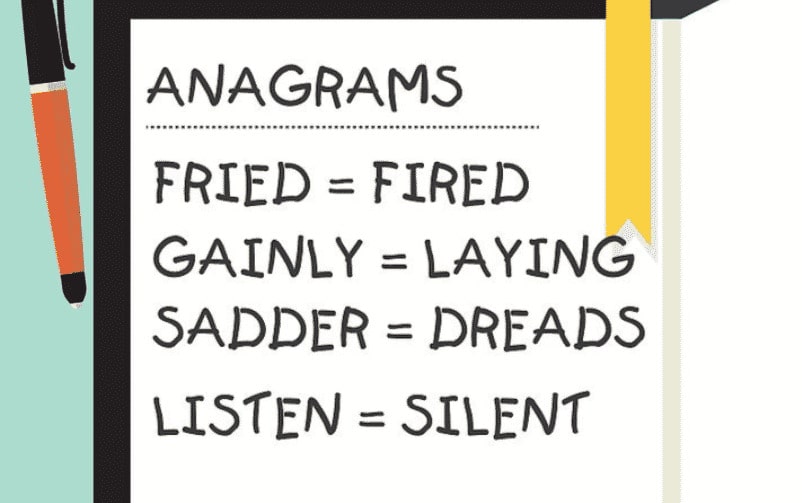
Think up a word and have everyone else try to figure it out. Expect some hilarious answers as everyone chips in.
How to play: Jumble up the letters but ensure that they create a five or six letter word anagram when correctly aligned. Only the presenter should suggest the word, and the activity should be timed. People can submit their answers live on MeetingPulse .
19. Two truths and a lie

The players get to tell two truths and one lie about themselves and the audience deciphers which one is the lie.
How to play: The player chooses a topic, like “career.” They tell two real facts about their career and one lie. The audience then decides which statement is false and why they believe that.
20. Choose the Agenda

In this activity, the participants choose the agenda of the meeting instead of being told what it is. This allow them to address burning issues.
How to play: Participants are invited to submit their agendas, which are shared by everyone and then voted on. The one with the most votes becomes the main agenda for the meeting. This gives participants control over the meeting as well.
You can use MeetingPulse’s brainstorming tool with the upvoting feature for this!
Final Thoughts
Now that you know some of the best interactive presentation games, you’re ready to host your next event with new and creative ways to keep your audience engaged. MeetingPulse is a great tool and resource for you to make your presentations more memorable and — dare we say it — fun.
Related: 25 Fun Poll Questions to Ask Your Audience
Get started with MeetingPulse today!
Share this article on your socials, latest posts.

Boosting Audience Engagement with Interactive Presentation Tools

Enhancing Employee Engagement with Interactive Meeting Software
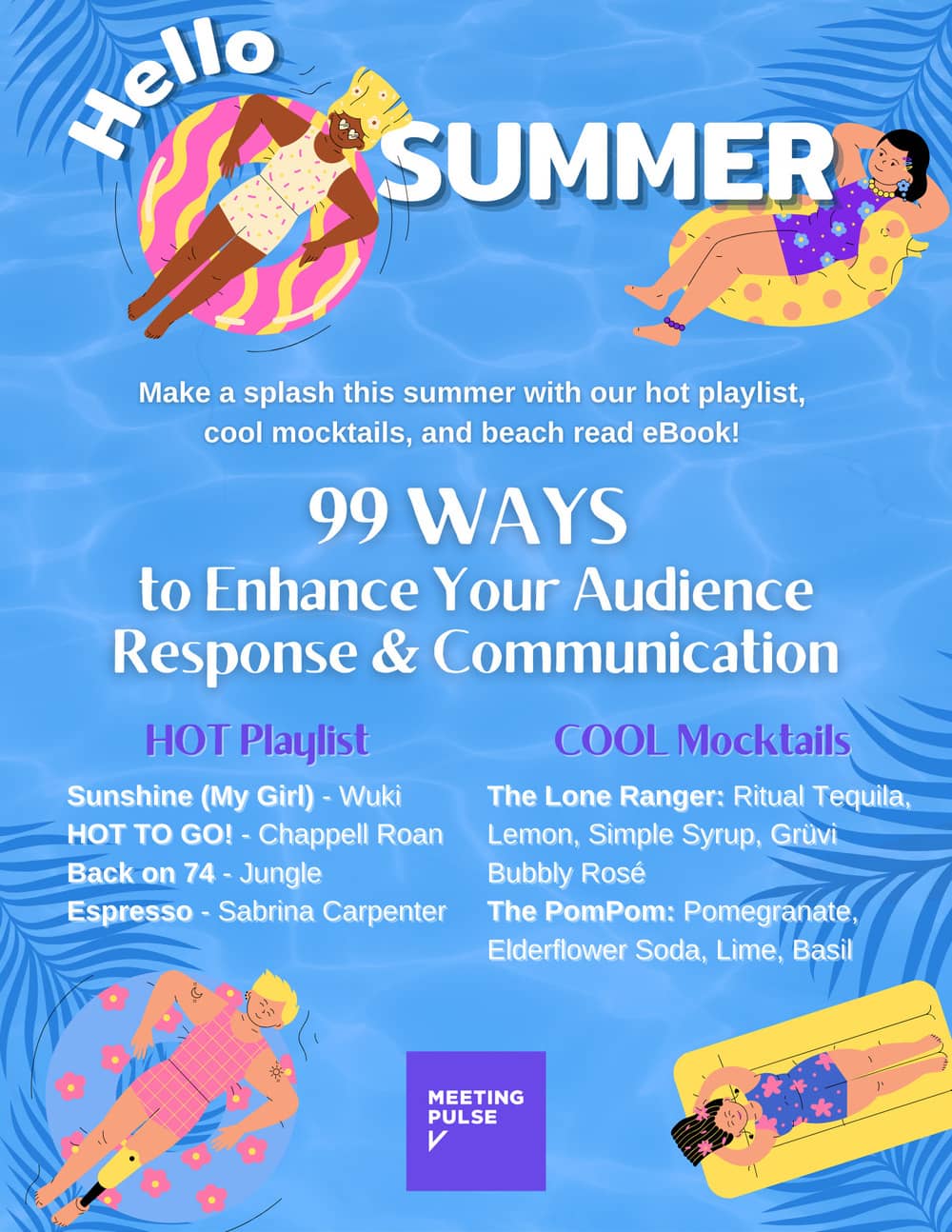
Cool Ideas for Your Hot Summer

The Benefits of Language-Inclusive Meetings and Events
Blog categories.
- Audience Response Tools
- Best Practices
- Employee Engagement
- Event Planning
- Hybrid Events
- Leadership Techniques
- Meeting Prep
- Organizational Development
- Uncategorized

To make MeetingPulse a seamless addition to your meetings, we offer custom themes. You can use your own logo and your colors in Attendee View as well as Broadcast View. Your company name can also be included in the webpage’s title. Your meeting can also have its own domain. This is great if you are going to promote your meeting offline. For example, you could use “acme2022.com” instead of “meet.ps/acme-all-hands”.

Live Product Tours
Weekly Product Tour Every Wednesday

- Success Stories
- Integrations
- Help Center
- Cvent Marketplace
- Connect with Zapier
- Trust Center
- System Status
- MeetingPulse User Reviews

50+ PowerPoint Game Ideas for Interactive & Engaging Presentations
Last updated on May 8th, 2024

In the ever-evolving world of presentation tools, PowerPoint remains a versatile mainstay. While most of us associate it with business meetings or academic lectures, it’s worth noting that its capabilities stretch far beyond. From engaging classroom activities to lively party games, PowerPoint offers a plethora of interactive opportunities. Dive into this curated list of popular games you can craft using PowerPoint, and discover how to transform this presentation platform into an entertaining gaming console.
Benefits of using Games in PowerPoint Presentations?
Games are not just a source of entertainment; they are a potent tool for fostering engagement, boosting retention, and breaking the monotony of standard presentations.
In business, using PowerPoint games can invigorate team meetings, encourage participation in training sessions, and enhance the assimilation of complex data, making information dissemination more impactful.
For the classroom setting, PowerPoint games pave the way for an interactive learning environment, where students are motivated to participate actively. It aids in the comprehension of challenging concepts, fosters a competitive yet collaborative spirit, and ensures that learning is not just effective but enjoyable.
Leveraging the power of games in PowerPoint presentations is thus a strategic move, transforming the traditional slide-based discourse into an interactive experience for both corporate and educational realms.
In this article, we will present some game ideas that you can implement in PowerPoint, either by using pre-defined Game templates or creating your own interactive PowerPoint games. Let’s see some ideas below, as well as a quick description on how you can create the game using PowerPoint slides or download pre-existing free PowerPoint templates with games .
1. Family Feud PowerPoint Game
Family Feud is a quiz game where contestants guess the most popular answers to survey questions.
To create this game in PowerPoint, design slides with the questions and use animations to reveal the answers as players guess. Organize the answers in a descending order of popularity, revealing the most popular answers last for dramatic effect. Color coding and use of sound effects can enhance the experience. You can download this free Family Feud PowerPoint template .

2. Jeopardy PowerPoint Game
Jeopardy is a classic quiz game featuring categories and increasing point values.
To create a Jeopardy Game in PowerPoint, begin by crafting a grid of point values on a master slide. Each value should link to a separate question slide. Use hyperlinks for seamless navigation. After answering, guide the user back to the main grid. To track answered questions, you might consider changing the color or appearance of clicked values.
Check out this animated Jeopardy PowerPoint Template in case you are interested in learning how to make a Jeopardy game on PowerPoint.
3. Who Wants to Be a Millionaire PowerPoint Template Game
Who Wants to Be a Millionaire is a high-stakes quiz game with questions of increasing difficulty and lifelines.
To create a Who Wants to Be a Millionaire game in PowerPoint, create a series of slides with questions and multiple-choice answers. Use animations and slide transitions for lifelines, such as “50:50,” revealing the correct answer or polling the audience. Include dramatic sound effects and visual cues for milestones in prize money.

4. Wheel of Fortune Game for PowerPoint
The Wheel of Fortune is a word puzzle game, Wheel of Fortune sees players guessing letters to complete a phrase.
To create this game as a PPT presentation, you can use text boxes in PowerPoint for the puzzle, and animations to reveal letters as they’re guessed. You can also use editable puzzle templates to form the different shapes and layouts. Consider incorporating a spinning wheel animation or image for added effect. Sound effects can be used when letters are guessed correctly or incorrectly.

5. Bingo Game for PowerPoint
Bingo involves players marking off numbers on a card as they’re randomly drawn.
To create a Bingo Game in PowerPpoint, prepare Bingo cards and design slides that randomly display numbers. To ensure randomness, consider using a number generator and manually progressing through slides.
6. Memory Match Game in PowerPoint
Memory Match game is a card-matching game. Memory Match requires players to flip two cards to find pairs.
Using PowerPoint, design slides with hidden images or text that appear upon click. Ensure two of each item for pairing. Create a grid layout in PowerPoint, and use PowerPoint animations to simulate the card “flip” effect when clicked.
7. Trivia Quiz Game in PowerPoint
In Trivia Quiz, players answer a variety of multiple-choice or true/false questions.
Design your PowerPoint slides with a question on top, followed by clickable answers below. Using slide transitions, provide immediate feedback for correct or incorrect answers. Consider incorporating a scoring system or timer for added challenge. If you don’t want to create a quiz from scratch, you may use a free Quiz PowerPoint template design , or a free Trivia PowerPoint template , with pre-defined slides prepared for a Quiz or Trivia game. Alternatively, you can check the quiz maker tools .
8. Hangman PowerPoint Game
Hangman is a word-guessing game. Incorrect guesses lead to drawing parts of a hangman figure.
For this game in PowerPoint, you can create a new PowerPoint presentation and use text boxes for the mystery word. Then, add shapes for the hangman drawing, revealing parts incrementally with each wrong guess. The game concludes when the word is guessed or the hangman is fully drawn. You can also leverage this presentation by applying animations.
9. Pictionary PowerPoint Game
Pictionary is about guessing a word based on a drawing.
In PowerPoint, you can create a Pictionary game that displays a hint or a drawn representation of the word on a slide. When presenting the slideshow, players then guess what the word is based on the visual. This can be made interactive by using drawing tools in real-time, if the platform allows.
10. Price is Right in PowerPoint
In this game, players estimate the price of various items.
To create a Price is Right PPT presentation, you can showcase images of items on your PowerPoint slides and have players guess their price. Once guesses are made, reveal the actual cost. This can be done using PowerPoint animations (first the cost is hidden, and then when revealed you use a Fade effect or any other animation under the Appear section). To add more dynamics, use animations to simulate the spinning wheel or other mini-games from the show.
The Big List of Other Interactive PowerPoint Games for Engaging Presentations
Here are 40+ interactive PowerPoint games that you can incorporate into your presentations for engaging presentations.
Conclusions
PowerPoint proves time and again that it’s more than just a tool for slideshows; it’s a canvas for creativity. By thinking outside the box, we can leverage its features to create engaging and interactive games suitable for various settings. Whether you’re an educator aiming to make lessons more captivating or someone looking to add a fun twist to a gathering, these PowerPoint games offer an innovative way to engage and entertain. So, the next time you open up PowerPoint, challenge yourself to see it not just as a presentation tool, but as a gateway to interactive fun.
Leave a Comment Cancel reply
Your email address will not be published. Required fields are marked *
Save my name, email, and website in this browser for the next time I comment.
Sign up to our newsletter
We will send you our curated collections to your email weekly. No spam, promise!

Awake and interested: 21 Interactive presentation games

Have you ever worked hard on an important presentation, only to look out at the audience and see that they’re barely awake?
Don’t take it personally. It’s hard to get talked at for a period of time, especially if it’s been a long day already. That’s why experienced presenters often come to the table with interactive presentation ideas. These interactive presentation games will add a little extra fun to an otherwise straightforward presentation, and might be just what you need to keep your audience awake and interested.
Let’s face it: public speaking and presenting is rarely anyone’s favorite activity. Fearing that your audience isn’t engaged or is drifting off to sleep only makes things worse. Get creative with some interactive presentation games to engage your audience, keep them interested, and help them to actually retain the important information you’re sharing.
21 Interactive presentation games
These ideas are great for any kind of event - from a sales kickoff meeting to a work retreat . If you are planning a seminar or industry event, consider some of these options as additions to conference activities that attendees love.
1. Live trivia
A trivia competition is a safe and easy way to get people engaged and involved in the information. You can start your session with a trivia quiz based on any topic, or you can pause periodically and share trivia questions based on what you’ve presented already. For example, if you are presenting at a certain conference, you might choose questions that deal with the subject matter of the event. It’s pretty much fail-safe to pick some simple trivia questions to get everyone chatting at the beginning of your presentation, and if you want to create a competition you can break everyone up into small teams to see who knows the most. Tip: If you go the competition route, people will always be more engaged if there’s a prize involved.
2. Presentation singalong
This is a silly idea that’s sure to infuse your presentation with some fun and laughs. Start by choosing a popular song with a melody that will be easy for most people to pick up on. Then write down the lyrics, and swap some of the words out with concepts from your presentation. Essentially, you’ll keep the beat but change the words to items from your talk. Then create a slide to share during your presentation and “teach” everyone the song. People will be singing along and likely remember your presentation all day! You’ll want to know your audience fairly well for this one; not everyone likes singing in public and some people will only feel embarrassed, not entertained. For people who are comfortable laughing at themselves, it’s a winner!
3. 20 questions
This is a simple and classic question game that doesn’t require any preparation or investment. You can be the subject and the people you’re presenting to can help you to answer. Choose someone from the audience and have them write down or draw something on the board behind you. Then, ask the audience a series of questions to get to the answer of the mystery item. The game traditionally allows yes or no questions rather than open-ended ones. For example, “Is the item an animal?” or “Is the item bigger than my fist?” You might try to have them keep the answer relevant to your presentation, but that can be tough depending on the subject matter. If you go that route, try to make the game a mid-session break, where they focus on something from your presentation so far.
4. Same-room scavenger hunt
For a twist on a classic game (that doesn’t require leaving the presentation room), put together a scavenger hunt full of items that people will either have on themselves, or ask other attendees for. Things like a certain style of pen, a diet coke, a cellphone photo of a famous landmark, a green hairband, etc. Try to choose things that people will have in their bag or on their person - but pick a few things that they’ll likely have to ask around for. That way they can move about the room a little bit, as well as strike up conversation with others. You might be surprised how much people are able to grab without having to leave the room! Set aside a few prizes for the winners, and bonus points for people who get extra resourceful.
5. Show and tell
This game can serve as a sort of icebreaker and is ideal for smaller groups , or groups who don’t know each other well. It requires a little preparation, as before the event you’ll ask everyone to bring an item such as a favorite song or beloved photo - anything that tells a bit about what matters to them. Then, before your presentation begins, have everyone introduce themselves and explain why they brought the item they chose. Have your technology lined up in advance, so that if it’s a photo, you’re able to enlarge it on a screen, or if it’s a song, it can be played. This is a great way to learn more about your fellow attendees and find commonalities that can form friendships.
6. Periodic poll questions
Break up a lengthy presentation by having people share their opinions. Throughout your presentation, place a few polls or surveys that people can take informally. You can keep things simple by just having members raise their hands for their chosen option, or you can download an app so that you can collect responses in real-time. Try to make the topics pertinent to your presentation, and choose questions that are engaging and likely to have different opinions. You don’t want to choose questions where the answer will be obvious; that doesn’t lead to great conversation - which is your goal.
7. True or false game
This activity is another one that allows people to move and stretch, which can be really beneficial during long or dry presentations. Prepare some slides in advance with one statement per slide. The statements can be just for fun, like about pop culture, or about the subject matter of your presentation (this is a good way to see who is paying attention). The key is that some should be true and some should be false. Think of it like a true or false quiz based on the information you’ve shared. Have the entire audience stand up, and then display the slides one-by-one. Tell them to stay standing if they believe the statement is (rightfully) true, and sit down if they believe it’s false. After each round, say whether the comment was true or false. Anyone who was wrong must now sit down permanently. Continue this process until only one person is left standing as the winner.
8. Controversial questions
A bit of light-hearted controversy is a good way to get people engaged and to get conversation flowing. Energize your group with some questions that will spark debate. Obviously, you don’t want to create discomfort or irritation, so it’s good to avoid topics like politics, religion, current world events, etc. Keep questions on the fun side like “Mountains or beach - and why?” or “Coffee is overrated - yes or no.” Have everyone decide which side of the debate they are on and then join their “teammates”. Have the groups debate and see if anyone ends up changing their mind.
9. Word of the day
If you want to ensure people pay more attention to your talk, start things off with a word of the day. This is particularly effective if you are doing a multi-day engagement and can change the word each day. At the beginning, tell everyone what the word of the day is. Then make sure it’s interspersed throughout your presentation. Have everyone keep a tally of how many times the word was mentioned, and whoever gets the right number wins.
10. Process of elimination
This activity is simple, yet fun, and can help people get to know each other as well. You can choose to kick off your presentation with it, or use it as a break part way through your presentation. It requires a little preparation; before your event come up with a list of “yes or no” questions. On the day of, have everyone begin by standing up. Then ask each question one by one, and have people continue standing if their answer is yes, and sit down if their answer is no. If you want to thin the crowd earlier and make the game move faster, try suggesting scenarios instead of a question. For example, “Stay standing if you have ever seen a reindeer in real life”. Eventually you will get down to one person, who can be crowned the winner.
11. Large group icebreakers
Not all icebreakers are the same. Some are great for meeting new people and interacting with the person next to you; others are good for getting an entire group engaged. Research icebreakers designed for large groups (our blog is a great place to start).
12. Interactive Q & A session
An activity that’s actually really valuable to your attendees is a live question and answer session. This way they can learn more about what you’ve presented and gain a deeper knowledge. Plus, more outspoken people tend to ask questions that everyone is thinking, so it can be really helpful for everyone present. Let everyone know that at the end of your speaking portion you’ll leave time for questions. Make sure to allot about 20 minutes or more and encourage people to share any questions they have, letting them know you’ll answer to the best of your ability.
13. Business case study
Simulations and case-studies represent real-life scenarios that people must solve. This can be an interesting and educational activity for people who are at an industry conference or other learning-style event, particularly with a business focus. To encourage really practical learning, try providing participants with a case study about a struggling company. Participants should analyze the situation and come up with a few suggestions for turning things around. Have everyone share their insights and then dive deeper into the best ideas from the group.
14. Storytelling challenge
If you want to focus on fostering creativity and personal expression, try a storytelling challenge where everyone must create and share a story. For example, if you are hosting a team-building workshop , have each individual talk about a time they were part of a really effective team. What made them successful and what can other people take away from their story? This also helps to build a sense of connection among the audience.
15. Collaborative whiteboard
This real-time activity involves having everyone present work together to contribute ideas, drawings, or annotations to a white board. It can really add an element of teamwork and brainstorming which can be powerful. If coming up with suggestions is part of your event, try having a large whiteboard and allowing people to come up and add their thoughts one by one. You can also use a digital white board tool to keep things a bit cleaner. Then share the ideas generated and consider giving people a few minutes to write down all of the results.
16. Role-playing exercise
To promote empathy and communication skills, try coming up with role-playing games where participants will take on different roles or act as characters in various scenarios. For example, if you want to do customer service training, you might have one person play the role of a customer service representative and another of the role of a difficult customer. Allow them to act out various scenarios to practice problem-solving .
17. Breakout tables
If you are presenting to a larger audience, why not try breaking them up into smaller groups to facilitate more discussions on specific topics or tasks? This is a good way to facilitate teamwork, collaboration, and a deeper dive into topic exploration. If the space allows, you can have separate breakout rooms instead of just tables. In a smaller space, divide the room with tables at the four corners so each group has room to speak comfortably without disturbing the other groups.
18. Brain teaser
Flexing creative muscles and problem-solving are always welcome skills, no matter what the subject matter is. Come up with some challenges or brain teasers to present to your group (or smaller groups if presenting to a larger audience). Puzzles , riddles , creative tasks, or critical thinking exercises are all welcome additions that will get people moving, chatting, and thinking. Try some of these guessing games for extra fun.
19. Interactive quiz
Want to see how much people are paying attention? Why not spring a pop quiz on them, just like in high school? We are only partly kidding. If you are presenting during a particularly long day, or on a complex topic, take periodic breaks and toss out a few quiz questions. This is especially valuable if you announce at the beginning of your presentation that you’ll be sharing some quiz questions throughout the day - then people know they need to pay attention. Pick a few key points from your talk and ask some fairly simple questions that the audience can answer.
20. Topic of the day
If you are part of a multi-day event covering a variety of topics, you’ll get better engagement if your audience can help direct the material. Let them know in advance that you are going to keep your presentation fluid and reserve the last 20 minutes (or whatever amount of time makes sense) for a discussion on a topic of their choice. At this time, ask your audience what they want to learn more about. This is a great idea for events that last more than one day because you can build on what you previously shared. For example, if you present on Topic A on Monday, and Topic B Tuesday, ask your group on Tuesday if they would rather dive deeper into Topic A or if they want to spend more time on Topic B. Leaving it up to them will ensure they find real value in whatever is discussed.
21. Partner assignment
For a business-focused conference, networking and meeting other professionals is part of the appeal. Kick things off well by having everyone pair up with someone they don’t know. Then assign a simple exercise where they need to work together. For example, task them with coming up with a new name for a traditional product. They’ll get to work on communication and critical thinking skills while building a bond with someone in the same industry.
Make your all-company meeting complete
Anytime that you can bring your entire group together for a team meeting or all-hands event, you have the opportunity to insert a little fun. Try some of these ideas during your next team building retreat or even when you just need some quick team-building ideas.
If you need help in figuring out the flow, and how to plan an event that all of your attendees will be talking about for years, reach out to Surf Office for expert event advice .

free course
How to plan your first company retreat

Retreat Budget Spreadsheet
Are you organising a company retreat and want to make sure you have all the costs under the control?
Get a copy of our free Budget Calculator spreadsheet.

99 Icebreaker questions about food for fun teambuilding

160 One must go questions for every working environment!

Scout out your future-leaders with 20 leadership icebreakers

37 Fun Zoom icebreaker games for virtual meetings

29 Watercooler talk topics + Do’s and Don’ts!
Organize your next company retreat with surf office, 💌 join 18,000+ managers receiving insights on building company culture that people love., stay in touch, work with us.
10 Interactive Presentation Games for Students

“Welcome to Panel Island, one of my favorite sessions of all time. Not because I get to vote nice people off, but because you get to vote nice people off.” – Mark Fordham, iMeet Central
Four experts. Three rounds. One survivor. That was the wrinkle Mark Fordham, VP of Customer Success at iMeet Central, added to his company’s recurring panel discussions .
Each panelist answers specific questions related to his or her field. Then the audience votes for their favorite responses. The panelist with the fewest votes is voted off the “island.”
Discussions continue until only one panelist remains. Poll Everywhere handles the voting. Between talks, the audience selects their favorite speaker using their mobile devices, and the results appear in an animated chart in real time.
This is just one of many ways presenters and educators use interactive presentation games to keep the audience engaged. Here are eight more ideas for your next class, workshop, or meeting.
1. Process of elimination
This presentation game for 10 or more players helps the audience get to know each other

This game provides valuable insights into your audience members while also giving them a chance to stretch their legs.
Here’s how it works: Have everybody in your audience stand up. You’ll then pose prompts one at a time. Attendees’ responses to those prompts will dictate whether they stand or sit.
For example, let’s say that you’re speaking in a large auditorium-style classroom. Once your whole class is on their feet, you’d start by saying something like, “Sit down if this is your first time in this building.”
From there, you could keep thinning your students by saying, “Stay standing if you’ve had more than one class in this room,” and so on and so forth until only a few people – or only one person – remain on their feet. At that point, you could offer a prize or a round of applause.
2. Two truths and a lie
Welcome new students, or reintroduce old ones, with this presentation game

This classic icebreaker game works great with a recent Poll Everywhere addition: instruction image . Now you can present a photo alongside that person’s two truths and a lie so everyone knows exactly who they’re voting on.
Here’s how it works: create a new Multiple Choice activity in Poll Everywhere. Enter the participant’s name as the title, and two truths and a lie as the responses. Select the checkmarks next to the two truths to do a big reveal after voting ends.
After you create this activity, add an instruction image depicting the person you’re talking about. Be sure to check the box next to ‘Show instructions image on bar chart’ so the image is always visible.
In the image above, you can see that I changed the bar chart to a column chart. This improves readability on the presentation screen since the text isn’t sandwiched between the chart and image. Try to make your two truths and lies as short as possible. Shorter responses are always easier to read in the chart.
3. Telephone
See just how jumbled a phrase can get when it’s passed one-by-one around the room

Do you remember the game of telephone that you played as a kid? It’s just as fun as an adult.
Here’s how it works: Telephone starts by whispering a sentence into someone’s ear. Then that person repeats what you said to the person next to them. The chain continues on until the final person states aloud what they heard. It’s often something totally different from the original — with hilarious results.
You can use this in your presentation in an educational way by starting with a question that the audience wants to know (i.e. “How did Company XYZ increase their sales by 45%?”). Then, whisper the answer to the first person. Make sure to speak in a complete sentence — rather than just a few words — to make it tougher for your participants.
Even though you started the chain by whispering, “Company XYZ used content marketing to engage prospects,” you’re sure to end up with something quite ridiculous by the end.
A little advice: If you want to make this game go faster, you can do this by individual audience rows, instead of involving the whole room. It can also be fun to compare the different end results. Just know that the more people you have involved, the more twisted (and funny) the result becomes.
Read more: 20 staff meeting ideas that keep employees alert and engaged
4. Riddle me this
Wake up the audience with a brain-teaser, then reveal everyone’s responses at once
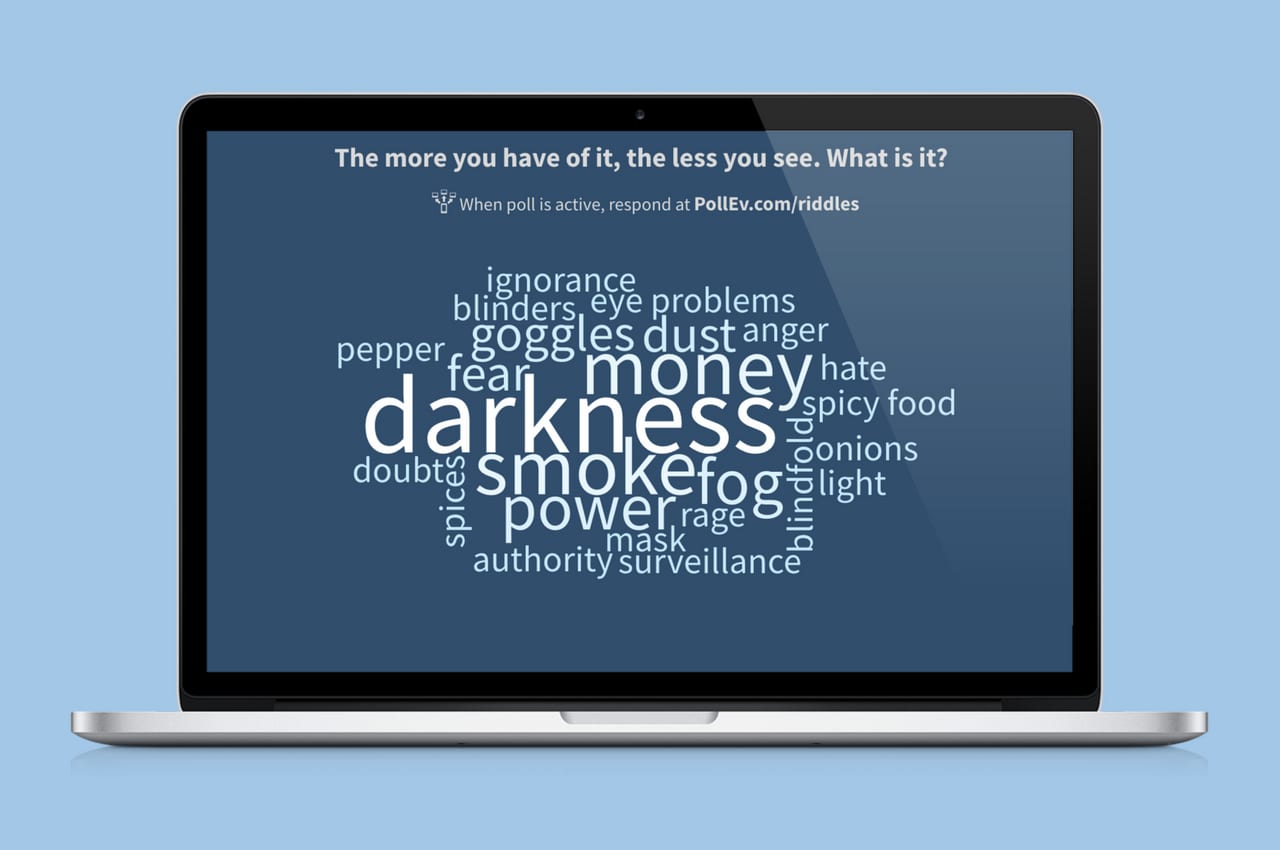
Riddles are a natural fit for Poll Everywhere word clouds . This activity transforms audience responses into a colorful, animated word cloud. Repeated words grow larger within the cloud.
Here’s how it works: create a new word cloud activity. Make the title a riddle that has a single-word answer (not a sentence or a list). Create the activity, and on the following screen locate the ‘Show results’ button. Click it so that a picture of two phones appears. Wait until everyone has responded to your riddle, then click ‘Show results’ again to reveal the finished word cloud. If the correct answer is the largest word in the cloud, that means most of the audience got it right.
By hiding the results and revealing them after everyone has voted, you prevent participants from submitting whatever seems like the most popular answer. When the results are hidden, there is a small counter in the lower left that shows you how many have responded. That way, you know when voting is finished.
5. 20 questions
Deduce a hidden image or photo by flying through 20 yes-or-no questions with the audience

Who doesn’t love a good game of 20 questions? Fortunately, it’s incredibly easy to play with your presentation audience.
Here’s how it works: display a word or picture (it could be anything from a celebrity to an animal) on the screen behind you — so that you can’t see it but the audience can. You can even ask someone to blindfold you if you don’t want to run the risk of cheating.
Now, your entire audience can see what’s on the screen, and it’s up to you to ask twenty “yes or no” questions that will help you guess exactly what’s being displayed.
Invite audience members to just yell out their answers to your questions simultaneously to create a lively game that’s sure to give your audience’s enthusiasm a boost. Double down on this by setting a 60-second timer for the questions. When time runs out, it’s time to guess.
6. Would you rather?
Learn how the audience thinks with a tricky “Would you rather?” scenario that divides the group

This presentation game is more of a conversation-starter than a traditional game. There should never be a right or wrong answer in a “Would you rather?” scenario. The winner is whoever best justifies their choice and why it’s the best one for them.
Here’s how it works: create a new multiple choice activity. Begin the title with “Would you rather…” and enter the two responses as the two scenarios. After you create this activity, locate the ‘ Visual settings ‘ button. Select it, then locate ‘ Donut chart ‘ and select that too. Doing so changes the look of your activity from a bar chart to a donut chart. Donuts are a great way to visualize the audience’s preference between two choices clearly.
To take this game a step further, start a discussion after the voting ends. Ask everyone who voted for one option to raise their hands. Then, go around the room and ask people to explain in a few words why they selected one option over the other. Save and email a copy of the donut chart afterwards as a memento.
7. Anagrams
Challenge the audience to come up with a unique solution to your anagram that on one else will guess

The crux of this presentation game is solving an anagram: a jumble of letters that can be rearranged into many different words. This is a fun mental exercise for the audience, doubly so if you’re breaking up multiple, back-to-back presentations.
Here’s how it works: create a Poll Everywhere word cloud . Select an anagram that’s at least five or six characters long, such as the one above, so that the audience has plenty of possibilities. If you want to give this a competitive edge, challenge the audience to submit words no one else will think of. These words appear as the smallest words in the cloud. If you do this, be sure to hide responses while everyone responds. Otherwise participants will copy each other’s responses.
For added fun, set the number of submissions to unlimited. Doing so rewards players for coming up with multiple unique words (thereby increasing their chances of winning) or by strategically submitting the same word multiple times to inflate its size in the cloud. You can see who submitted what on the activity’s response history page .
8. Trivia competition
Quiz the audience with multiple choice questions. A leaderboard updates live with the scores.

Nothing hooks the audience’s attention faster than putting their pride on the line. Do this with a friendly trivia competition. Trivia questions are fun. But graded trivia questions are a contest. Poll Everywhere has the perfect activity for this scenario.
Here’s how it works: create a Poll Everywhere competition . This activity is a fully customizable trivia contest. You create the questions. The audience plays for points, and a leaderboard shows everyone who is in the lead. The audience earns points for responding correctly. They also earn bonus points for responding quickly. Expect to hear gasps and cheers each time the leaderboard reveals the new point totals.
Competitions is a great interactive presentation game for energizing the audience. People can compete individually or group into teams and respond from a single phone or device. A timer adds some extra pressure and keeps the competition moving. Don’t want the added stress? Switch off the timer. Either way, when you reach the end the winner gets a fun confetti surprise.
9. Choose your own adventure
Let the audience vote to control the flow of your presentation
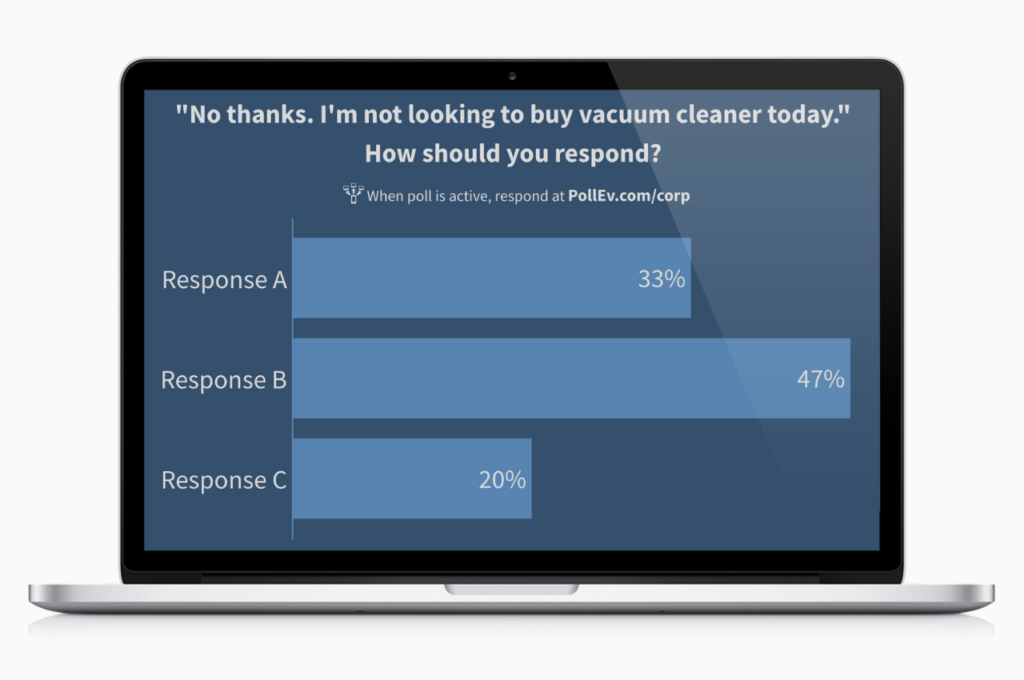
One of the best ways to reinforce new information is to give people the opportunity to use that information in some way. Poll Everywhere Multiple Choice activities are a simple, customizable way to create that opportunity for almost any topic.
Here’s how it works: Say you just finished presenting a lengthy seminar on how to sell vacuums door-to-door. Everyone in the audience has scribbled pages of notes on what to say to whom and when. But none of them has actually sold a vacuum, yet.
Create a choose-your-own-adventure conversation using a series of multiple-choice activities. Each activity is a different line from your fictional vacuum purchaser, and the audience votes on different replies. Whichever reply gets the most votes advances the conversation, for better or worse.
This style of questioning has plenty of applications besides vacuum salesmanship, but the core function should be constant: Giving the audience a simply way to reflect upon, and apply, what they just learned.
10. Fill in the blanks
A simple worksheet does double duty during presentations

Here’s how it works: Create a worksheet and print out several copies before your presentation. Each question on the worksheet should be an important line from your presentation – but there’s a word or phrase missing. Ask the audience to fill in those gaps as they listen.
This accomplishes two very important things for the audience. First, the questions on the worksheet make it obvious what the key points or takeaways are from your presentation. They know what to focus on and pay special attention to. Second, the completed worksheet doubles as a resource that summarizes what you just presented. Attendees can refer back to it later if they forget something.
You can gamify this exercise ever-so-slightly by entering everyone who completed the worksheet before the end of your presentation into a raffle. It’s up to you whether or not you announce this beforehand, or have it be a surprise at the end.
If you want to try any of the interactive presentation games yourself, create a Poll Everywhere account and start engaging your audience today!

Related articles
- Shopping for TVs: 4K vs. 8K
- The Best Mechanical Keyboards to Buy
10 Free PowerPoint Game Templates
Customizable slideshows for Jeopardy, Deal or No Deal, and other games
:max_bytes(150000):strip_icc():format(webp)/stacy-fisher-9842c081a15b4def99bfd26b4822be19.jpg)
- Emporia State University
:max_bytes(150000):strip_icc():format(webp)/Lisa_Mildon-1500x1500-4f77d70e45154ae7ada946d2c35ec60d.jpg)
- Southern New Hampshire University
PowerPoint templates are a great way to introduce a new unit or review for a test with your students. It's a break from the regular routine, and students love the teamwork and competitiveness.
I've also used these templates with friends. I can replace the questions and answers with fun topics we're all familiar with and then play in person or online over a video call.
There are lots of websites with free PowerPoint templates that work with Microsoft's software and free presentation programs .
Jeopardy PowerPoint Templates
Most of the hard work is done for you.
Sleek graphics.
Some come with familiar sound effects and theme song.
Some are in the HTML format only.
A few require your email address.
One of the most popular types of PowerPoint games to use in the classroom is Jeopardy. It's a great game to use to review for a test or to introduce new material to students. They can be played as a class, teams, or individually on computers.
Family Feud PowerPoint Templates
Can encourage and be used with teams of students.
Great graphics resembling the TV gameshow.
Realistic sound effects from the gameshow.
Some are limited to a few slides.
Some require quite a bit of customizing.
Not much non-English support.
Some don't come in the popular PPTX format.
Another free game that's popular with teachers and students is Family Feud. These are played just like traditional Family Feud, and kids of all ages really get into the game.
Wheel of Fortune From Games by Tim
Comes with great instructions for setup.
Realistic looking graphics.
Website has handy instructional video for help.
Cool animation.
Setup is pretty involved.
Doesn't automatically figure dollar amounts.
Can load only 12 puzzles.
Spin the wheel, use your own puzzles, and track scores with this Wheel of Fortune PowerPoint template that really reminds me of the actual game. It comes in the PPTM format .
Only Connect From Fisher Huntz
Includes sounds.
Multiple templates with questions and answers.
Includes a blank template.
Provides directions for playing and editing the template.
Doesn't include the game's Connecting Wall.
More free PowerPoint templates are available here that are modeled after the game Only Connect. One template is basically blank, so you can fill it out with whatever you want. Each of the others have 20 prefilled questions and answers that are ready to go for any teacher looking to entertain their kids with math or science related questions.
Deal or No Deal From Mining Quiz
Included a game rules slide for players.
Has a small help page to assist in setup.
Easy to edit template.
Graphics are a bit simple.
Single sound effect isn't clear.
This Deal or No Deal PPTX template is easy to manipulate and has sounds for each time you choose a briefcase.
Who Wants to Be a Millionaire Verbs
Comes with 12 pre-made questions.
Graphics and text are easy to read.
Added sound effects to enhance gameplay.
Will need to change the money values for other countries.
The lifelines are not clickable and only advance the slide.
Doesn't accurately keep track of winnings.
This Who Wants to Be a Millionaire template has questions already filled out for you about simple verbs. There are 12 questions in total, and I like that it has sounds and animated graphics for realism.
Who Wants to Be a Millionaire Templates From Sctriton Science
Website provides optional sound effects.
Provides enough blank question templates to play a full game.
Sound effects add some excitement.
The lifeline links reveal all answers.
Sound snips aren't very high quality.
This is yet another template for playing Who Wants to Be a Millionaire in PowerPoint. It has 15 questions, all blank and ready for you to fill out with your own information.
Cash Cab From Sctriton Science
Provides enough slides to play an entire game.
Gives basic game instructions.
Fun ceiling animation like the TV show.
Can easily edit it.
Sometimes the template messes up.
Just like in the real game, this template includes not only blank slides for all the different questions, but also a place for a Red Light Challenge and a Video Bonus Question. You can also download the audio files for this template.
Cash Cab First Aid From Mining Quiz
Gives clear instructions on how to customize.
Nice sound effects to engage player.
Text is easily readable at a distance.
Distracting background.
No extra rounds like actual the actual game.
No way for player to select answer.
This Cash Cab template for PowerPoint has 12 questions, all related to first aid information. This template revolves around the objective to reach the Empire State Building before being kicked out of the cab with too many wrong answers.
You can also grab a blank template from the same download page if you want to write in all the questions and answers yourself.
The Price is Right by Stranded Goose
Works for free through Google Slides.
Very simple design.
Must make a TPT account if you don't already have one.
TPT requires access to your whole Google Drive account.
This 22-page template for The Price is Right is from a user called Stranded Goose at Teachers Pay Teachers. It works in Google Slides , so you'll use the presentation as part of your Google account.
Get the Latest Tech News Delivered Every Day
- 13 Free PowerPoint Game Templates
- What Is Microsoft PowerPoint?
- 10 Best Places for Free PowerPoint Templates
- Create a Default Presentation Template in PowerPoint
- What Is Microsoft PowerPoint and How Do I Use It?
- How to Get PowerPoint on a Mac
- How to Create a Timeline in PowerPoint
- The 8 Best Free PowerPoint Alternatives
- 5 Best Free PowerPoint Background Sites
- Change the Default Font in PowerPoint Text Boxes
- How to Make a Word Cloud in PowerPoint
- How to Create a Microsoft Sway Presentation
- How to Copy a PowerPoint Design Template to Another Presentation
- How to Use Microsoft's Free PowerPoint Viewers
- The Definition of a Slide (or Slides) in a PowerPoint Presentation
- Use This PowerPoint Template for a Multiple Choice Quiz
Game On! How to Easily Create and Play PowerPoint Games

Sylvia Nguyen
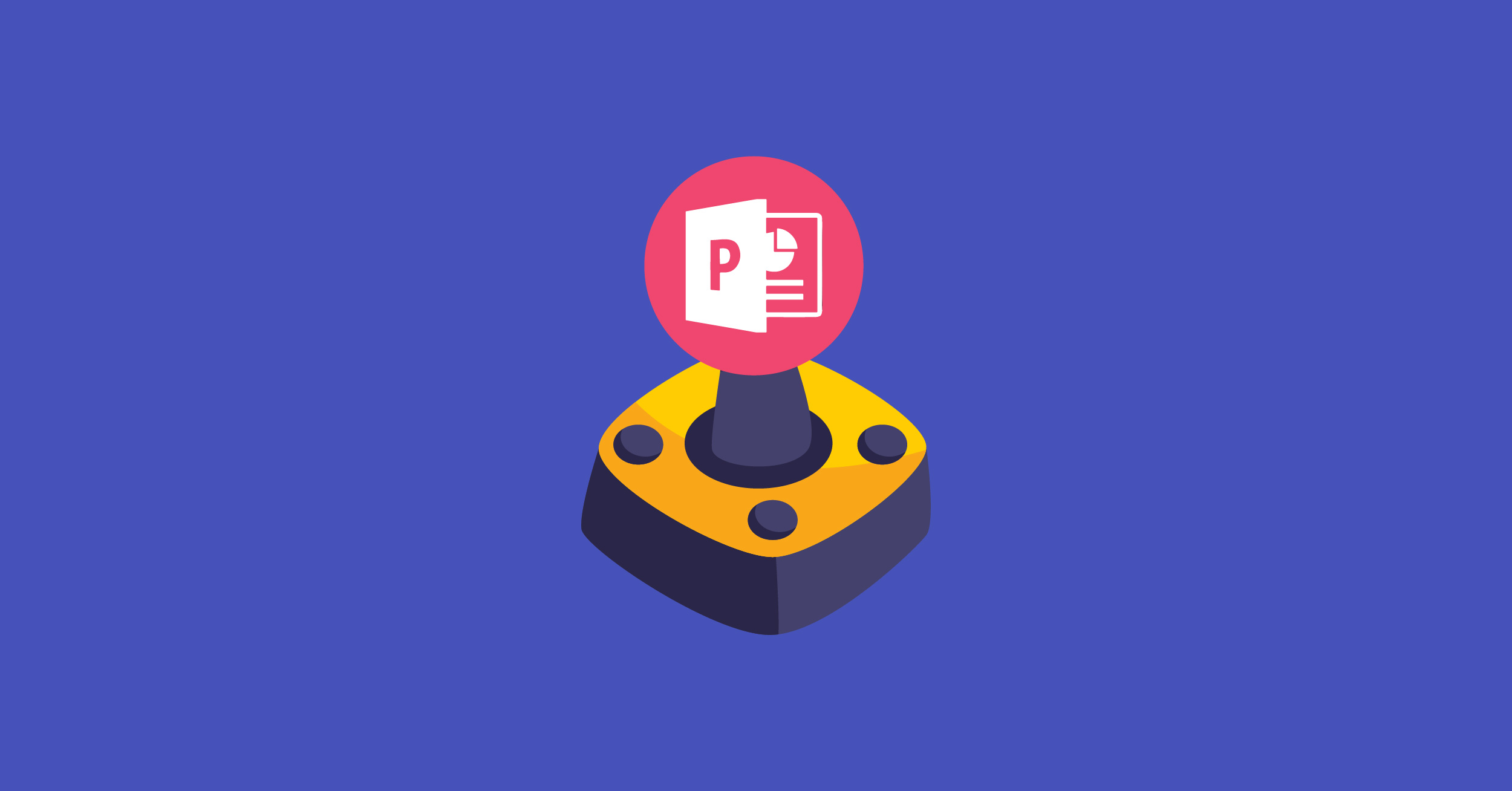
Do you know that PowerPoint can actually be fun? Yes, you definitely read it right, PowerPoint can be fun and engaging with just a little of effort. If you are continuously wondering “How to turn these boring slides to interactive PowerPoint games?” , then keep scrolling because you might thank me later!
PowerPoint Gamification
Before getting to the details of the PowerPoint games of this article, let’s go over the concept of gamification by adding games in PowerPoint. By understanding gamification in education, we can observe its impact on student progress and the necessary of applying gamification to daily PowerPoint lecture slides.
Gamification in Education Definition

Gamification is defined as applying game-like elements, or turning class activities into games but still managing to keep it under educational setting. By doing so, gamification increases student motivation and aid in student learning. In fact, according to a research in 2017 on the International Journal of Education Technology in Higher Education, gamification was justified to create positive impact on student engagement and motivation. From then, it was proven that gamification contributed to the learning curve and growth of students. Thus, gamification in education has various benefits for student learning progress as a convincing proof so that educators can be rest-assured to adopt this concept into their daily classroom.
So, how can we do to apply gamification in classroom?
Well, there are many ways to gamify your classroom , and plenty of gamification tools and applications you can try using, but today I’m going to show you how you can simply gamify PowerPoint slides.
How to Gamify PowerPoint Slides
As we learned the concept of gamification in education, it is thoroughly explained that in order for us to apply gamification, it is vital to bring the whole concept of gamifying learning journey to our students. One of the best practices is gamify classroom activities with the basic game concepts of points, levels, and a leaderboard.
Creating a leaderboard & using these game-based elements in your classroom doesn’t have to be manual, you
To add these game-based elements into your classroom, you can simply use PowerPoint! Instead of learning a completely new tool, or creating a manual leaderboard, ClassPoint, a PowerPoint add-in, adds a gamified reward system to PowerPoint . Using ClassPoint’s star points & leaderboard, educators can easily implement gamification strategies that increase student participation and centralize their learning experiences in a creatively fun way!
How to Create Interactive PowerPoint Games
One of the easiest ways that you can do to convert your boring slides into an engaging game is by directly creating an interactive quiz games in PowerPoint.
So, how do you create a PowerPoint game?
By turning your slide into a student question! Just add a question button, and your students will be able to answer and participate right from their phone! This not only enhances student engagement but also provides you with real-time insights into their understanding and progress.
They don’t have devices? – you can still ask verbal/written questions & give points!
Here’s how:
1. Turn slide into a quiz question
Turn any PowerPoint slide into a question! From trivia to written responses, you can get creative with how you want students to practice recall! Just write your question on your slide.
With the PowerPoint add-in ClassPoint, you can choose from eight different types of question formats to send to your students’ devices, such as multiple choices, fill in the blank, short answer, or even media-type of quiz like sending image or video as response to question. All of these can be turned to fun quiz games with a well-ready score system with leaderboard.
How : Write your question as text on your slide. With ClassPoint installed, you will find a ClassPoint tab in the PowerPoint ribbon. Click on it, and select a question type to add to your slide. Then the side panel will open where you can configure your question settings, such as setting the correct answer. And you’re done! Now sudents can join and answer from their devices
2. Award points for students’ answers
When it’s quiz time in class, run your quiz live, visualize students answers, and award points for correctness or excellence!
How : Students can join your class online using the class code, which will populate in the top right corner of presentation mode. Click on the class code for details. (you can create a saved class and set this code yourself!) Run your questions by clicking on the button in presentation mode! (you can set the questions to automatically start when you reach the slide!) Watch as students submissions fill your screen, then award stars!
Reward answers by awarding stars to everyone who submitted ‘A’ for example, everyone who submitted the word “inductor,” or to individual responses, for questions like short answer or slide drawing. You can also use the search bar to look for specific words in the answers or captions and give stars to all who used it!
If they don’t have devices:
If your students don’t have devices or it’s not the day to use them, no worries! You can still create a quiz game in PowerPoint, and use ClassPoint’s stars & leaderboard to gamify it!
How : Create question slides , then decide how you want students to answer: verbally in a game-show style, on individual whiteboards, or on paper, using their fingers for multiple choice, etc. Then give points with ClassPoint’s stars and saved class!
By creating a saved class in PowerPoint , you can open your class on any slide, and seamlessly give out stars to students! Then you can reveal the leaderboard for some competitive fun!
3. Reveal the Leaderboard
In order to gamify this quiz, you need game-like elements such as a leaderboard to make it a competition! With ClassPoint inside PowerPoint, you can open the Leader Board to reveal the top standings & podium to motivate students with friendly competition.
How : Click on the Leader Board trophy from the toolbar and watch confetti burst revealing the top star standings. Note: there is a current class and a total stars leaderboard; if you create a saved class, stars will accrue! Then you can set levels and use this for longer-term learning objectives!
4. Adjust levels and set goals
With saved classes, you can set star levels and have the leaderboard standings last over multiple sessions! As students earn stars, they will reach new levels & level badges! You can use ClassPoint’s gamified reward system for any objective or goal you’d like
How : Set your students’ goal , and let your students know what their objective is and how they can earn stars! Then set the levels : how many stars they need to earn in each level such as 10 or 20. (Maybe throw in rewards for each level earned!) Then award stars to reinforce their achievement or behavior.
- for single day use : if you have 10 questions, set level badge 2 to be 8, 9, or 10 stars and offer a reward to everyone who can reach level 2
- end of every unit quiz competition
- daily warm-up & recall points for participation
- Ex: each student must earn at least 3 stars a day for full participation points!
- for reinforcing positive classroom behavior
Why ClassPoint instead of Kahoot?
There are plenty of tools available for you to host quiz games, such as Kahoot! . This is a popular gamified quiz that let teachers create multiple choice quizzes online (or repurpose from their teacher-shared library)! However, tools like Kahoot, Pear Deck , ClassDojo , Quizizz , etc., require you to use a browser every time you need to launch activit.
By utilizing ClassPoint’s integration with PowerPoint, you can seamlessly incorporate interactive quizzes into your already-existing lessons.
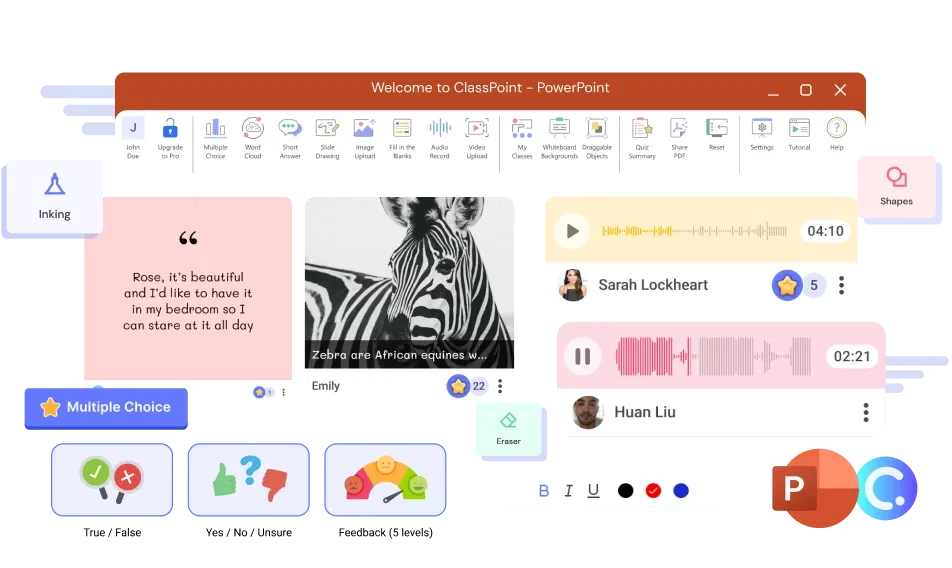
In the long run, using ClassPoint in PowerPoint may be the most appropriate method for daily usage since you’d need to switch between PowerPoint and your browser in order to use your gamification system, which can be time-consuming. Fortunately, ClassPoint provides those features from interactive quiz to gamification system – all in one tool. This tool provides us exactly what we need – a package of interactive features allowing its users to transform static PowerPoints into a live interactive presentation.
More Easy-Prep, Fun PowerPoint Games
With ClassPoint, a student engagement add-in for PowerPoint, there are plenty of other tools that you can use to turn your slides into an fun and interactive game! (that don’t include the student-response questions or the use of student devices!)
The Snowman (Originally “Hangman”)
The famous game of hangman can be easily played in PowerPoint! You just need to design the game on a slide and ClassPoint will help you to take care the rest.
Note: While “hangman” is famous, there are plenty of more politically correct versions of the same game that are more kid & school friendly, such as building a snowman!
- Slide: Pose a question or think of a vocab word and design the letter placement based on the number of letters of the answer. Alternatively, leave out the letter placement and add it live on the spot using ClassPoint’s annotation tools!
- Annotation toolbar
- Alternatively, to make a more creative and aesthetic game, you can use the Draggable Objects feature for the letters & building the snowman
How to play: Give students your question or tell them to start guessing your vocab word one letter at a time! When students start answering, you can use the annotation tools to fill in correct letters, to mark down incorrectly guessed letters, and with each correct answer, you can allow your students to draw one part of the snowman on the slide, or you can help your students to draw it. If you use Draggable Objects, you can alternatively drag the correct letters to the correct spot of answer, then drag the pre-made snowman’s parts to build a complete snowman!
Tip : Plan to play this game more then once? Save your game slide design as a ClassPoint whiteboard slide, then whenever you have 5 minutes at the end of class, open this game as a whiteboard inside any PowerPoint deck ! And wah lah! You have an educational fun game and zero wasted time.
Similar to the original Jeopardy TV gameshow, you can also set up a Jeopardy game inside PowerPoint!
- Slide: Create a table grid of hidden questions behind tiles/squares. Across the top should be different question categories, and going down should be a varying range of question difficulty. On top of the question tiles/squares, instead of posing the correspondent amount of cash-worth for each question, replace it with the number of stars awarding once respondent give the correct answer. Then write your questions on each corresponding slide. You can add interactive question type in these question slides to engage your students better. Remember that the higher number of stars, trickier the question should be.
- PowerPoint animation to move away the question tiles once it’s clicked
- Or, you can use ClassPoint Draggable Objects to drag and drop the award-worth tiles
How to play: Student gets to choose their hidden question based on the category and difficulty/number of stars. Then, move the stared question tile with drag and drop or animation, revealing the question. The student or team then answers it, and if the response is correct, he/she can receive the number of stars correspondent to that question using your own tally or ClassPoint’s star reward system! (see 3 & 4 under interactive PowerPoint game!)
Wheel of Fortune
Let’s add some little fun when asking your students to contribute their thoughts in the lesson!
- Slide: First, you need to come up with a question that allows your participants to answer using a keyword or a short sentence. Then, on the slide, prepare a crossword corresponding to the correct answer of question.
- Saved Class
- Wheel of Names
How to play: In wheel of fortune, the values of the prize are cash, but for this game, we will make the prizes the number of stars students can earn for each question! To prepare the spinning wheel of names embedded into PowerPoint , you will need to first add the list of awards (stars value) for students as a saved class in PowerPoint. Then, in slideshow mode, you can show this wheel to host the famous Wheel of Fortune gameshow in your class.
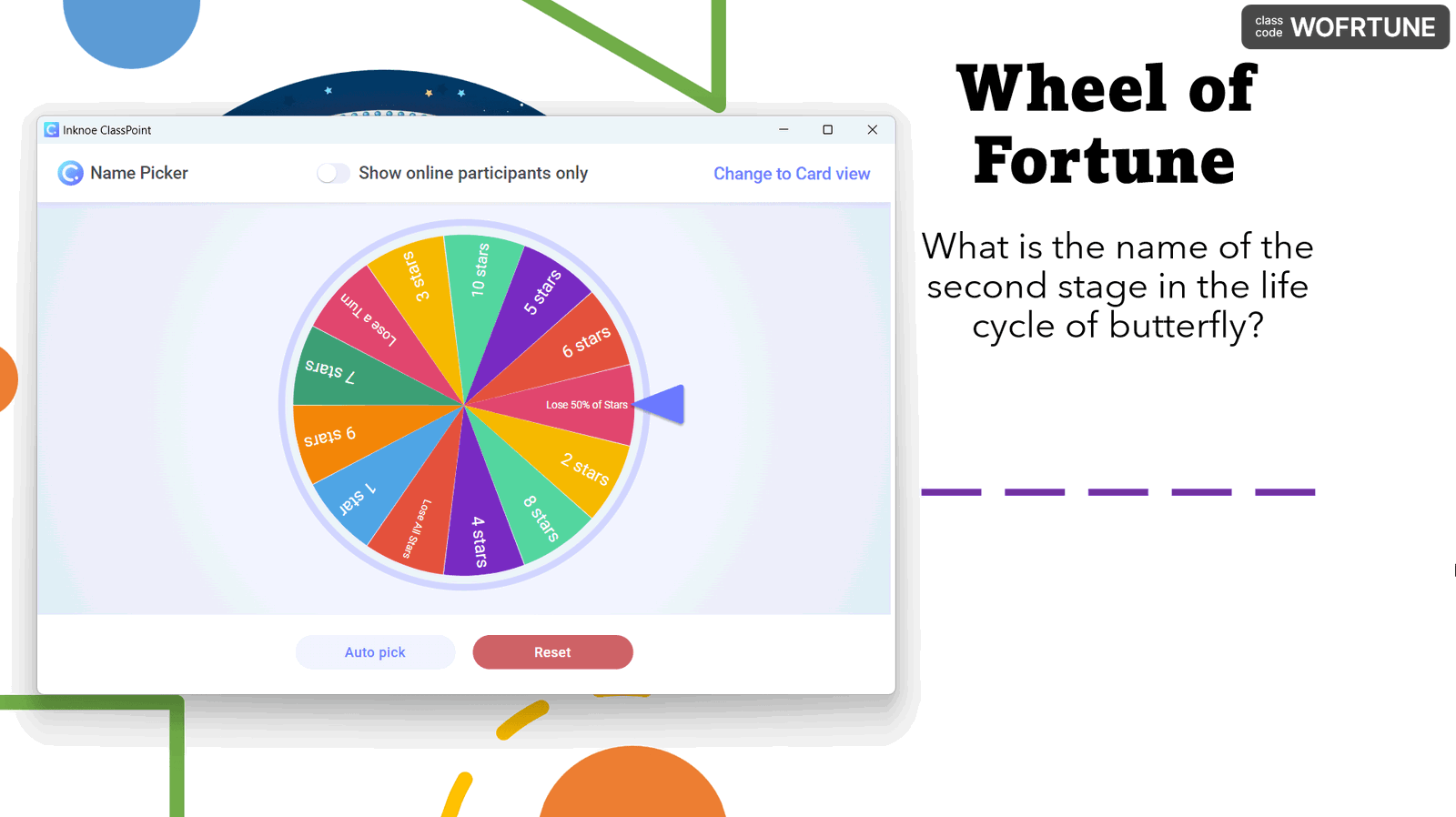
Finding the Way – Maze in PowerPoint
Last but not least, I had to include this all-time game that is loved by not just kids but also adults. With a little twist, we can turn the child game version of Maze or “Finding the Way” to an educational version of it.
- Slide: Prepare the maze image and the elements for the connection of finding the way. Note: This game fits best with the type of knowledge or definition that has correlations (e.g. Water and its states)
- Annotation toolset
- Or, Slide Drawing interactive question type
How to play: After setting up the slides, you can allow students to come up and draw on the slides from your device using annotation tools of ClassPoint in slideshow. Alternatively, you can use the interactive activity “Slide Drawing” and allow your students to draw the connection on their own device.
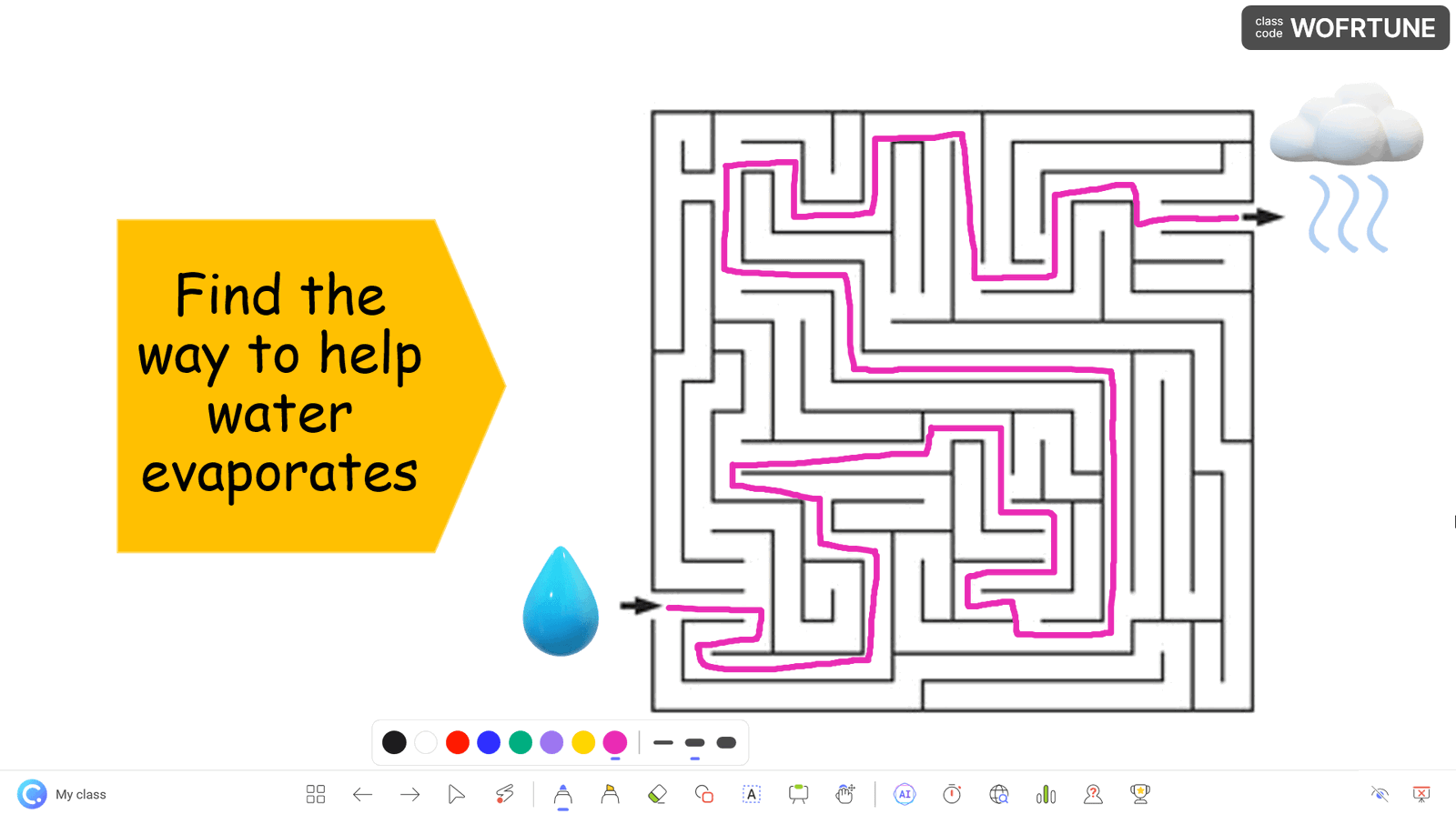
I hope that this article helps to knock on your creativity in making exceptional PowerPoint games and adopting educational gamification to your class on a daily basis. Gamification is definitely a game-changer for all educators who understand the concept and apply it in students learning appropriately.
And with ClassPoint, you can incorporate gamification seamlessly into your PowerPoint lessons! With the ability to transform slides into questions, run quizzes with students’ devices, award stars for answers, and reveal leaderboards, ClassPoint offers a comprehensive solution for creating interactive quizzes and games within PowerPoint presentations.
So, if you haven’t tried it yet, download it for free today, and share any of your own ideas or experiences using PowerPoint for games in the comment section below!
About Sylvia Nguyen
Try classpoint for free.
All-in-one teaching and student engagement in PowerPoint.
Supercharge your PowerPoint. Start today.
800,000+ people like you use ClassPoint to boost student engagement in PowerPoint presentations.
50+ Fun Icebreakers For Your Next Presentation

If you’re looking for the perfect icebreaker to open your presentation and connect with your audience from the get-go, look no further! With the help of our presentation experts here at 24Slides, we have compiled the ultimate list of icebreakers you can use in your next presentation, meeting, or conference.
We’ll also go through some quick icebreakers 101, solving questions like:
What is an icebreaker?
- Why should I start my presentation with an icebreaker?
- What makes a good icebreaker for presentations?
And, of course, you’ll get our compilation of over 50 icebreaker examples for your next presentation. Since there’s no one-size-fits-all, we’ve divided our presentation ice breakers into categories depending on the context of your presentation, so you can go straight to the ones that will work the best for you!
In this article, you’ll find:
Icebreakers for one-on-one presentations
Icebreakers for small group presentations (2-10 people), icebreakers for medium group presentations (11-30 people), icebreakers for large groups (31+ people), icebreakers for business and sales presentations, icebreaker ideas for training sessions and workshops.
- Virtual presentations icebreakers
- Fun icebreaker examples for playful presentations
- Great simple icebreaker questions
So, are you ready to become an expert in using icebreakers in your presentations?

Imagine you’re in a room with a bunch of people where you know only a few of them or even none at all. You’d probably start feeling awkward and self-conscious, uncertain to interact with those around you. When you’re uncomfortable, your attention will probably be divided between wanting to listen to the speaker and making sure your elbows don’t touch your unknown neighbor.
And, if you’re the speaker, you might feel pretty awkward too. Speaking in front of an audience is never easy, and you might wonder how to approach your presentation’s topic, especially if it’s dense or very important.
An icebreaker is precisely what its name suggests: it breaks the ‘ice’ of uncomfortableness between you and everyone else around you. Icebreakers are usually short activities meant to help your audience to connect first as people before approaching your presentation’s topic - making your audience more relaxed and likely to hear out your ideas.
Icebreakers can take many forms and shapes, from simple questions to engaging games. They can require people to talk with each other, answer a poll, or even move around the room. Anything that will make your attendees open up could be an icebreaker as long as it makes people feel more at ease!
Benefits of icebreakers
The main objective of using an icebreaker in a presentation is to help people get more comfortable and avoid the common awkwardness when first speaking to a new audience.
Icebreakers can accomplish many things - presenting yourself, getting people more at ease, and even as an introduction to your presentation’s topic. But they also offer a wide array of side benefits, like getting people more involved with your presentation and making it more memorable.
If you’re thinking to yourself, ‘Why should I add an icebreaker to my presentation? I’m just fine without one!’ here are 6 of the top benefits of using an icebreaker in your next meeting.
- It breaks down the awkwardness
For people who aren’t 100% an extrovert, presentations and meetings are likely to create a certain degree of awkwardness. And having a room full of people who feel uncomfortable around each other can be detrimental to your presentation. Icebreakers help lessen this feeling in your presentation – making people relax and be more at ease so they can put all their energy into listening.
- Icebreakers help people relax and have fun
When people relax, they’re more likely to entertain new ideas. An icebreaker may be the turning point to make them feel more receptive to what you’re going to say. It also opens up more possibilities for inviting your audience to participate and ask questions. Icebreakers are a great way to make them feel welcomed and more likely to volunteer or join whatever activity you’ve prepared for them onstage.
- Help you connect with your audience
A presentation where the speaker starts right away can feel a little jarring. Icebreakers are the perfect way to introduce yourself and your topic without throwing your audience headfirst into the presentation. A good icebreaker can help you connect better with your audience – making them, in turn, more likely to hear you out!
- Gives your audience an energy boost
Some presentations can feel like they take forever. When you’ve been sitting down for what seems like hours, you might feel yourself starting to nod off. An icebreaker doesn’t necessarily happen just at the start of the presentation. It can be a great way to wake up your audience after a quick break and bring them back to the topic at hand.
- Gives a chance to network with others
The right icebreaker can get your audience talking and help them find things in common. After all, your audience is all in the same meeting for a reason! By giving them the opportunity to interact with one another, you are also giving them the extra value of finding people who can work with them in the future.
And, of course, icebreakers are great ways to get the ball rolling, so by giving your audience a chance to talk with one another, you might also get more interesting and unique takes on questions and ideas later on.
- Creates a positive atmosphere
A positive atmosphere is created when people lower their barriers and defense mechanisms, making it more conducive to learning. A negative atmosphere, on the other hand, is felt when people don’t feel at ease and give their neighbors the cold shoulder. ‘Breaking the ice’ needs to get done as soon as possible!
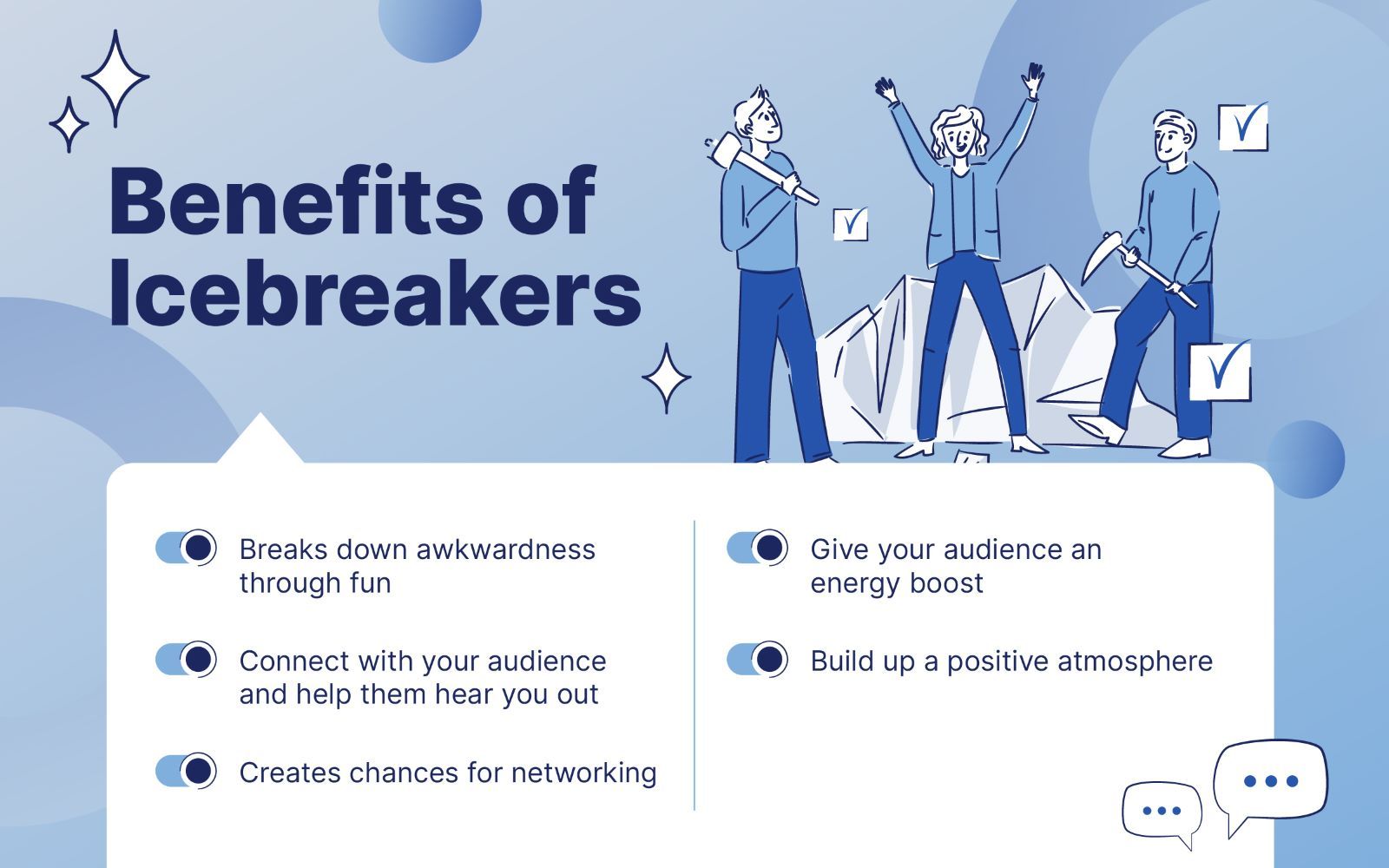
5 Practical Tips for a Good Icebreaker
What makes a good icebreaker? This is a tricky question to ask. Many icebreakers that work in certain situations will not work in others, as their use depends on context.
Here are key factors to consider when planning your next presentation’s icebreaker:
- Know your audience
Take the time to research your audience. The most important thing when planning your presentation’s icebreaker is to remind that you want your audience to feel less awkward — not more.
Taking your time to learn about the people in front of you is the easiest way to avoid doing or saying something that could potentially offend your audience. Even if you do it unintentionally, the damage will still be done.
- Identify your presentation objective
The right icebreaker will help you achieve your presentation objective, so take some extra time to think about it. For example, if you’re giving a presentation on cooperation and teamwork, you can do a game where your audience needs to rely on one another. Or conduct a poll to ask your audience how confident they are in their teamwork skills.
Making your icebreaker closely relate to your presentation’s topic will not only open up your audience but also allow you to transition smoothly to the rest of your presentation.
- Involve everyone
The icebreaker should be inclusive, meaning it shouldn’t exclude anyone from joining. For instance, if you have a disabled person in the crowd, then you wouldn’t want him or her to feel awkward for not being able to join.
Have a backup icebreaker just in case the first one excludes someone. The point is that fun icebreakers should make everyone feel more at ease — and not at the expense of the outliers of the crowd.
- Make sure you understand the context
To pick the right icebreaker for your presentation, you must know the overall setting in which it will take place. A presentation to the board of directors where you need to explain where the sales have been going down is probably not the best place to use a joke as an icebreaker. Or, if you’re giving a quick 15-minute presentation, you might not want to begin with a game that will take at least 10 of them.
Taking into consideration general setting cues like time frame, space and resources availability, and presentation tone, will help you pick the perfect icebreaker.
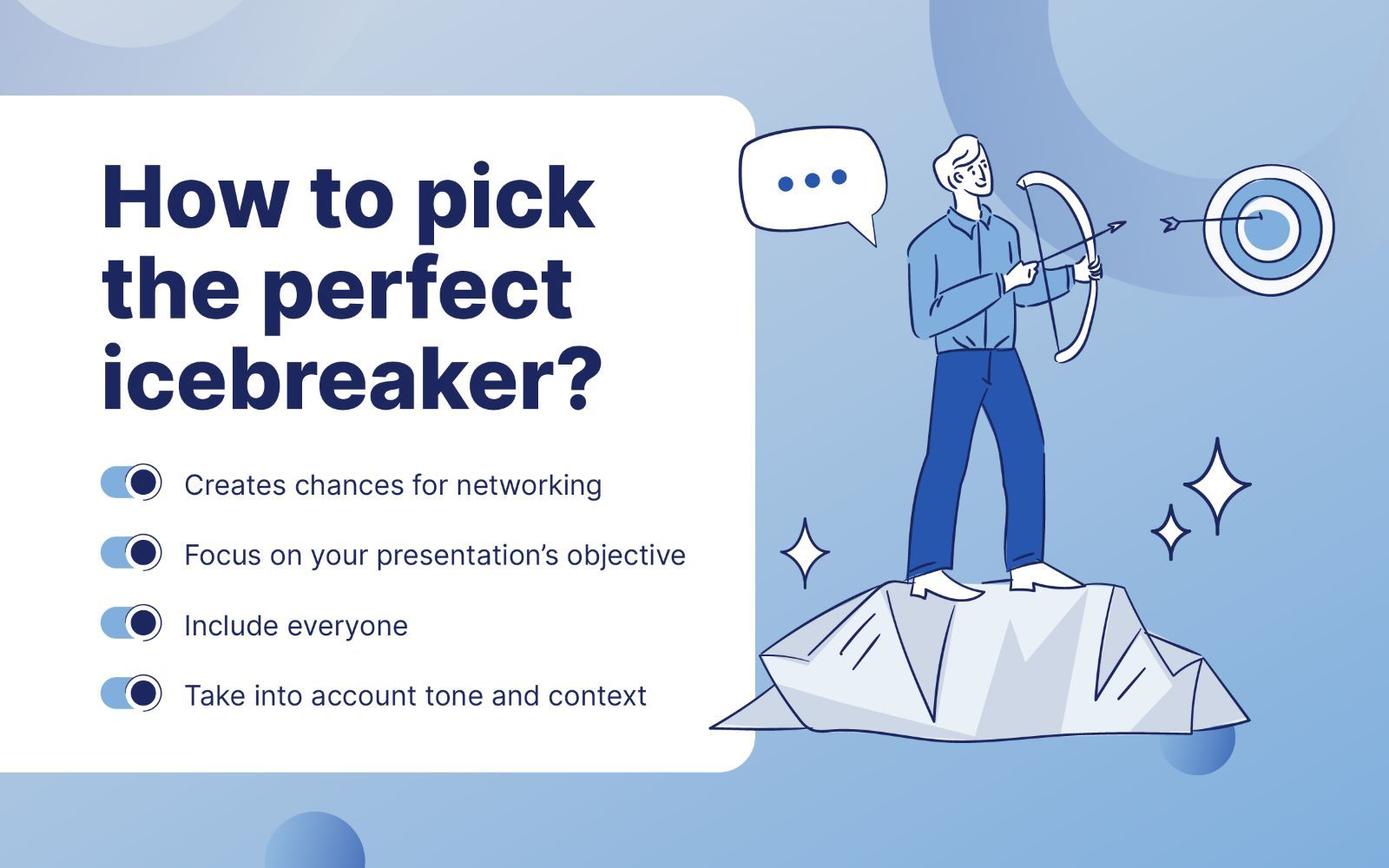
The Ultimate Presentation Icebreakers List
Here you’ll find the perfect icebreaker for your presentation. Since not every icebreaker will work on every situation, here you’ll find them divided into several categories:
- Icebreakers depending on your audience size
- Icebreakers depending on your presentation’s tone and context
- Quick and easy questions to break the ice
Do feel free to browse through the entire list: most icebreakers will be easy to adapt to fit your specific needs and your presentation!
Presentation Icebreakers for Every Audience Size
While in a small crowd, you might be able to ask person by person their input, this will most likely not be the case in large groups. On the flip side, a game that needs the audience to divide into teams might be a good pick for a medium-sized crowd, but not a one-on-one presentation.
Among the many options of icebreaker options all over the web, we’ve compiled and edited a list of which ones will work the best for each audience size:
- Introduce yourself. Unless you already know each other, introducing yourself is the easiest way to look proactive and get your presentation going. After all, it’s in your best interest for your prospect to warm up to you before your pitch or presentation!
- Have a conversation . Don’t go straight to your topic. Always warm up your prospects and engage them in conversation first. Try to ask open-ended (instead of just ‘yes’ or ‘no’) questions. You can tackle topics like current events, or even just the weather! Just talking in a more casual way will make the person feel more at ease and more likely to give you their undivided attention.
- Ask them about their personal life. If it’s someone you already know, build rapport by showing you care about them. You can ask about their kids, vacations, or even their favorite sports team. Remembering what they care about can be a huge plus when building a better atmosphere!
- Let them tell you what they expect from your presentation. It’s the easiest way to make sure you live up to your expectations! It also allows you to introduce the topics of your presentation seamlessly. Even better, you’ll feel and look more confident and under control by taking charge of the presentation’s rhythm and agenda.
- Ask something related to your presentation topic. Ask them if they know anything about your company, product, competitors, or something to that effect. It’s not only a great way to start your presentation without spending too much time on what they already know, but it’ll also help you gauge their knowledge so you can decide how in-depth you need to get in your presentation.
- Give them a small present just for showing up. Especially if the meeting is not an obligation for them, being appreciative if they show up can go a long way. After all, they’re investing their time and energy into you!
- Compliment them. It’s always nice to get compliments. But don’t overdo it, and always, always be genuine. If your prospect feels like you’re using flattery to get the sale, then it can seriously backfire on you later on. You’ll lose face and credibility.
- Introductions but with a twist. Ask everyone to introduce themselves and state something unusual or a fun fact about them. Towards the end of the presentation, ask them if they remember anything other people said during the introduction. If they get something right, reward them.
- Ask people to line up alphabetically . You can do this with their first names or last names. Or even their nicknames. This gets people talking and getting to know each other’s names.
- Charades . This is one of the best fun icebreakers on this list. It’s a party favorite but can also be used in presentations, meetings, and conferences. You probably already know how this works, but if not, here’s a funny charades video on Jimmy Fallon’s show.
- String a story together . Storytelling is a powerful element in presentations. But for this icebreaker, you’ll need everyone’s help to create a story. Start the first sentence yourself and then ask the first person in front of you to continue the story. Each person gets to decide the direction the story takes, one sentence at a time.
- Play word games . There are many different kinds of word games. But this is something you may find useful. Identify the subject or category the words should belong to, like animals or food. If the first person chooses ‘DOG,’ the next person must identify an animal that starts with the last letter of the previous word. In this case, it would be something that starts with the letter G, like GOAT.
- One word to describe him or herself . Give your audience one minute to think about the perfect word that describes them. And let the others assess if they agree with that word or not.
- Social media icebreaker . Let people open up their favorite social media accounts and then share a photo they’re most proud of. Ask them to share a line or two about why they love that photo.
- Switcheroo. Ask everyone to stand up and switch seats with the people in front of them. Do this when you notice people are starting to get drowsy and need some stimulation.
- Human bingo. This is a fun way to get to know people. Prepare the cards and the pen/pencil. The cards should already be filled out with various traits, characteristics, hobbies, etc. Then, your participants will need to go around and interview each person and check off a box that applies to them. The person who completes their card first gets a prize.
- Friendly debate. Group your participants into two. One should be the ‘pro’ group and the other is the ‘anti’ group. For instance, you can choose pizza lovers and pizza haters. Give them a few minutes to present their arguments and let the great debate begin!
- Two truths, one lie. Just like the title says, make your participants come up with 3 things about themselves, in which one of them is false. Then, in groups or pairs, the others would have to try and guess which one is the lie. It’s a great icebreaker to make your audience interact more with one another.
- Guess game. Just like the last one, it’s easier to make participants interact with one another through a game. Make everyone write on a piece of paper something fun, like an unlikely hobby or the oddest job they ever had. Your audience must try to guess who wrote which one. It’s not only a fun icebreaker, but it also helps people find out the things they have in common.
- Going to the beach. It’s an easy game, but a fun one! Each person will start by saying ‘I went to the beach and I took…’ plus an object, like a beachball, a towel, or a surfboard. Then, the next person must repeat the same sentence and add a new object to the list. The more people, the more the list will grow, and the first person who forgets an item loses! It’s also a good icebreaker for making attendees learn each other’s names by adding who brought what to part of the list they need to repeat.
- Paper planes. Make your audience write something about themselves on a piece of paper, and then instruct them to make a paper plane out of it and throw it! When they pick up a new paper plane, their goal will be to find the correct person. It’s the perfect icebreaker to get people moving and getting to know each other!
- Stretch. This one’s easy and straight to the point, but it does help break the boredom. Ask people to stand up and stretch for a few minutes. You can lead the exercise or play a short video on stage. After this short exercise, you can expect to see a bunch of awake and attentive faces.
- Treasure hunting. Hide a few prized items throughout the venue and send your participants on a treasure hunt. It’s always exciting to look out for a prize! Even better, by making them solve clues, you’d encourage your audience to work on their teamwork skills.
- Stress buster. Hand small slips of paper to everyone and ask them to write down the things that are causing them stress lately. Then, during or after the presentation, ask them to rip it to shreds.
- Snowball fight. Divide your group into two sides, and give each person 3 pieces of paper to crumple. Give them 1 or 2 minutes to try to get as many ‘snowballs’ into the other team’s side. A healthy amount of competitiveness will help you break the ice in no time!
- This or that. Another great icebreaker to highlight the things in common! Ask your audience to stand in the middle of the room, and ask them questions that will make them pick a side of the room. Things like ‘Dogs or cats?’ or ‘Night Owl or Early Bird?’ will have them jumping from one side to the other.

Icebreakers depending on your presentation’s tone
When planning your next icebreaker, you must always take into account the context of your presentation. After all, giving a sales report to your boss is not the same as giving a fun workshop on teamwork.
If you’re looking for the perfect icebreaker for a specific situation, here you might find the one you’re looking for!
If you’re looking for a more professional way to warm up your audience for your work presentations, these icebreakers are the one for you. Most business presentations are more serious and straight to the point, just like these icebreaker ideas!
- Storytelling. This one is the king of icebreakers for business presentations and for a good reason! Storytelling is an incredibly powerful tool to add to your presentations, as it helps to both exemplify your point and connect emotionally with your audience. And of course, this makes it the perfect option to break the ice and get their entire attention from the get-go.
- The highlight of the week. This icebreaker is great for getting your audience into a positive mood. When planning your next business presentation, take some extra time to find something good that happened that week or that month. Maybe you record sales for that month, or you got an exceptionally good review from a customer.
- Would you rather? When planning your sales presentation icebreaker, this one will help to get your potential customer right where you want it. Highlight the value they’ll get from your product, and how they are missing out on it. From our experience, asking, ‘What do you prefer, struggling 5 hours per week on PowerPoint, or getting your presentations done by a professional team of designers in 24 hours or less ?’ really puts things into perspective!
- Give kudos. The best way to put people in a good mood is to spread out some positivity! Giving the spotlight to someone who has done outstanding work recently can be a great way to break the ice.
- Brainstorming session. Group brainstorming is another great way to get people to exchange ideas. You hit two birds with one stone – an icebreaker and an idea generator rolled into one!
The best icebreakers for training presentations and workshops are those that incentivize teamwork and learning skills. These icebreakers will help your team get to know each other better and work together in tandem.
- Live polls. There are many apps that allow your audience to make live polls and display the results immediately. This is a great icebreaker, as it can be as serious or lighthearted as you want. You can use it to ask the audience’s mood, their favorite food, and how much they know about the topic at hand.
- Word cloud. Just like a poll, a word cloud can be a great option to explore what your audience thinks about a prompt or concept you give them and to get the ball rolling. You can make them write down in groups, have them add their ideas to a board, or even make one through an app !
- Problem-solution icebreaker. Present a real or hypothetical problem, and ask people to pitch in their solutions. You can ask them for their input individually, or you can divide them into pairs. As the saying goes, two heads are better than one.
- Finish a puzzle together. This is great for group work as everyone can contribute. For example, you can give them a few pieces each, and they’ll then work as a team to complete the puzzle.
- Pop quiz. This icebreaker is the best to keep your audience on their toes and on a learning mood. You can add it at the end of your presentation, before or after a coffee break, or even at the beginning to see how much previous knowledge your audience has.
Virtual presentation icebreakers
Not sharing a physical space can make breaking the ice even more of a challenge, especially since many icebreaker ideas would not fit an online presentation. So here you’ll find some icebreaker options that are specifically designed for virtual meetings!
- Drawing battle. You don’t have to be a professional artist to enjoy this one! There are many apps and websites that allow you to add this game to your virtual meetings. Just propose a topic and let people try to guess what one of them is drawing! You can even divide them into teams to make it more interesting.
- Try a virtual escape room. If you have time, try giving your audience this challenge to build cooperation and teamwork. It’s not only great for learning to work together but also to have fun and loosen up.
- Count till 20. Your team must try to count to 20 by shouting one number each… but without agreeing in which order they’ll go. This icebreaker will definitely make people wake up, and probably also laugh as they try to avoid talking at the same time.
- Emoji movies. Just like charades, your audience must try to guess the movie or book. But instead of someone acting, they must guess it from the emojis. It’s a great adaptation of a classic game for virtual meetings!
Fun icebreaker ideas for playful presentations
Icebreakers can also help your presentation be more playful and fun! If you like your icebreakers a little silly to make sure people loosen up their inhibitions, then take a look at these ideas.
- The no smiles challenge. If you’re making a fun, playful presentation, a great way to make it even funnier is to tell people smiling and laughing aren’t allowed in your presentation. This will most likely have the opposite effect, making people even more ready to laugh at your jokes!
- Human rock paper scissors. This is a fun, high-energy game, but may not be feasible for older participants. Check this video to see if this is something you can use in your presentation.
- GIFs mood barometer. If you want your audience to be a little bit playful, having them share their mood as a GIF is the perfect way. If you want to keep some control of what they share, you can also use a live poll to give them options to choose from. It’s the perfect lightweight activity that still gives you valuable insights into your audience and their energy levels.
- Bad jokes contest. The only thing funnier than a good joke is an extremely bad one. Have your audience try to use their best dad jokes on each other while avoiding laughing at the jokes of the rest.
10 Great Icebreaker Questions for Any Presentation
Sometimes simpler is better, and the easiest way to get people talking is to ask them to do so! These icebreaker questions will help your audience open up without taking much time or extra preparation.
- If you could have any superpower, what would it be, and what would be your superhero name?
- What's the most random piece of trivia you know and why?
- What is the oddest job you ever had, and how did you end up working there?
- If you could make a reality show, what would it be about?
- What cartoon character would you like to hang out with?
- Where is the most embarrassing place you ever fell asleep?
- If they made a sitcom about your life, what would the theme song be?
- What were the best and worst workshops/meetings/conferences you ever attended?
- If the zombie apocalypse began, what three people in this meeting would you want on your team?
- If you had to teach a class right now, what would the subject be?
As a speaker or presenter, it’s important that you prepare fun icebreakers for your audience. You want people to be comfortable not just with you, but with their neighbors and groupmates as well. The icebreakers in this list are just the tip of the iceberg concerning the wide array of possibilities you can choose from. Don’t be afraid to think outside the box and get creative with your icebreakers!
Need more time to prepare for your presentation? 24Slides has you covered!
Now that you’ve begun thinking about your presentation, and the best way to break the ice with your audience, you might wish to have more time to prepare for it. Luckily, 24Slides can help with that !
You can focus on your presentation’s content and how to make your audience as comfortable as possible, and 24Slides professional designers will tackle the visual aspects of it all. In less than 24 hours , you can get a custom-made, fully editable presentation that will wow your audience and make it even more memorable.
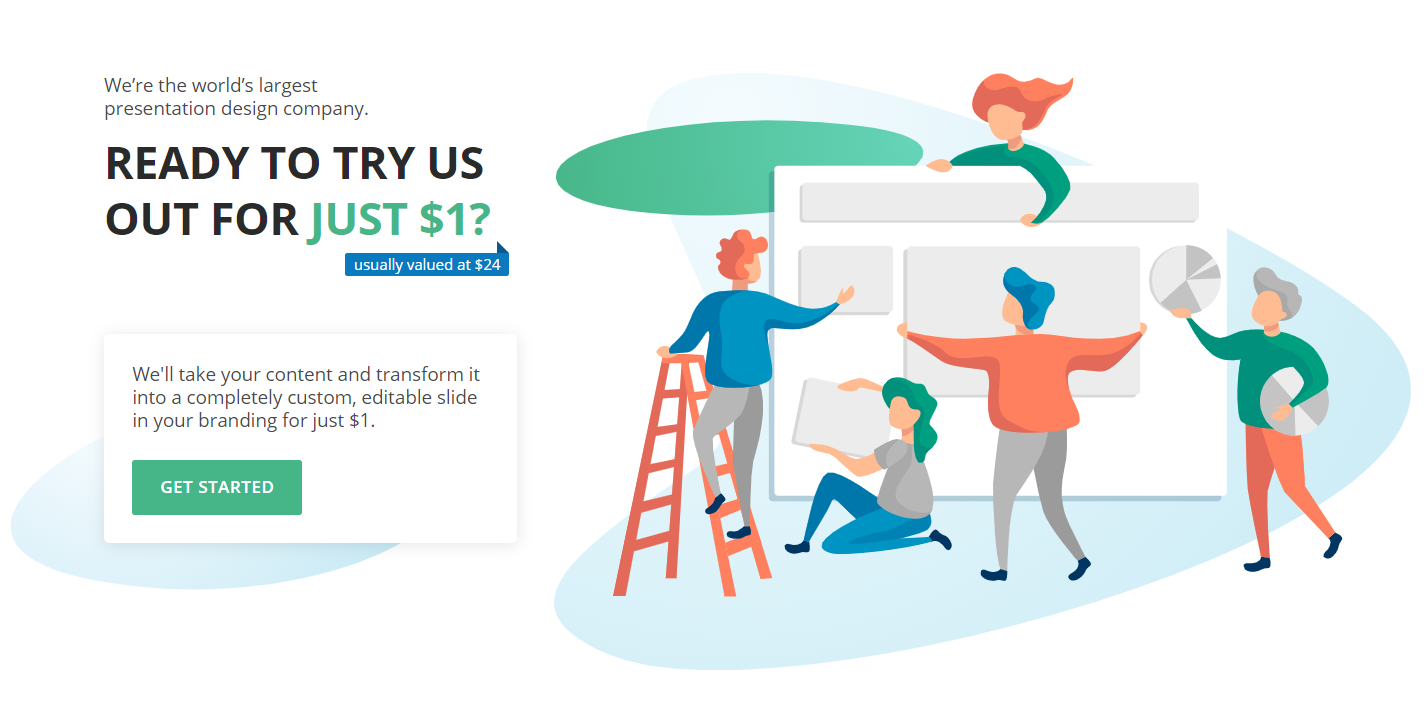
You might also find these articles interesting:
- 7 Essential Storytelling Techniques for Your Business Presentation
- How to Deliver the Perfect Online Presentation
- Improve Your Presentations' Body Language!
Create professional presentations online
Other people also read

6 Presentation Styles of Famous Presenters

How to create and deliver a powerful presentation introducti...
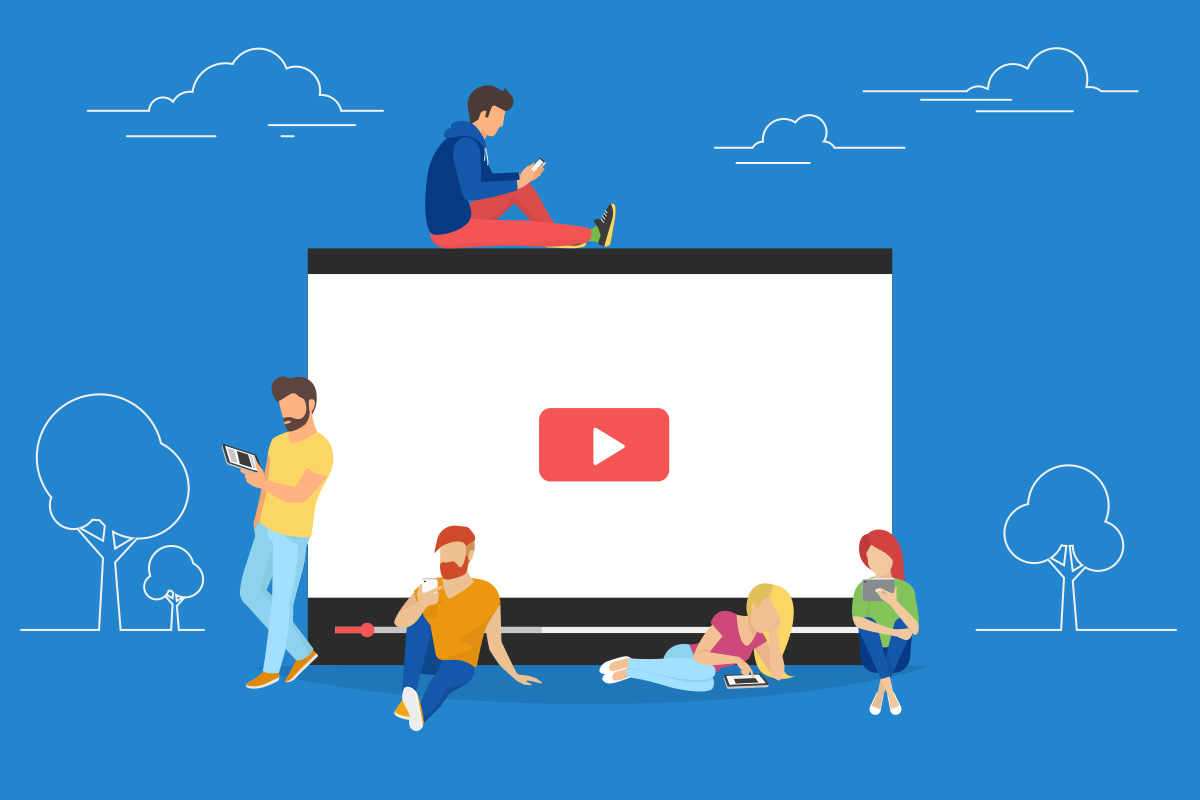
The seven worst presentations of all time and why they went ...

Top 10 Presentation Games for Large Teams
A large audience. Difficult topics. For many speakers, it is difficult to keep their attention on the talking topics during a presentation to a large team or audience. As a result, it is common for people to slip into passive listening mode and grab their smartphones. They simply stop paying attention to your presentation. Interactive games for group presentations can help keep the audience focused. In this blog we will give you a top 10 presentation games to help you keep their attention when you are presenting in front of a large group of people. From a simple game where all the audience has to do is raise their hand, to an interactive presentation game that will help you gain new insights. Choose one or more and find out which presentation game works best for your audience.
Key Takeaways:
- Engage audiences with interactive games like 'Elimination' and 'Assumptions' to start presentations dynamically.
- Incorporate audience content choices using 'Topic of the Day' for tailored discussions.
- Utilize practical application games like 'Bring into Practice' for theory reinforcement.
- Encourage creativity and networking with 'Duo Assignment' and 'Sing & Swing'.
- Maintain attention with end-of-presentation quizzes and the humorous 'Phone' game.
- Leverage Sendsteps for interactive polls and enhanced presentation engagement.

1. Elimination game
This game will introduce you to the audience. A fun idea to start any presentation with.
How it works: Have everyone in the audience stand up. Then display on the presentation screen statements where the answer will determine wheter the audience must sit down. For example, are you speaking at a conference that has already taken place several times? Then start with: "Sit down if this is your first time attending this conference." You can then filter the audience by asking follow-up questions such as: "Sit down if you have attended this congress 3 times." Continue until a few are left.
2. Topic of the day.
You can let some of the content of your presentation be determined by the audience. By asking them beforehand what they think is an interesting topic, you adapt the presentation in no time, to their interest which will make them listen even more attentively. Such short games for presentations are easy to implement, but have a great effect.
How it works: At the beginning of your presentation, show three related topics on the screen. For an entertaining presentation, these can also be unexpected words that have relatively nothing to do with the topic. The audience votes through an online poll which topic or word the speaker should cover in the final presentation.
3. Assumptions
You can run the first game in a similar form with statements.
How it works: First, the whole audience stands up. Show statements on the screen and ask the public to raise their hands when they think a statemwnt is correct, and not to raise a hand when it is incorrect. If their answer is wrong, they should sit down. Continue until there are one or a few participants left and reward them with a big round of applause from the audience or even more fun: an appropriate prize.

4. Fill Gaps
With this game, you kill two birds with one stone. You will keep the interest throughout the presentation and the audience will leave with the most important knowledge points.
How it works: Make a spreadsheet containing one or more key sentences from your presentation. One word is missing from each sentence. Before the presentation, put a workpaper on each chair. Ask the audience to fill in the missing words as they listen and give the correct answers at the end of the presentation.
5. 30 Seconds
Who doesn't love the game "30 Seconds"? In the category of audience games during presentations, this game is easy to play. The time pressure also boosts the enthusiasm of your audience.
How it works: Invite one person to come forward. He or she will stand with his or her back to the screen. Now show a picture on the screen showing an object or familiar person related to your topic. The participant may now ask the audience "yes or no" questions about the image for 30 seconds and try to guess. Set a timer for this. After 30 seconds, is the correct answer still not given? Then the participant may take one more guess. Tip: Double the time when the answer is harder to guess.
6. Bring into practice
Are you giving a presentation in which a lot of theory is discussed? Then it is useful to bring the knowledge into practice. This way you give your audience a chance to think about what they have learned and how they can apply it.
How it works: In a presentation on writing persuasive content, useful tips can be given for writing a catchy title. Listeners usually take notes on what factors are important here, but none of them have written a title based on this. On the screen, show 3 titles that are slightly different from each other, one of which is completely correct based on the theory. Have the audience vote for the correct answer via an online poll on their smartphone and show the results. Then discuss which answer is right or wrong and why.

7. Duo assignment
Participants in a large audience most likely do not know each other. With this game you can easily introduce them and exchange useful information at the same time.
How it works: In a presentation about a new product, you can assign your participants to come up with a name for the product. Have everyone come up with one name. Then they discuss it with their neighbor. Together they choose the best one. The speaker then assigns each pair to speak up their made-up name out loud. With a group of 30 people, this is feasible; with a larger audience, a few pairs can be formed.

8. Sing & swing
Singing is healthy! It gives energy and it puts your audience in a positive flow. Ideal when a presentation is long.
How it works: Rewrite the lyrics of a popular song and show it on the presentation screen. For example, take the chorus and replace it with a few phrases that are the essence of your presentation. Invite the audience to sing it with you. Even more fun presentation game ideas: for extra fun, add a simple choreography, for example clapping or waving your hands.

9. Quiz game
A quiz is an often used but very effective interactive presentation game. Announce in advance that a quiz game will be played at the end of the presentation. This keeps the audience paying attention throughout the presentation.
How it works: Ask about 10 questions and make it interesting by alternating between [multiple choice](/en/questions/multiple choice/), 'right or wrong' questions and 'yes and no' questions. Display these on the screen and let the audience answer with an online poll. Show the scores after each question. This encourages competitiveness in your audience!
Often attention drifts away at the end of a presentation, especially when there are questions from the audience. With this game, everyone pays attention to each other's questions.
How it works: Have all listeners sitting at the left end of the rows think of a question for the speaker. They whisper this question into the ear of the person sitting next to them. The question is whispered through to the person at the other end of the row. The people at the right end of each row may now ask the question out loud. Chances are, the question is nothing like the one initially thought of. This can produce hilarious moments!

Interactive presentation games with Sendsteps
The above mentioned games for presentations will make every presentation a true success. Get started and try out an online poll with your audience. Use our free tool and start presenting interactively right away. Not sure which presentation game is right for your presentation? Then please contact us. We are happy to give advice on how you can increase interactivity with your audience. In addition, Sendsteps offers even more smart features to deliver a perfect presentation.
Related Blogs

How to Create Stunning Presentations with AI?

How to Create Engaging and Educational Quizzes

Exploring the Future of Online Quizzes with AI Technology

AI Presentation Makers A New Tool for Educational Success

How to Engage Your Audience with an Innovative AI Quiz Creator

The Impact of AI Quiz Tools on Data Collection and Audience Insights

The Benefits of AI-Powered Presentation Makers in Education
Leveraging ai for fun and engagement innovative uses of quiz generators.

Exploring the Top 5 AI Quiz Makers: Revolutionizing Knowledge Assessment
What are effective presentation games for large teams, and how do they enhance audience engagement.
Effective presentation games for large teams include 'Elimination', 'Topic of the Day', 'Assumptions', 'Fill Gaps', and '30 Seconds' for dynamic interaction. These games keep the audience engaged, encourage participation, and make complex topics more approachable. 'Bring into Practice' and 'Duo Assignment' stimulate practical application and creativity, while 'Sing & Swing', a quiz game, and the 'Phone' game ensure ongoing attention and fun. These games, especially when combined with Sendsteps for interactive polling, significantly enhance the overall engagement and effectiveness of presentations for large audiences.
How do games enhance team-building and collaboration in a large group setting?
Games in a large group setting enhance team-building and collaboration by providing a shared experience that breaks down barriers and encourages open communication. They create a fun and relaxed environment where team members feel comfortable interacting and working together.
What strategies can be used to ensure that all team members are engaged and participating in the games?
To ensure all team members are engaged in the games, it's important to choose inclusive activities that cater to diverse interests and abilities. Facilitators can also actively encourage participation and create small groups within the larger team to ensure everyone is involved.
How can the effectiveness of these games in achieving presentation goals be evaluated or measured?
Measuring the effectiveness of these games can be done through feedback surveys, observing the level of engagement during the games, and assessing the improvement in team dynamics and communication post-activity.

Roksanna van Dam
Roksanna works as an intern and mainly focuses on making content and the company's socials. Roksanna loves to teach herself and her audience new discoveries and has a creative mindset, which she combines with her work to create unique, fun, relevant blogs and templates.
Table of Contents
Free Interactive Family Feud Game Template
Free interactive who wants to be a millionaire, free wheel of fortune template, free hangman game template , free interactive toy claw machine template, the price is right template, free pokémon cards game template, free animated whos that pokémon template, free interactive 2 truths and a lie game template, free interactive wordle game template, free guess the body part – interactive powerpoint games templates, free card game template, free jeopardy presentation template.
Home / List Articles / Top Free PowerPoint Games Templates for a fun Presentation
Top Free PowerPoint Games Templates for a fun Presentation
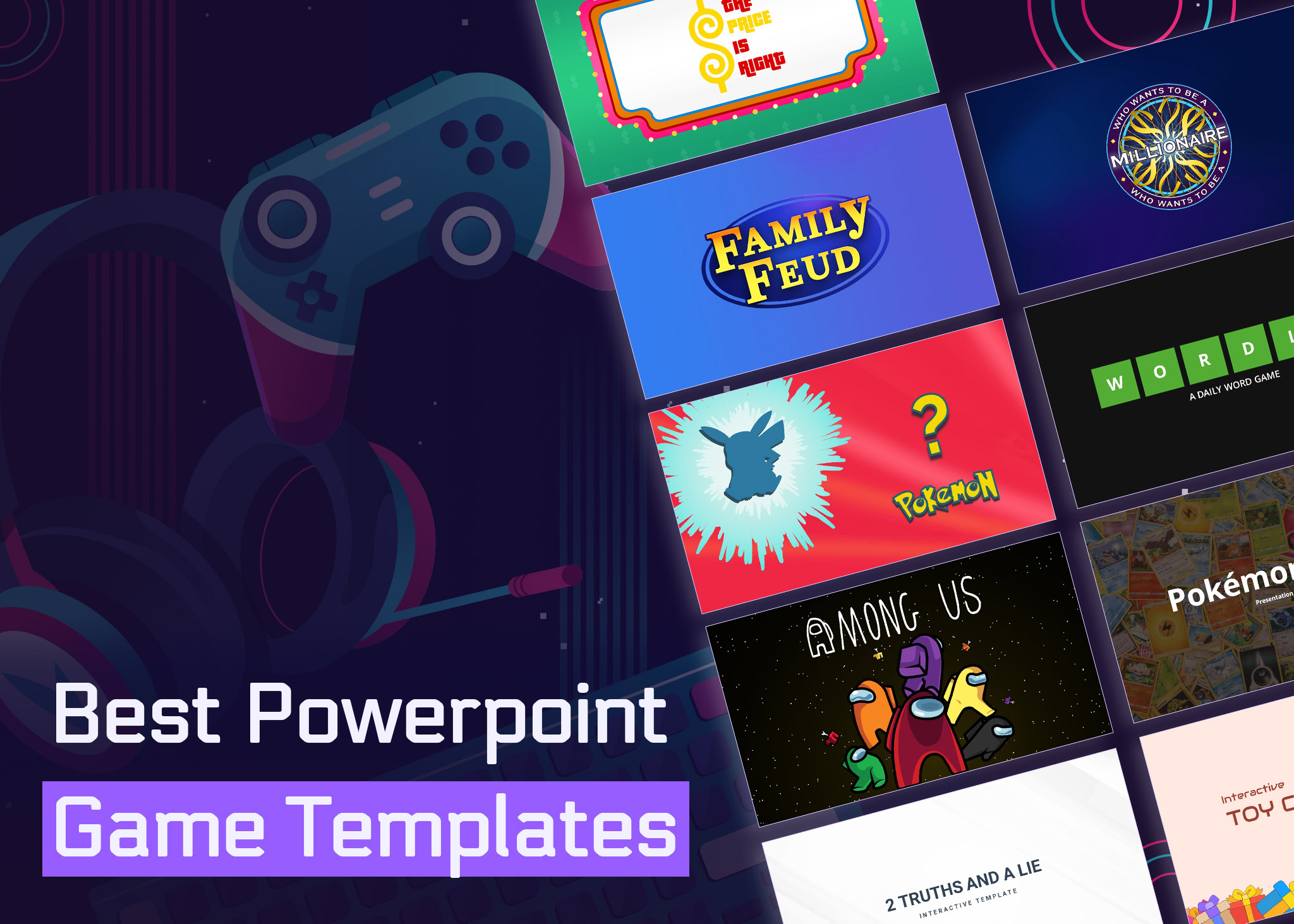
Have you heard about “Death by PowerPoint” ? Death by PowerPoint is caused by poor use of presentation software. Key contributors include confusing graphics, text-heavy slides, etc.
Today there are almost 300 million Power Point users; they do 30 million presentations daily, out of which 50 % of presentation fails.
So how to craft a presentation that doesn’t bore the audience to death? How do I make my PowerPoint fun?
It’s simple just to play fun activity PowerPoint games. Playing games, our brain releases the feel-good neurotransmitter dopamine, which keeps us active and engaged. Playing PowerPoint games during a presentation can be a fun and engaging way to keep the audience entertained and involved. Breaking the monotony of lecture-style presentation. These Microsoft PowerPoint presentation games are a great way to keep your audience entertained.
Free Interactive PowerPoint Games templates for Fun in Presentation
Fun PowerPoint games keep the audience focused, entertained, and learning. Finding fun-interactive game templates can be a daunting task. To help you out with a nerve-wracking task, in this article, we have listed the best PowerPoint games to play in your presentation. Choose the presentation best creative game template that you like and boost the presentation engagement.
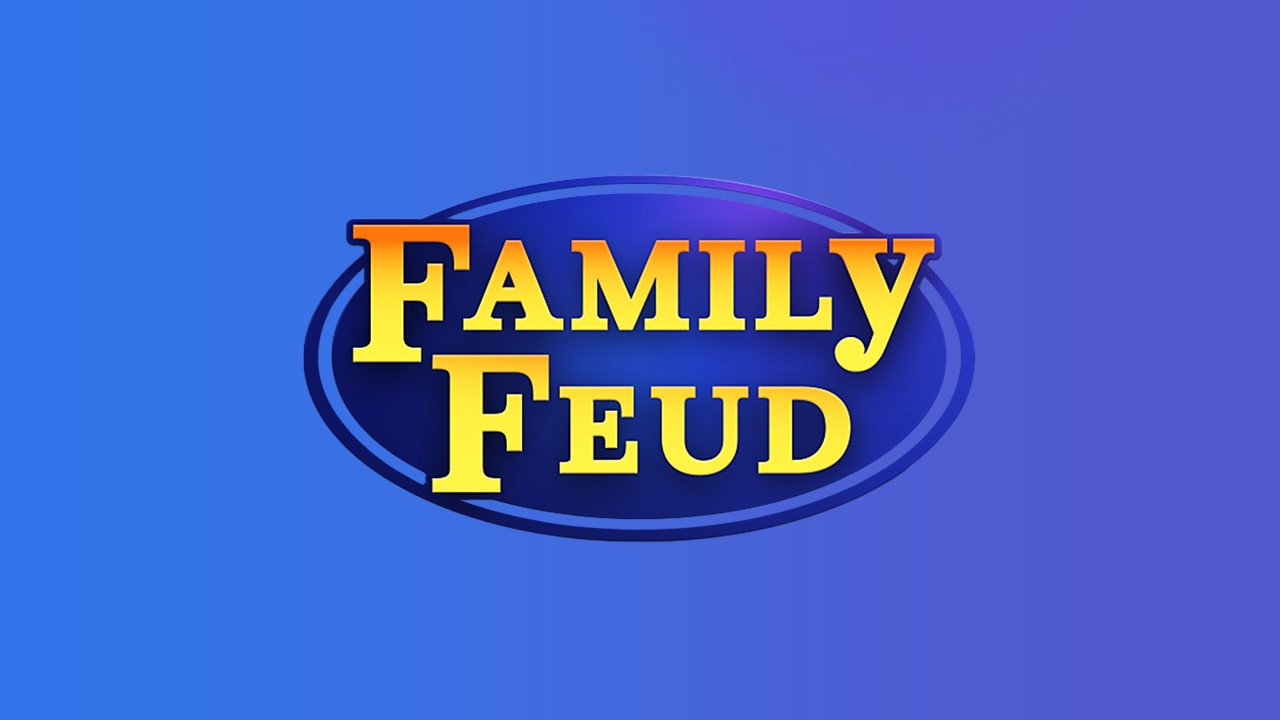
Are you a fan of the Family Feud game? Then try using this free PowerPoint interactive Family Feud game template and create your own personalized version of the popular gameshow Family Feud. We creatively designed to create a template that resembles the game set, the show’s iconic logo, colors, fonts, etc.
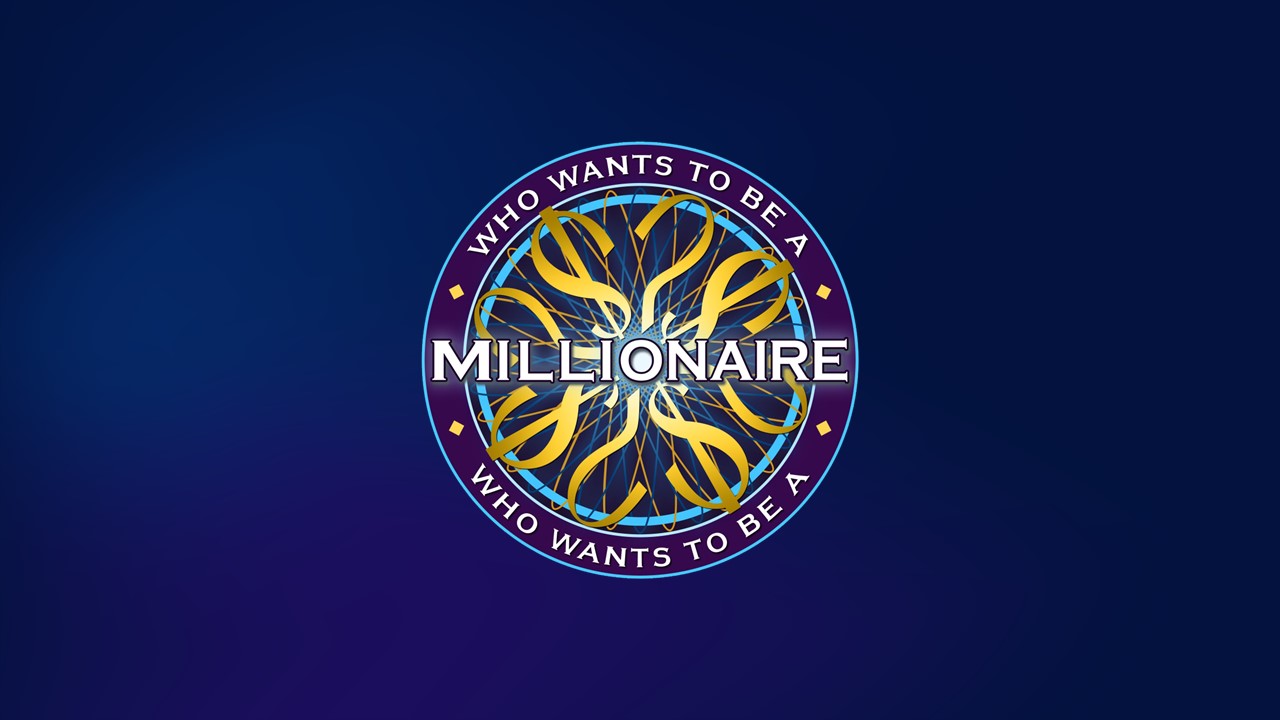
What would you do if you won million dollars? I guarantee till now; you would have started dreaming. American popular tv show who wants to be a millionaire can turn your dream of winning millions of dollars into reality. Now test the knowledge of your audience with this free interactive Who Wants to be a Millionaire-inspired template. Teachers can use this template as a game-based learning tool in the classroom. It’s an amazing memory game template using which you can test your students’ knowledge.
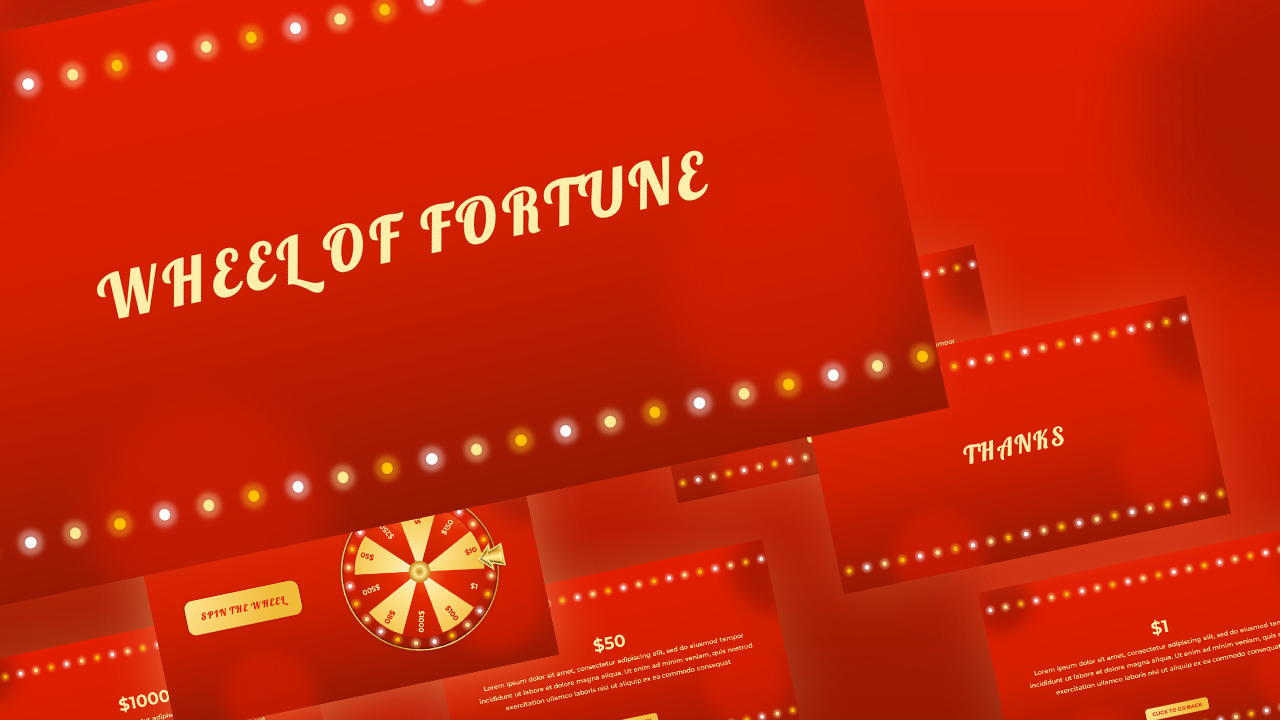
Here’s another game template, the free Wheel of Fortune game template, best for audience engagement. In this, your audience needs to click the arrow to spin the wheel in order to win the prize. In this surprise wheel game, would you rather win a huge prize or would lose it a luck game.
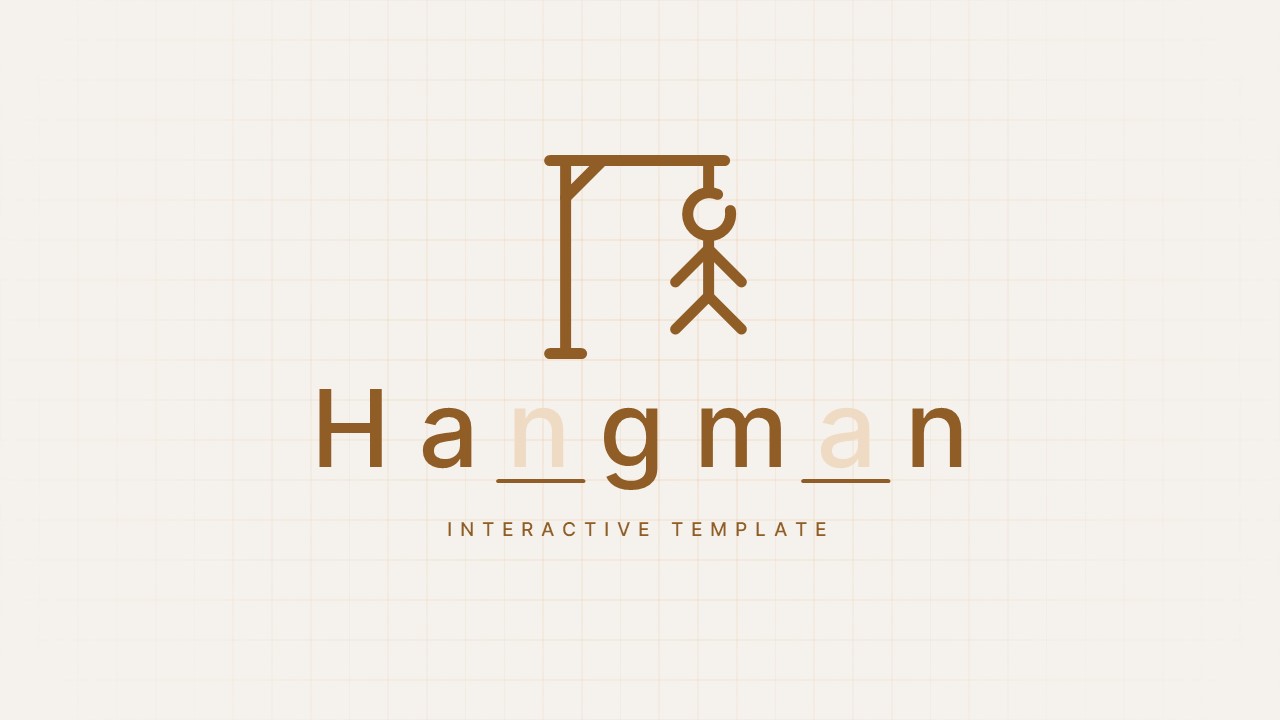
This Hangman PPT games template let’s you test your vocabulary. If you’re looking to make study a lot of fun. We’ve got you a free Hangman quiz game template. In this game template for each false answer, the hangman ropes get tight and for the correct answer the rope releases. So give the correct answer to make the hangman live.
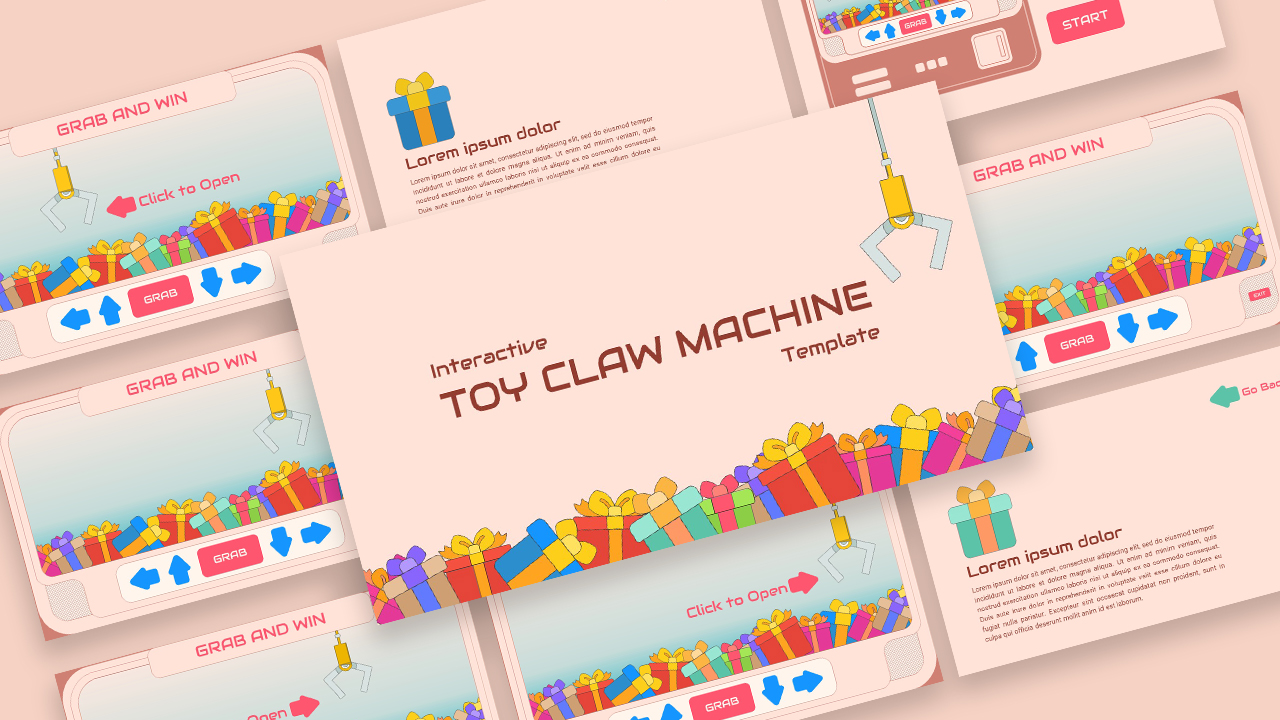
Presentation isn’t just about text-heavy slides and lectures. Sometimes presentations are too entertaining when presenters use super-creative slides like free interactive Toy claw machine templates. Play a luck game with your team using this toy claw machine slide and reward them when they win.
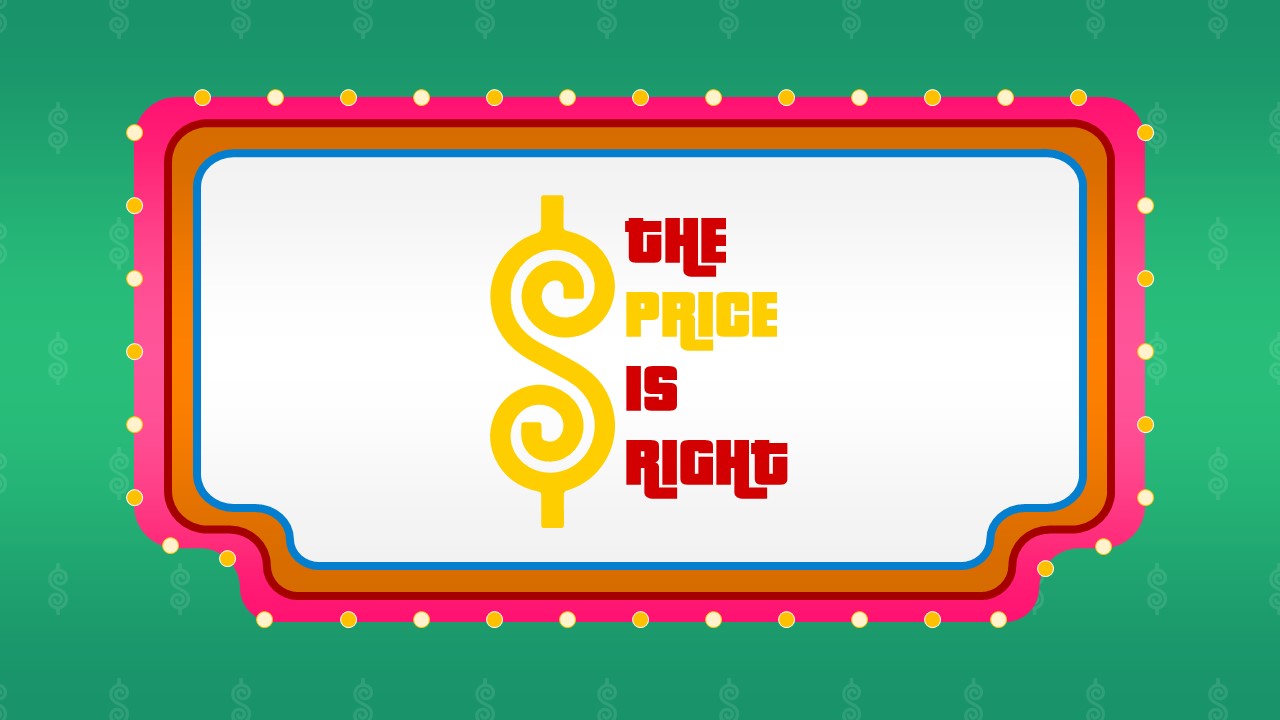
The price is right is an amazing game you can play with your team to make a presentation super-entertaining. This game template is based on the popular tv show, “The Prize is Right,” where contestants guess the price of the merchandise to win cash prizes.
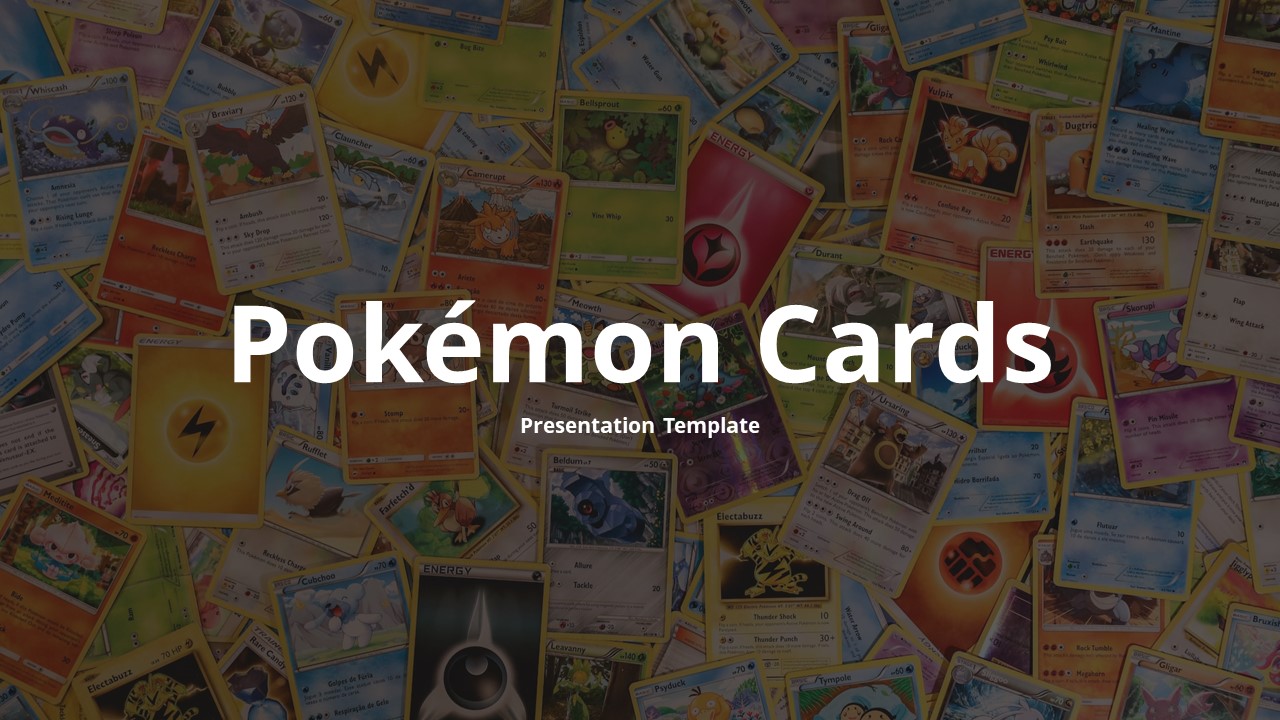
Want to have a fun time with friends and colleagues? Then try playing cool Pokémon battles in real life with this free Pokémon cards game template. It includes picture of Pokemon

Are you a true Pokémon master? Then try another fun game template based on the Pokemon theme. Test your Pokémon knowledge by guessing the Pokémon with this free animated Whos that Pokémon template. It’s an animated template with the voice of real Pokémon. It’s a quiz template that you can choose to test your knowledge of the Pokemon show.
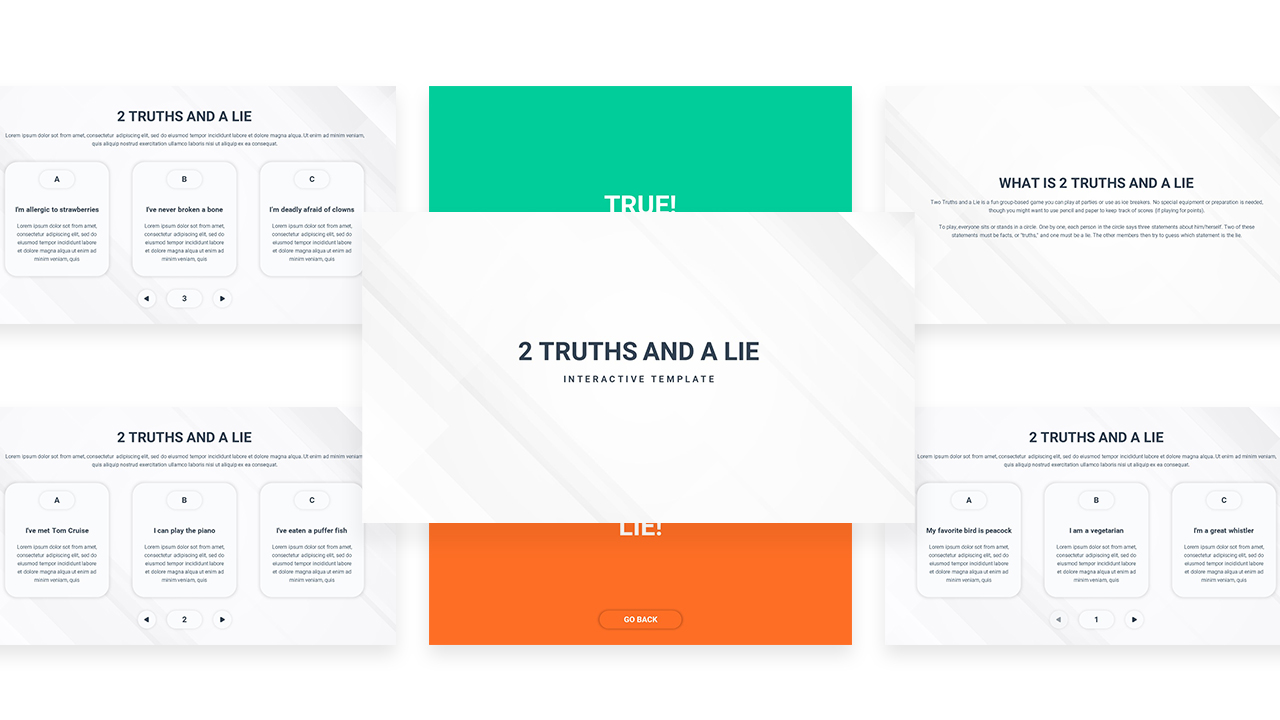
The best way to make a presentation entertaining is the engage with your audience. And best way to do this is by allowing them to know more about you. When your audience knows you, it builds a connection, and the audience will be keen to know your ideas. This free interactive Two Truths and a Lie Game PowerPoint template is the perfect game to play with the audience. It displays three options that your audience can select which applies to you.
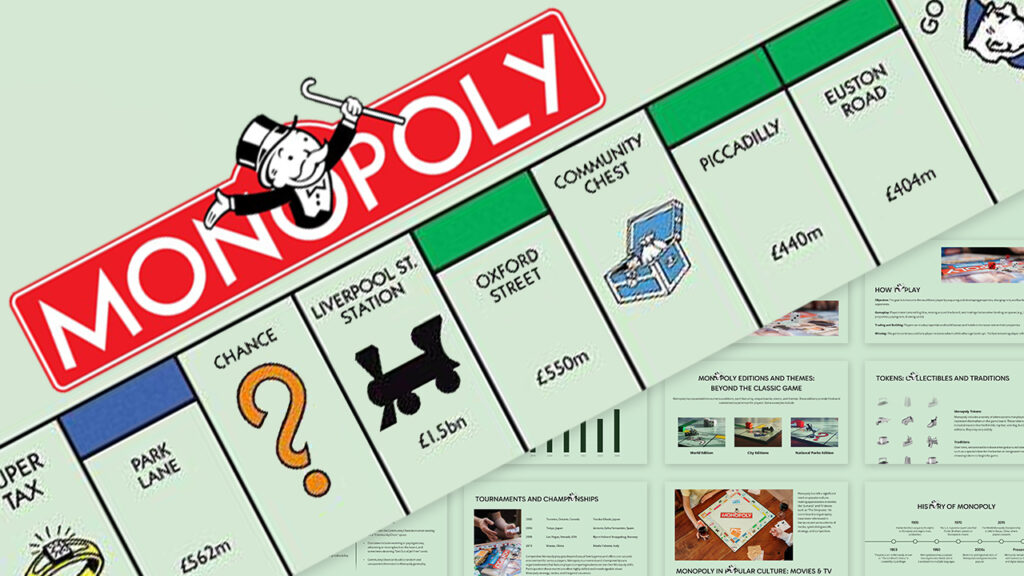
Turn your next presentation or game night into a Monopoly-style adventure! Our free, customizable template brings the classic board game to PowerPoint and Google Slides. Perfect for educators, businesses, and anyone looking to add a touch of fun and competition.
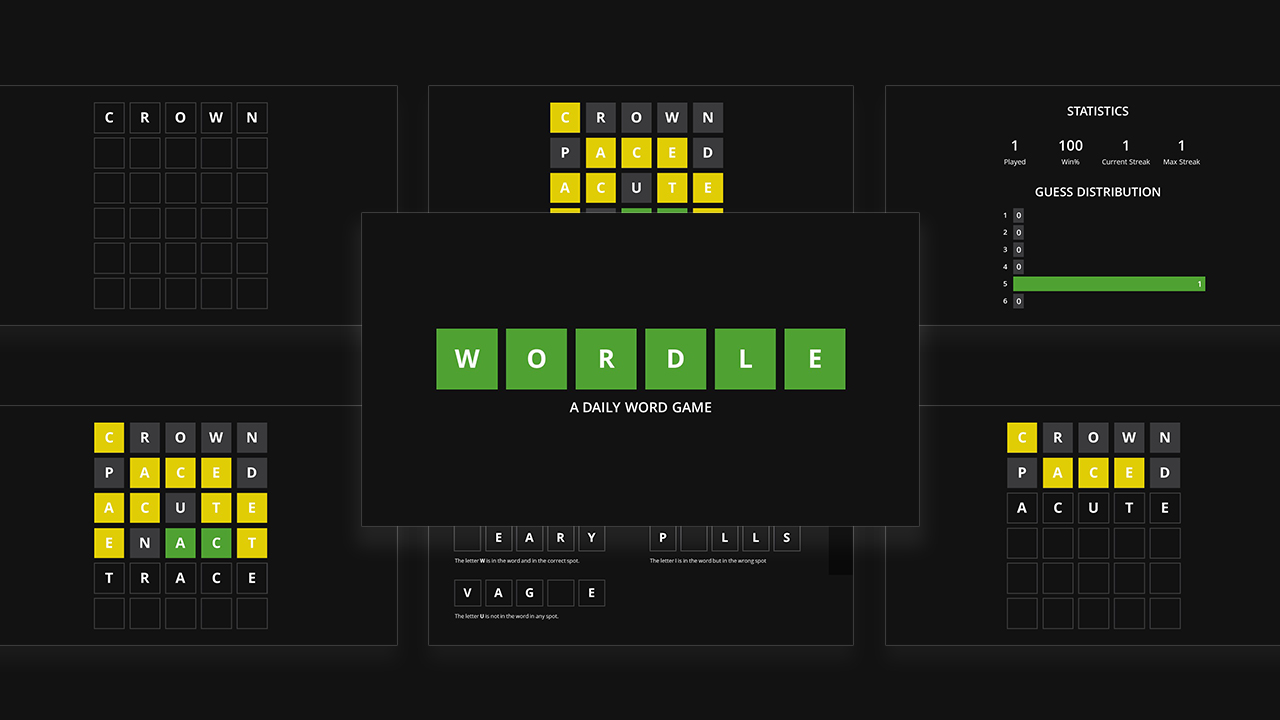
Interested in playing word games? Then why not show your vocabulary skills and test audience knowledge and memory with this free interactive Wordle game template? Download this word puzzle game is fantastic if you want your audience to be active and engaged throughout the presentation. This game template looks amazing for each correct answer the words gets green.
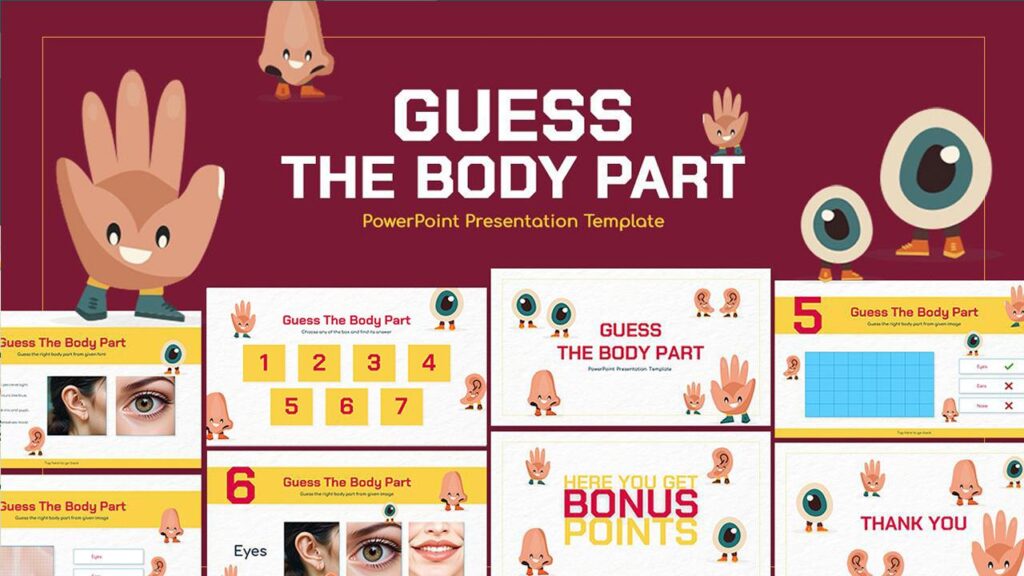
Turn human anatomy into a thrilling game show with our Guess the Body Part – PowerPoint Games template ! Designed to make learning fun and engaging, this quiz is perfect for classrooms, homeschoolers, and families. Transform biology lessons from dull to dynamic with this interactive tool.
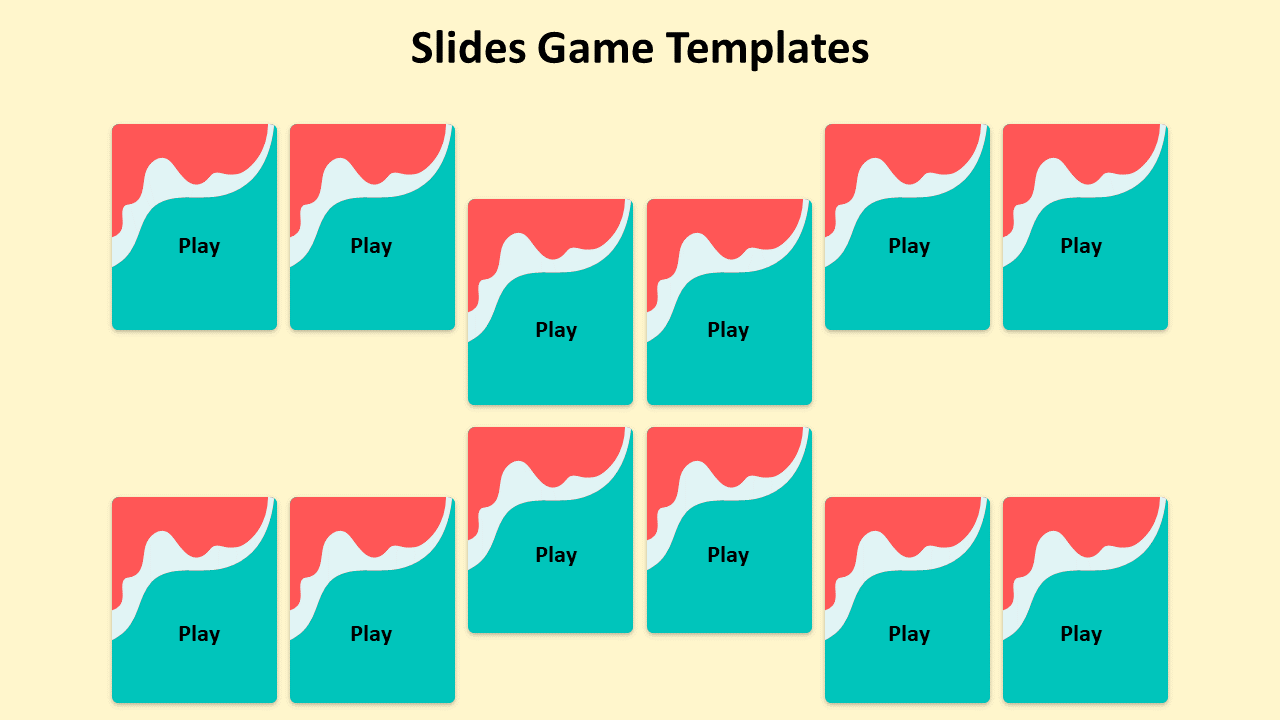
Card games are interesting; they can let you win. Let your audience try their luck with this free card game template. It’s a great game template that comes with twelve amazing gameplay buttons. This gameplay PowerPoint Presentation Games template is entirely customizable; you can easily shuffle the cards and add gifs and surprises. Choose this free card template and give your presentation a different look.
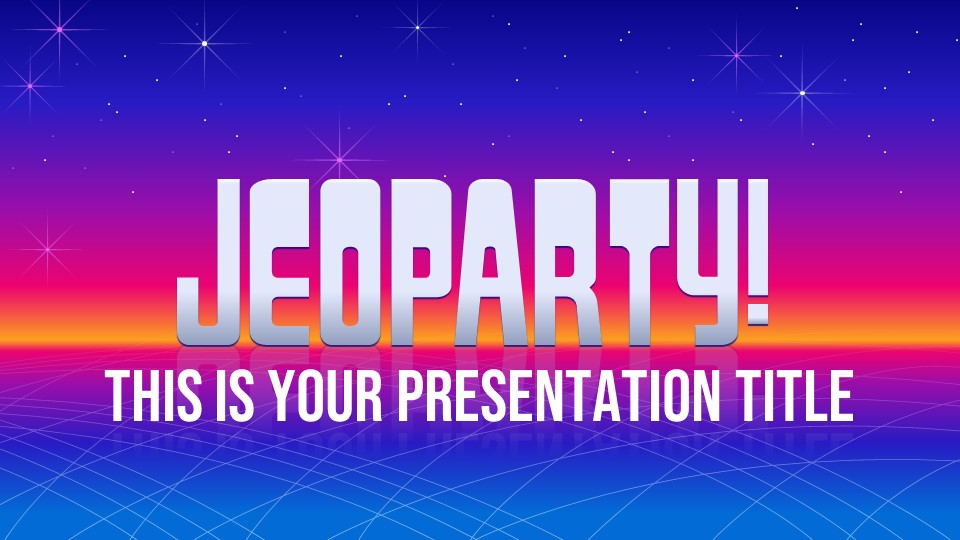
There’s nothing better than playing a game in your presentation to know your audience and build a bond. So, to make your presentation fun, we have a free Jeopardy presentation template based on the greatest American television show, Jeopardy! The player can test their luck using this free game template. Go through slides, customize them, and you’ll be ready to play with your audience.
Presentation with interactive games can make business meetings & teaching any subject more fun, especially if you reward the winners. When the audience starts enjoying the presentation, they will likely be attentive to everything you are saying. The upshot of all the above top fun PowerPoint games templates is guaranteed to make your next presentation super-entertaining.
About The Author

Priyanshu Bharat
Priyanshu is a copywriter who loves to tune into what makes people tick. He believes in presenting his ideas with flair and wit, which has made him an expert at standing on stage and charming the pants off of any audience he's faced with. Priyanshu lives for learning as much as he can, so if you ever need help understanding something - just ask!
Blog Categories
Business Management
PowerPoint Presentation
Google Slides
Latest Templates

Neymar Jr – Free PowerPoint Template and Google Slides

UCL Champions League Presentation – Free PPT & Google Slides

Electricity PowerPoint Template and Google Slides

Black and Gold Theme PowerPoint Template and Google Slides
Related blogs.
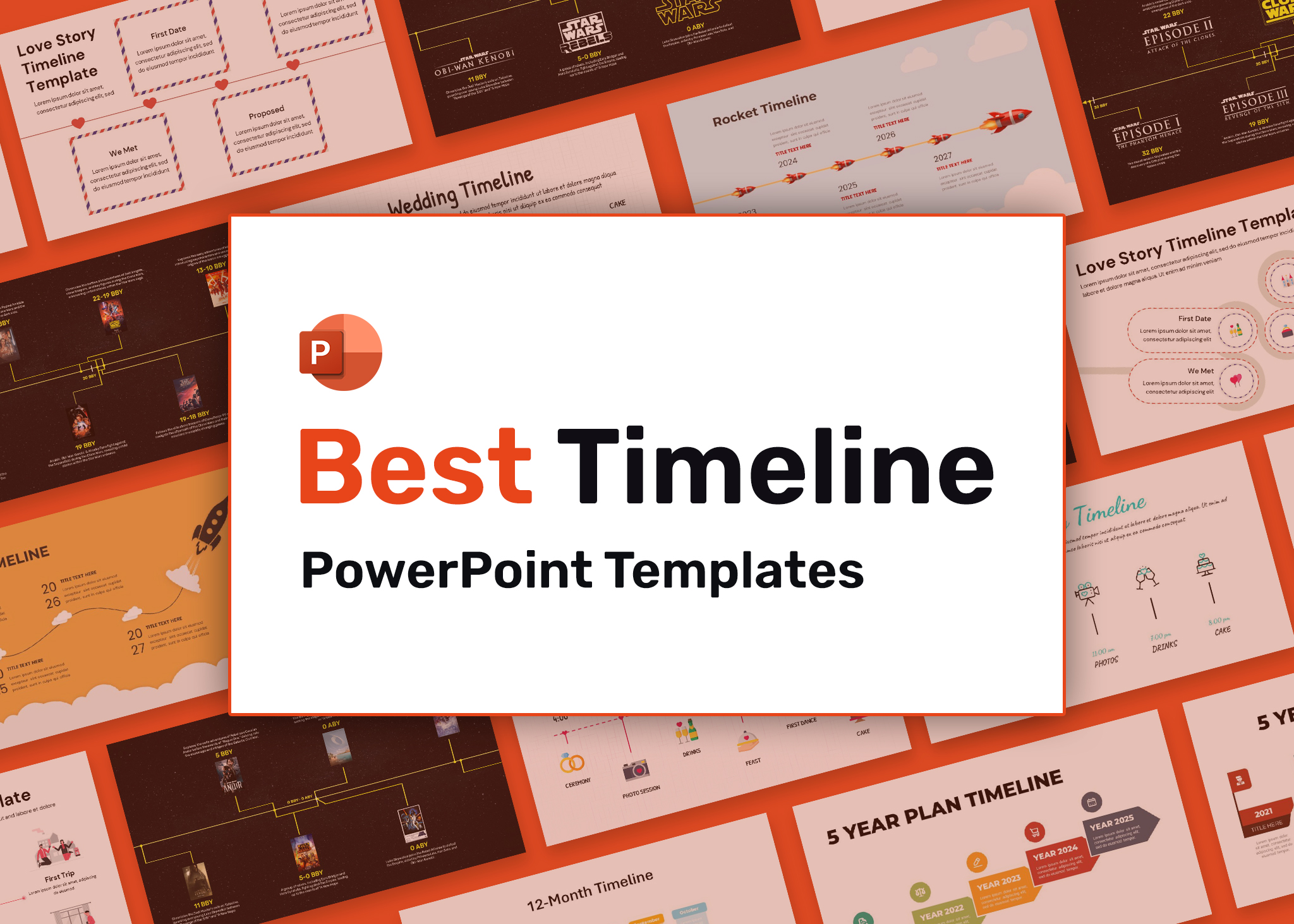
Best Free Editable Timeline Templates for PowerPoint and Google Slides
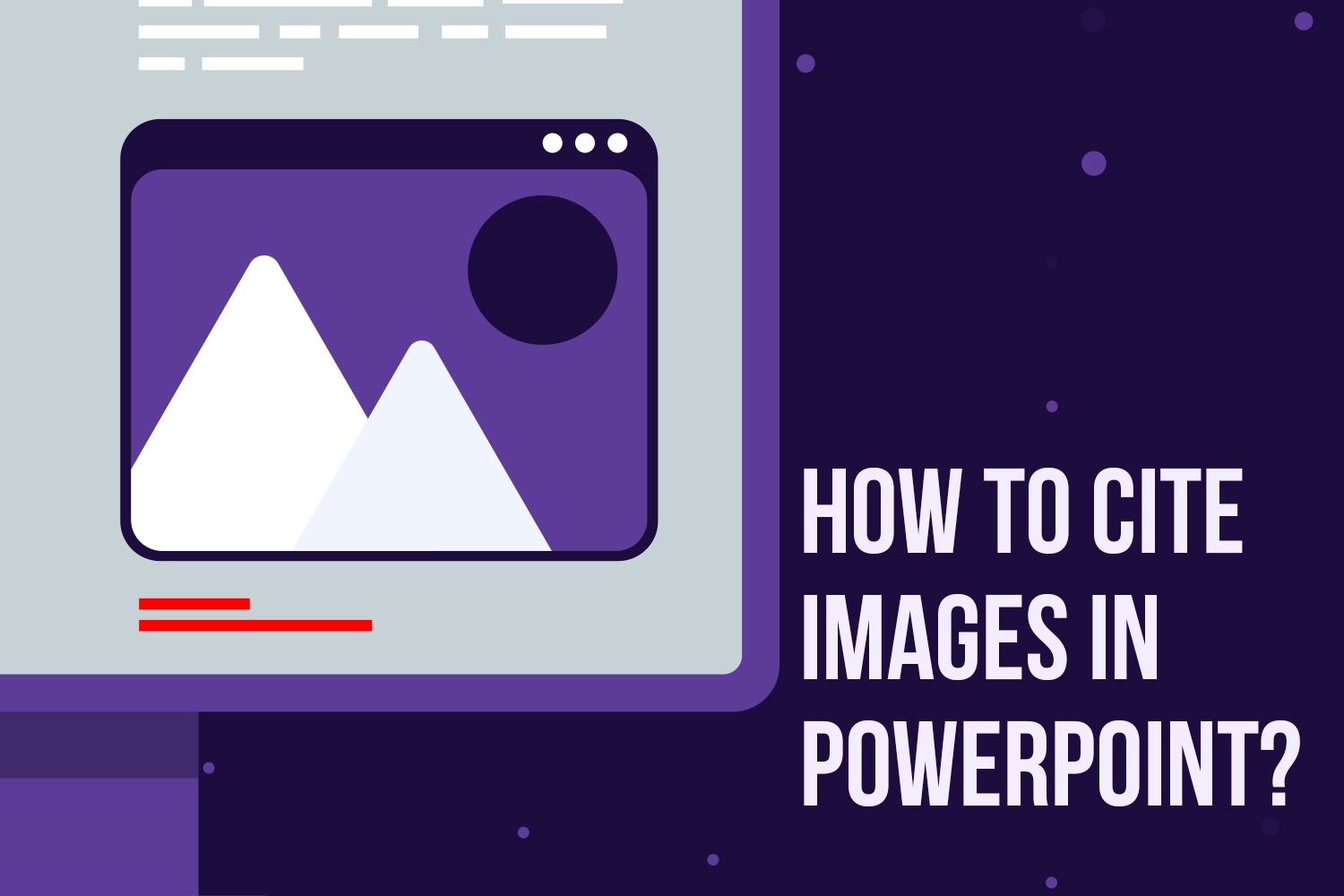
How to Cite Images in PowerPoint

Top 10 Websites to Find Free Action Plan Excel Templates
- Alternatives 🔥
10+ Fresh Interactive Presentation Ideas For Any Setting (2024 Edition)
Lakshmi Puthanveedu • 04 September, 2024 • 12 min read
With remote and hybrid work cultures coming into the picture, interactive presentations and virtual meetings have become the need of the hour.
Remote meetings and presentations are crucial to ensure work continuity and better communication. But the question is, can you make them as effective, engaging and productive as possible?
The answer is a very simple YES! Keeping the audience engaged is critical whether you are having a live or virtual meeting. Here are ten interactive presentation ideas - the really engaging presentation ideas that you can use at your next meeting or hangout!
| Why should we use interactive elements in presentations? | To boost audience engagement, improve knowledge retention, and make your presentation more memorable. |
| What are some interactive presentation ideas? | Live polls, quizzes, Q&A sessions, and even simple icebreaker questions can add interactivity. |
👉 Learn how to make a presentation interactive with AhaSlides.
Table of Contents
- Idea #1 Set some icebreaker questions
- Idea #2 Word of the Day
- Idea #3 Idea Box
- Idea #4 Deal the Cards
- Idea #5 What Would I Have Done
- Idea #6 Quizzes
- Idea #7 Use GIFs and Videos
- Idea #8 Two Truths and a Lie
- Idea #9 The Stick Game
- Idea #10 Trend a Hashtag
Frequently Asked Questions
More interactive presentation ideas w ahaslides.
- 11 Interactive presentation games to win easy engagement
- 10 Types of presentations and tips to ace them
- Interactive presentation
- How to make presentation interactive

Start in seconds.
Get free templates for your next interactive presentation. Sign up for free and take what you want from the template library!
10 Interactive Presentation Ideas
With a little help from various interactive presentation software and activities, you can stand out from the other presenters and create a productive experience for your audience. So, what is an example of an interactive presentation? Let's dive into 10 interactive presentation ideas you could imagine and truly use to keep your audience excited and engaged throughout.
Kick Off the Presentation With an Ice Breaker
The first interactive presentation idea we want to show you is setting an icebreaker part. Why?
Whether you have a casual or formal presentation, starting with an icebreaker activity is always better to excite the crowd. Most often, people start the presentation straight away to save time and skip the warming-up stage. The end result? A static audience looking dreadful like it's Friday the 13th.
Here's the deal: build a rapport with your audience before you start the presentation, and you can do this by introducing a few activities👇
Idea #1 - Set some icebreaker questions
You may not always have the same group of people attending a meeting. Sometimes there might be members who are entirely new to the group. You could use this activity to help get to know each other better.
How to Play
Ask basic icebreaker questions to get to know the audience better and give them a time limit to answer. The questions can be open-ended , where the participants can answer freely with or without a word limit. This allows them to clearly express their thoughts, giving you an excellent opportunity to open up further discussions.
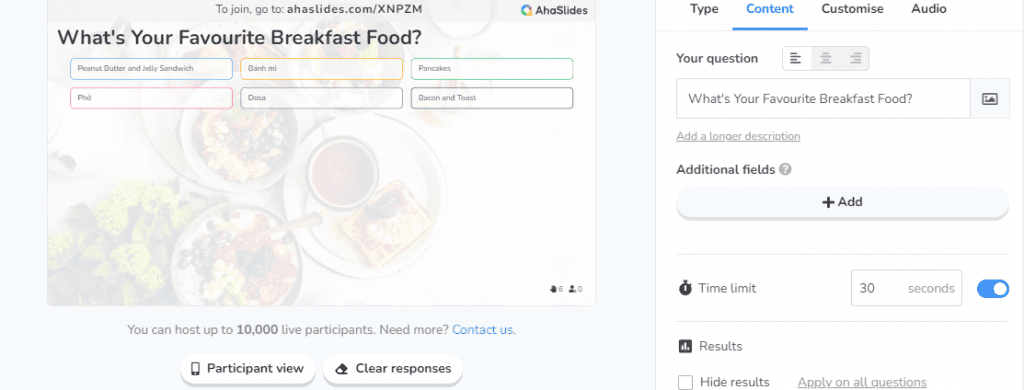
Create a Fun and Interactive Presentation With AhaSlides
There was a time when you had to sit for hours preparing and personalising presentation slides, but it doesn't have to be boring anymore. You can get a wide range of free interactive activities with AhaSlides! Sign up and create a free account today to try our online tool.

Idea #2 - Word of the Day
Sometimes, the meeting's main topic or agenda gets lost as the presentation gets long, boring and monotonous. One way to prevent this is by having the key phrase/topic throughout the presentation.
Learn the 13 golden openers to start a presentation .
The word or phrase is not revealed before the presentation. You could either divide the presentation into sections or focus on one specific topic at a time. You then ask the audience to write the word they think is the most crucial topic for the day. The words are then displayed as a live word cloud based on the popular responses, and the word with the most responses appears larger on the cloud.
This would give you, the presenter, an idea about how well the audience receives the content and help the audience understand which topic to focus on when you continue the presentation.
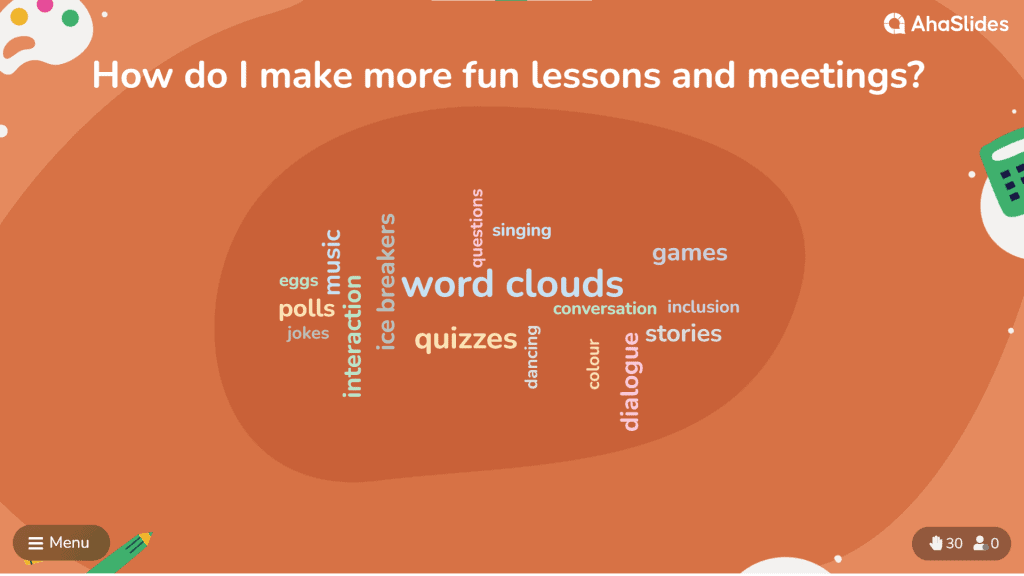
Let your audience direct
Nobody likes to sit through hours and hours of a single person talking about a topic, no matter how interesting it could be. Let the audience decide on the topic they want to learn or the presentation order. Best presentation ideas don't need to be linear! Here are some inspirational activities for you:
Idea #3 - Idea Box
People like to be asked for their opinions, and an Idea Box is a wonderful interactive presentation idea to grab your audience's attention and decide which is the best option to go forward with. Every presentation and meeting will have a Q&A at the end, and you might not be able to answer all the audience questions. This is where voting comes into the picture.
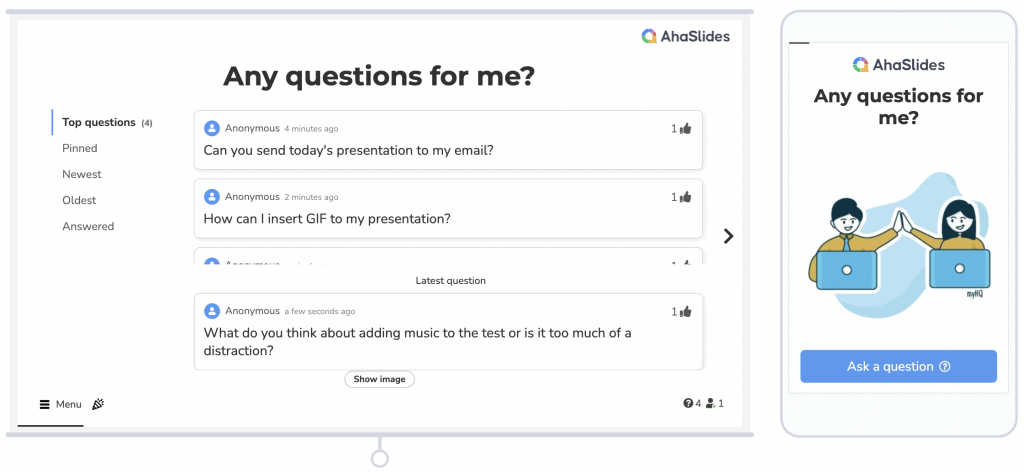
Once you are done with a specific topic in your presentation, you can ask the audience if they have any questions and collect them. When they have all shared their questions, they can upvote or downvote the available options, and you can select and answer the questions that have more votes.
These are different from polls because polls give them options to choose from, but you take their opinions into account when voting.
AhaSlides offers an Upvote feature to prioritise high-priority topics from head to toe and an anonymous feature for shy participants to voice out their opinions.
Idea #4 - Deal the Cards
It's normal for the presenter to have data and other information on the slides that could be complicated for the audience to understand. Once you finish presenting a specific topic, you could introduce a Q&A session .
In a normal presentation, only the presenter can control the slides. But suppose you are not presenting live, using an interactive presentation tool. In that case, you can let your audience go back and forth on the slides to check and clarify any information you've already presented.
You display a card (a normal slide) with specific data/numbers. Say, for example, a card with 75% on it. The audience can then go back to the slides, check what relates to the 75% and answer the question. Even if someone had missed out on an important topic, this would ensure they come across it.
Survey Your Audience
Hey, no! Don't be like that one teacher who constantly picks on the kids who aren't listening. The idea is to survey , to create an experience where everyone feels involved and make them feel that they are an important part of the presentation.
Idea #5 - What Would I Have Done Differently?
Asking them profound/fun/upbeat questions is a way to engage the audience in your talk. If you want the team to feel excited and involved, you need to provide them with an opportunity to express their opinions.
Give the audience a situation and ask them what they would have done differently if they were in that situation. AhaSlides offers an open-ended slide option where you can make the Q&A session a little more fun by allowing the audience to share their opinions as free text.
Another interactive presentation idea is to ask them if they've raised any pets/children and let them submit images in AhaSlides' open-ended slide. Talking about their favourite thing is a great way for the audience to open up.
Idea #6 - Quizzes
Need more interactive ideas for a presentation? Let's switch to quizzing time!
There's no argument that quizzes are one of the best ways to engage audience participation and make your presentation interactive. But how can you use those to your advantage during a live presentation without hunting for pen and paper?
Well, worry not! Creating fun and interactive quiz sessions is now easy and can be done in a few steps with AhaSlides.
- Step 1: Create your free AhaSlides account
- Step 2: Pick your desired template, or you can start with a blank one and use the AI slide generator to help create quiz questions
- Step 3: Fine-tune, test and present it in front of the live audience. Your participants can access the quiz easily via smartphones.
Lack of games in mind? Here are some interactive presentation games to get you started.
Bring in Humor as Your Ally
Even when it's interactive, sometimes the long presentations can drain the energy and excitement out of the presenter and the audience. Jokes and memes are other interactive presentation examples that you can use to lighten the mood and engage your audience.
Idea #7 - Use GIFs and Videos
The audience will remember the presentation and the topic better when you tie it up with pictures and GIFs. If you are looking for a perfect way to break the ice or lighten the mood during a presentation, this is one of the perfect ideas for interactive presentations.
Show the participants a poll with a number of images or GIFs related to the question. Say, for example - Which Otter Describes Your Mood? The polls can have pictures or GIFs of funny otters, and the audience could pick their choice. Once everyone has chosen their option, the presenter can display the results on the screen.
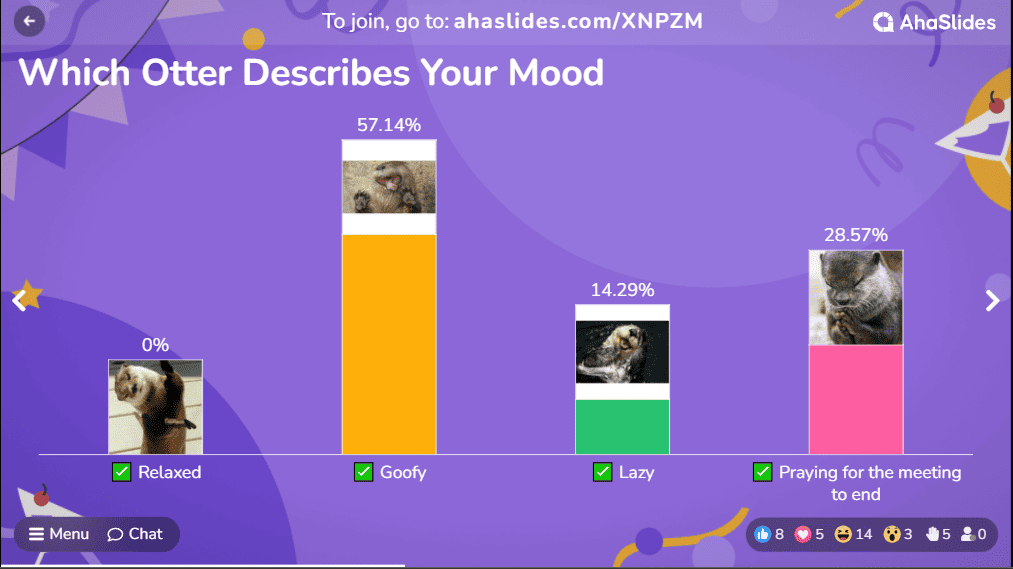
Idea #8 - Two Truths and a Lie
If you want to make the audience think and entertain them at the same time, this is one of the best interactive presentation examples you can use. Interactive presentation ideas like Two Truths and a Lie can make your talk double fun and fascinating.
- Step 1: Give the audience a statement about the topic you are presenting
- Step 2: Give 3 options for them to choose from, including two true facts and a lie about the statement
- Step 3: Ask them to find the lie among the answers

Use Props in Your Presentation
Sometimes, giving the audience something to focus on other than the presentation helps. The idea is to engage them in a fun interactive presentation without taking away the topic's essence.
Idea #9 - The Stick Game
An interactive presentation example of this idea is the stick game, which is pretty simple. You give the audience a "talking stick". The person who has the stick with them can ask a question or share their opinion during the presentation.
This game is most suitable for when you are in a physical meeting setting. You might be using a digital presentation tool, but using a traditional prop method can be easy sometimes and different. You ask the audience to pass the talking stick around when they want to speak, and you could either address it right away or note it down for Q&A later.
🎊 Tips: Best Q&A Apps to Engage With Your Audience | 5+ Platforms For Free in 2024
Idea #10 - Trend a Hashtag
Creating a buzz about a specific topic can excite any crowd, and that is exactly what can be done with the help of social media.
Before the presentation, maybe even a couple of days back, the presenter can start a Twitter hashtag for the set topic and ask the teammates to join in and share their thoughts and questions. The entries are taken only until the day of the presentation, and you can even set a time limit.
Gather the entries from Twitter, and at the end of the presentation, you can pick and discuss a few of them like a generic discussion.
With our ideas for an interactive presentation above, hope you'll make your speech awesome that everyone will remember!
These interactive presentation ideas are all here for the same goal - for both the presenter and the audience to have a casual, confident and productive time. Bid goodbye to mundane, long static meetings and jump into the world of interactive presentations with AhaSlides. Sign up for free today to explore our template library.
Why are interactive presentation ideas important?
Interactive presentation ideas are important as they help to keep the audience engaged and interested throughout the presentation. Interactive elements can break up the monotony of a one-way presentation and provide opportunities for the audience to actively participate, which can enhance learning and retention.
Why are interactive presentations beneficial to students?
Interactive presentation ideas for students are valuable ways to enhance their learning experience. They can promote active learning, personalised instruction, and collaboration, all of which can contribute to improved academic performance and student success.
What are the benefits of interactive presentation in the workplace?
Interactive presentations are effective tools for communication, promoting engagement, learning, decision-making, and motivation in the workplace. By utilising this technique, organisations can foster a culture of continuous learning and development, leading to improved employee performance and business success.

Lakshmi Puthanveedu
A small-town girl enthralled by culture, languages, and sunsets. Casual artist and musician looking to make memories every step of the way. Now changing the way humans live and have virtual interactions with AhaSlides.
Tips to Engage with Polls & Trivia
More from AhaSlides

12 Interactive PowerPoint Activities Your Students will Love

At Slides with Friends, we're all about trying to make your life as a teacher a little bit easier. We want to provide as many tools, tips, and as much support as possible. That's why we share on topics like Review Games , Student Wellness Activities , and Tools for Measuring Student Engagement .
While we usually focus on how you can use Slides with Friends specifically, we want to bring you something a little different this time. We've compiled 12 of our favorite interactive PowerPoint activities you can use with your students. All of the activities are designed to engage your students in ways they'll love. Even better, these activities let you use a tool you're probably already familiar with.
And read to the end for an exciting new announcement!
Annotated Images
Annotated images let you teach history (or literature! or geography!) using detailed annotated images from your latest lesson. We're big fans of using visuals in the classroom. And with good reason! A study released by the Journal of Education and Practice found visual information is mapped better in students' minds across multiple types of thinking skills. By introducing more visuals to a lesson plan, and using tools like PowerPoint, lessons are more likely to be remembered.

You can introduce annotated images on PowerPoint by picking out relevant images and adding captions or labels to them and presenting them as you teach. You can add descriptions, draw arrows, or points of interest on the image.
Check out this fun example from Ditch That Textbook .
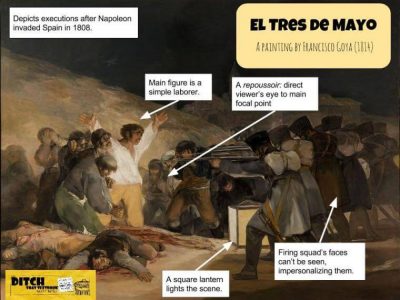
Even better, provide a few unique images of the lesson you just presented and have the students create their own annotations. Then, as a class, have each student present their image in PowerPoint.
Photos as Story Prompts
More visual learning! Using photos as storytelling prompts can be a great way to spark your student's creativity! PowerPoint is an ideal platform to display the photos, as it provides you the flexibility and versatility to show one photo at a time in case you want the students to focus exclusively on that image.
Simply ask them to write a story based on the photo in 1-3 sentences, and compare answers afterward. Encouraging different interpretations of a single image also helps foster critical thinking skills and encourages students to use their own perspectives when expressing their ideas.
Interactive Maps
Interactive maps are a fantastic way for students to learn about their world without leaving the classroom! And one of the easiest ways to show off these maps is through PowerPoint. Plus, PowerPoint makes adding hyperlinks to specific places (like pins), so you can click through areas of interest without having to open up a separate browser page.
If you're looking for a simple tutorial on how to create a lesson-based interactive map, check out this one from eLearning Industry . For more exploratory maps, check out the tutorial below (which includes the free template!).
Battleship Review Game
We love a good game here at Slides with Friends, so it shouldn't be a surprise to see so many options on this list. However, before doing research for this article, we had no idea Battleship could be played on PowerPoint!
In the template below, you can add words and to reveal the space beneath the words, students have to:
- Conjugate the Verb
- Use the Word in a Sentence
- Define the Word
Or one of any fun combinations.
We love this idea for language classes especially, but can also be used for vocabulary in any subject.
You can check out the whole presentation here.
Crossword Puzzle
Crossword puzzles are a timeless and popular way of testing knowledge and keeping minds alert. They can be used in the classroom to reinforce concepts and skills related to any subject, making them a great teaching tool. Crosswords can help students learn new vocabulary words, polish their grammar, understand history or science topics better, or firm up mathematics concepts.
And an easy way to do a crossword in the classroom is by using PowerPoint. You simply need to create a blank and a filled puzzle on PowerPoint and then fill it out with your class.
Check out this step-by-step guide on the best way to quickly create a crossword puzzle in PowerPoint.
Tests and quizzes are absolutely no fun, so if you can find an easy way to quiz your students in a fun way, that's a win-win! One of our favorite ways to do this is by creating a quiz show on PowerPoint.
By using those hyperlinks we mentioned above, you can easily create your own questions, assign point values, and include sound effects (or music!) to make your students feel like they're actually in a game show!
This 6 Steps to Create a Multiple Choice Quiz is a great way to start designing your next PowerPoint quiz. If you're looking for multiple ways to create a quiz show for your students, check out the detailed tutorial below .
Video Gallery
We've talked quite a bit about visuals here, not just because PowerPoint is a great tool for visuals, but because visuals are so extremely helpful in the classroom.
One way to incorporate visual activities into your classes with PowerPoint is by creating video galleries. This is especially useful if you have limited access to videos and need to play them in a certain order.
You can create a video gallery presentation by manually inserting the clips into slides or creating a series of hyperlinks to take the class through certain processes. You can also add captions, notes, and questions for further discussion.
Scavenger Hunt
A fun activity to incorporate in your classroom through the power of PowerPoint is a review scavenger hunt.
Scavenger hunts can be an engaging way to go over the material and test knowledge at the beginning or end of a unit. PowerPoint is a great tool to use when designing a scavenger hunt if you are working with students online. With the tool, you can hide clues in images, ask questions that are linked to hyperlinks, and even add video clips as hints.
Scavenger hunts also offer quite a bit of versatility in the classroom. You can have students work individually or in groups, depending on your goals for the lesson.
You can reference our Virtual Scavenger Hunt guide, which includes several hunt lists, for ideas on what to bring to your students.
Choose Your Own Adventure
PowerPoint slides can also be used to create engaging interactive experiences. PowerPoint's slide-linking feature allows you to jump between slides with the click of a button, providing users with their own “Choose Your Own Adventure”-style gaming experience. As a result, you can create an interactive story with a different ending each and every time.
While this activity will take quite a bit of upfront work, once you have it done, you can use it for countless classes.
We highly recommend this tutorial by The Training Lady on how to plan out your next PowerPoint adventure!
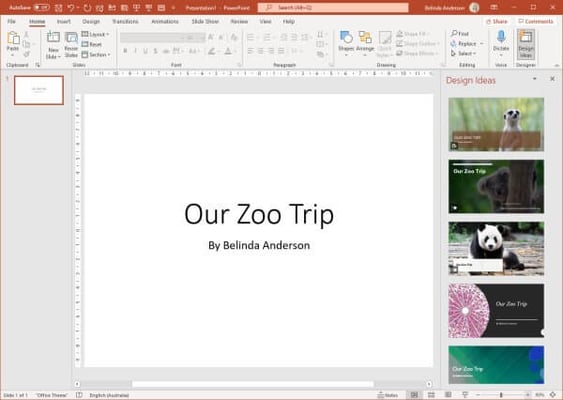
Picture Reveal
Picture Reveal is a great PowerPoint activity that encourages students to think critically. In this activity, you can present an obscured picture and provides clues as to what it could be. Students must then utilize their knowledge and logic skills to work out what the picture is by eliminating incorrect answers based on the clues provided until they eventually get the correct answer.
Picture reveals are a great way to review material from previous lessons or current topics. They can also act as an introduction to a new lesson. Plus, we can't stress this enough, visuals!
Word Search
Word search games are a great way to review vocabulary and help students learn new words. Using PowerPoint, you can create custom word searches by entering the target vocabulary words in a grid. Then draw lines connecting each letter to form words! You can even add visuals that correspond with the theme of your word search for an extra challenge.
Word search games are perfect for when you have some leftover time during class or if you want to review material from earlier units. A PowerPoint word search is also great for helping students recognize spelling patterns in unfamiliar words and promoting active learning as they look for the hidden words in the puzzle.
Student Presentation

One of the best ways to get your students engaged in the classroom is to have them lead the show. And PowerPoint is such an awesome tool for students to present their own material.
With a little guidance, you can have older students create mini-presentations about topics they've studied in class or even on their own. Not only will this allow you to assess what they've retained from studying, but it also allows your students to practice public speaking skills and become more comfortable with online presentations - essential in today's digital world!
With PowerPoint, you can easily turn any student project into an engaging presentation everyone will enjoy.
Use Slides with Friends for Your PowerPoint Activities
PowerPoint has been a vital tool in the teacher toolbox for decades. There are so many fantastic ways to use PowerPoint to engage and interact with your classroom.
Slides with Friends is excited to announce a new feature for our slide decks - A PowerPoint upload!
Now you can create your slides in an already-known program, or use slide shows you've already made, and with a click of a button upload them to Slides with Friends!

Slides with Friends brings classroom PowerPoint activities to the next level by enabling real-time collaborative engagement from all of your students. By combining your PowerPoint presentations with Slides with Friends live word clouds, polling, trivia, and quizzes, as well as photo sharing, you really can fully involve your students in every lesson.
Subscribe for more articles like this
Try slides with friends for free.
The easiest way to host meetings your team will love
Engagement delivered to your inbox
We'll email you 1-2x per month with brand new, ready-to-run events and ideas. Subscribe to stay ahead of the curve and keep your lessons, meetings, and events fresh and engaging.
We use essential cookies to make Venngage work. By clicking “Accept All Cookies”, you agree to the storing of cookies on your device to enhance site navigation, analyze site usage, and assist in our marketing efforts.
Manage Cookies
Cookies and similar technologies collect certain information about how you’re using our website. Some of them are essential, and without them you wouldn’t be able to use Venngage. But others are optional, and you get to choose whether we use them or not.
Strictly Necessary Cookies
These cookies are always on, as they’re essential for making Venngage work, and making it safe. Without these cookies, services you’ve asked for can’t be provided.
Show cookie providers
- Google Login
Functionality Cookies
These cookies help us provide enhanced functionality and personalisation, and remember your settings. They may be set by us or by third party providers.
Performance Cookies
These cookies help us analyze how many people are using Venngage, where they come from and how they're using it. If you opt out of these cookies, we can’t get feedback to make Venngage better for you and all our users.
- Google Analytics
Targeting Cookies
These cookies are set by our advertising partners to track your activity and show you relevant Venngage ads on other sites as you browse the internet.
- Google Tag Manager
- Infographics
- Daily Infographics
- Popular Templates
- Accessibility
- Graphic Design
- Graphs and Charts
- Data Visualization
- Human Resources
- Beginner Guides
Blog Beginner Guides How To Make a Good Presentation [A Complete Guide]
How To Make a Good Presentation [A Complete Guide]
Written by: Krystle Wong Jul 20, 2023

A top-notch presentation possesses the power to drive action. From winning stakeholders over and conveying a powerful message to securing funding — your secret weapon lies within the realm of creating an effective presentation .
Being an excellent presenter isn’t confined to the boardroom. Whether you’re delivering a presentation at work, pursuing an academic career, involved in a non-profit organization or even a student, nailing the presentation game is a game-changer.
In this article, I’ll cover the top qualities of compelling presentations and walk you through a step-by-step guide on how to give a good presentation. Here’s a little tip to kick things off: for a headstart, check out Venngage’s collection of free presentation templates . They are fully customizable, and the best part is you don’t need professional design skills to make them shine!
These valuable presentation tips cater to individuals from diverse professional backgrounds, encompassing business professionals, sales and marketing teams, educators, trainers, students, researchers, non-profit organizations, public speakers and presenters.
No matter your field or role, these tips for presenting will equip you with the skills to deliver effective presentations that leave a lasting impression on any audience.
Click to jump ahead:
What are the 10 qualities of a good presentation?
Step-by-step guide on how to prepare an effective presentation, 9 effective techniques to deliver a memorable presentation, faqs on making a good presentation, how to create a presentation with venngage in 5 steps.
When it comes to giving an engaging presentation that leaves a lasting impression, it’s not just about the content — it’s also about how you deliver it. Wondering what makes a good presentation? Well, the best presentations I’ve seen consistently exhibit these 10 qualities:
1. Clear structure
No one likes to get lost in a maze of information. Organize your thoughts into a logical flow, complete with an introduction, main points and a solid conclusion. A structured presentation helps your audience follow along effortlessly, leaving them with a sense of satisfaction at the end.
Regardless of your presentation style , a quality presentation starts with a clear roadmap. Browse through Venngage’s template library and select a presentation template that aligns with your content and presentation goals. Here’s a good presentation example template with a logical layout that includes sections for the introduction, main points, supporting information and a conclusion:

2. Engaging opening
Hook your audience right from the start with an attention-grabbing statement, a fascinating question or maybe even a captivating anecdote. Set the stage for a killer presentation!
The opening moments of your presentation hold immense power – check out these 15 ways to start a presentation to set the stage and captivate your audience.
3. Relevant content
Make sure your content aligns with their interests and needs. Your audience is there for a reason, and that’s to get valuable insights. Avoid fluff and get straight to the point, your audience will be genuinely excited.
4. Effective visual aids
Picture this: a slide with walls of text and tiny charts, yawn! Visual aids should be just that—aiding your presentation. Opt for clear and visually appealing slides, engaging images and informative charts that add value and help reinforce your message.
With Venngage, visualizing data takes no effort at all. You can import data from CSV or Google Sheets seamlessly and create stunning charts, graphs and icon stories effortlessly to showcase your data in a captivating and impactful way.

5. Clear and concise communication
Keep your language simple, and avoid jargon or complicated terms. Communicate your ideas clearly, so your audience can easily grasp and retain the information being conveyed. This can prevent confusion and enhance the overall effectiveness of the message.
6. Engaging delivery
Spice up your presentation with a sprinkle of enthusiasm! Maintain eye contact, use expressive gestures and vary your tone of voice to keep your audience glued to the edge of their seats. A touch of charisma goes a long way!
7. Interaction and audience engagement
Turn your presentation into an interactive experience — encourage questions, foster discussions and maybe even throw in a fun activity. Engaged audiences are more likely to remember and embrace your message.
Transform your slides into an interactive presentation with Venngage’s dynamic features like pop-ups, clickable icons and animated elements. Engage your audience with interactive content that lets them explore and interact with your presentation for a truly immersive experience.

8. Effective storytelling
Who doesn’t love a good story? Weaving relevant anecdotes, case studies or even a personal story into your presentation can captivate your audience and create a lasting impact. Stories build connections and make your message memorable.
A great presentation background is also essential as it sets the tone, creates visual interest and reinforces your message. Enhance the overall aesthetics of your presentation with these 15 presentation background examples and captivate your audience’s attention.
9. Well-timed pacing
Pace your presentation thoughtfully with well-designed presentation slides, neither rushing through nor dragging it out. Respect your audience’s time and ensure you cover all the essential points without losing their interest.
10. Strong conclusion
Last impressions linger! Summarize your main points and leave your audience with a clear takeaway. End your presentation with a bang , a call to action or an inspiring thought that resonates long after the conclusion.
In-person presentations aside, acing a virtual presentation is of paramount importance in today’s digital world. Check out this guide to learn how you can adapt your in-person presentations into virtual presentations .

Preparing an effective presentation starts with laying a strong foundation that goes beyond just creating slides and notes. One of the quickest and best ways to make a presentation would be with the help of a good presentation software .
Otherwise, let me walk you to how to prepare for a presentation step by step and unlock the secrets of crafting a professional presentation that sets you apart.
1. Understand the audience and their needs
Before you dive into preparing your masterpiece, take a moment to get to know your target audience. Tailor your presentation to meet their needs and expectations , and you’ll have them hooked from the start!
2. Conduct thorough research on the topic
Time to hit the books (or the internet)! Don’t skimp on the research with your presentation materials — dive deep into the subject matter and gather valuable insights . The more you know, the more confident you’ll feel in delivering your presentation.
3. Organize the content with a clear structure
No one wants to stumble through a chaotic mess of information. Outline your presentation with a clear and logical flow. Start with a captivating introduction, follow up with main points that build on each other and wrap it up with a powerful conclusion that leaves a lasting impression.
Delivering an effective business presentation hinges on captivating your audience, and Venngage’s professionally designed business presentation templates are tailor-made for this purpose. With thoughtfully structured layouts, these templates enhance your message’s clarity and coherence, ensuring a memorable and engaging experience for your audience members.
Don’t want to build your presentation layout from scratch? pick from these 5 foolproof presentation layout ideas that won’t go wrong.

4. Develop visually appealing and supportive visual aids
Spice up your presentation with eye-catching visuals! Create slides that complement your message, not overshadow it. Remember, a picture is worth a thousand words, but that doesn’t mean you need to overload your slides with text.
Well-chosen designs create a cohesive and professional look, capturing your audience’s attention and enhancing the overall effectiveness of your message. Here’s a list of carefully curated PowerPoint presentation templates and great background graphics that will significantly influence the visual appeal and engagement of your presentation.
5. Practice, practice and practice
Practice makes perfect — rehearse your presentation and arrive early to your presentation to help overcome stage fright. Familiarity with your material will boost your presentation skills and help you handle curveballs with ease.
6. Seek feedback and make necessary adjustments
Don’t be afraid to ask for help and seek feedback from friends and colleagues. Constructive criticism can help you identify blind spots and fine-tune your presentation to perfection.
With Venngage’s real-time collaboration feature , receiving feedback and editing your presentation is a seamless process. Group members can access and work on the presentation simultaneously and edit content side by side in real-time. Changes will be reflected immediately to the entire team, promoting seamless teamwork.

7. Prepare for potential technical or logistical issues
Prepare for the unexpected by checking your equipment, internet connection and any other potential hiccups. If you’re worried that you’ll miss out on any important points, you could always have note cards prepared. Remember to remain focused and rehearse potential answers to anticipated questions.
8. Fine-tune and polish your presentation
As the big day approaches, give your presentation one last shine. Review your talking points, practice how to present a presentation and make any final tweaks. Deep breaths — you’re on the brink of delivering a successful presentation!
In competitive environments, persuasive presentations set individuals and organizations apart. To brush up on your presentation skills, read these guides on how to make a persuasive presentation and tips to presenting effectively .

Whether you’re an experienced presenter or a novice, the right techniques will let your presentation skills soar to new heights!
From public speaking hacks to interactive elements and storytelling prowess, these 9 effective presentation techniques will empower you to leave a lasting impression on your audience and make your presentations unforgettable.
1. Confidence and positive body language
Positive body language instantly captivates your audience, making them believe in your message as much as you do. Strengthen your stage presence and own that stage like it’s your second home! Stand tall, shoulders back and exude confidence.
2. Eye contact with the audience
Break down that invisible barrier and connect with your audience through their eyes. Maintaining eye contact when giving a presentation builds trust and shows that you’re present and engaged with them.
3. Effective use of hand gestures and movement
A little movement goes a long way! Emphasize key points with purposeful gestures and don’t be afraid to walk around the stage. Your energy will be contagious!
4. Utilize storytelling techniques
Weave the magic of storytelling into your presentation. Share relatable anecdotes, inspiring success stories or even personal experiences that tug at the heartstrings of your audience. Adjust your pitch, pace and volume to match the emotions and intensity of the story. Varying your speaking voice adds depth and enhances your stage presence.

5. Incorporate multimedia elements
Spice up your presentation with a dash of visual pizzazz! Use slides, images and video clips to add depth and clarity to your message. Just remember, less is more—don’t overwhelm them with information overload.
Turn your presentations into an interactive party! Involve your audience with questions, polls or group activities. When they actively participate, they become invested in your presentation’s success. Bring your design to life with animated elements. Venngage allows you to apply animations to icons, images and text to create dynamic and engaging visual content.
6. Utilize humor strategically
Laughter is the best medicine—and a fantastic presentation enhancer! A well-placed joke or lighthearted moment can break the ice and create a warm atmosphere , making your audience more receptive to your message.
7. Practice active listening and respond to feedback
Be attentive to your audience’s reactions and feedback. If they have questions or concerns, address them with genuine interest and respect. Your responsiveness builds rapport and shows that you genuinely care about their experience.

8. Apply the 10-20-30 rule
Apply the 10-20-30 presentation rule and keep it short, sweet and impactful! Stick to ten slides, deliver your presentation within 20 minutes and use a 30-point font to ensure clarity and focus. Less is more, and your audience will thank you for it!
9. Implement the 5-5-5 rule
Simplicity is key. Limit each slide to five bullet points, with only five words per bullet point and allow each slide to remain visible for about five seconds. This rule keeps your presentation concise and prevents information overload.
Simple presentations are more engaging because they are easier to follow. Summarize your presentations and keep them simple with Venngage’s gallery of simple presentation templates and ensure that your message is delivered effectively across your audience.

1. How to start a presentation?
To kick off your presentation effectively, begin with an attention-grabbing statement or a powerful quote. Introduce yourself, establish credibility and clearly state the purpose and relevance of your presentation.
2. How to end a presentation?
For a strong conclusion, summarize your talking points and key takeaways. End with a compelling call to action or a thought-provoking question and remember to thank your audience and invite any final questions or interactions.
3. How to make a presentation interactive?
To make your presentation interactive, encourage questions and discussion throughout your talk. Utilize multimedia elements like videos or images and consider including polls, quizzes or group activities to actively involve your audience.
In need of inspiration for your next presentation? I’ve got your back! Pick from these 120+ presentation ideas, topics and examples to get started.
Creating a stunning presentation with Venngage is a breeze with our user-friendly drag-and-drop editor and professionally designed templates for all your communication needs.
Here’s how to make a presentation in just 5 simple steps with the help of Venngage:
Step 1: Sign up for Venngage for free using your email, Gmail or Facebook account or simply log in to access your account.
Step 2: Pick a design from our selection of free presentation templates (they’re all created by our expert in-house designers).
Step 3: Make the template your own by customizing it to fit your content and branding. With Venngage’s intuitive drag-and-drop editor, you can easily modify text, change colors and adjust the layout to create a unique and eye-catching design.
Step 4: Elevate your presentation by incorporating captivating visuals. You can upload your images or choose from Venngage’s vast library of high-quality photos, icons and illustrations.
Step 5: Upgrade to a premium or business account to export your presentation in PDF and print it for in-person presentations or share it digitally for free!
By following these five simple steps, you’ll have a professionally designed and visually engaging presentation ready in no time. With Venngage’s user-friendly platform, your presentation is sure to make a lasting impression. So, let your creativity flow and get ready to shine in your next presentation!
Discover popular designs

Infographic maker

Brochure maker

White paper online

Newsletter creator

Flyer maker

Timeline maker

Letterhead maker

Mind map maker

Ebook maker
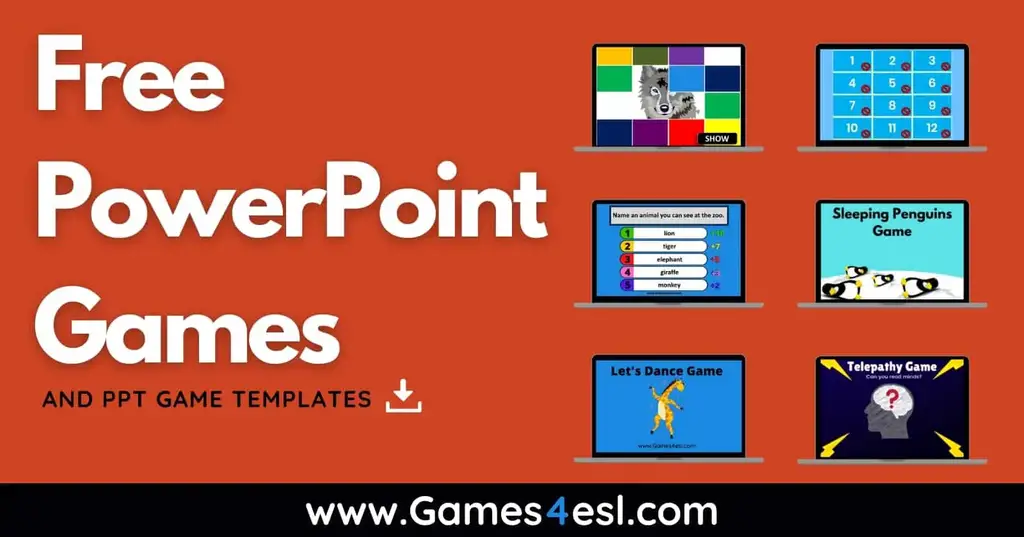
Free PowerPoint Games And Templates To Teach English
Here you can find many FREE PowerPoint Games and PowerPoint Game Templates . Use one of our ready-made games or make your own using the Blank Templates provided. These PowerPoint games are perfect for teaching kids and can be used on Zoom, in online classes, or in the classroom. Simply click on the type of game you would like to download to see the PowerPoints Games currently available.
PowerPoint Games And Templates
Hidden picture powerpoint games, memory game powerpoint game s, mystery box powerpoint game, sleeping penguins powerpoint game, powerpoint race game, telepathy powerpoint game, top five quiz powerpoint game, lucky box powerpoint game, let’s dance ppt game, jeopardy ppt game, soccer ppt game, halloween ppt game, alternatives to powerpoint games.
Top 10 Icebreakers For Your Next Presentation
Hrideep barot.
- Presentation , Public Speaking

If you are here, this is your sign to elevate your presentations from mundane to memorable with our guide on icebreakers for your next presentation. Are you tired of the same old routine when it comes to presentations? Are you looking for ways to captivate your audience, foster connections, and ensure your message doesn’t fall flat? Well, look no further because we’ve got the secret ingredient to transform your next presentation from mundane to memorable: Icebreakers!
In this blog, we’ll explore a treasure trove of icebreaking techniques to transform even the iciest of atmospheres into a vibrant and engaged audience. So, whether you’re a seasoned presenter or stepping onto the stage for the first time, get ready to discover the magic of icebreakers and watch your presentations come to life!
Why Icebreakers are Important?
Did You Know “ Icebreakers have an ancient history dating back to ancient Greece, where they employed “paradoxography,” a storytelling form, to engage and entertain participants during gatherings?”
Breaking the ice is like warming up a room full of strangers, it’s the catalyst for transforming uncomfortable moments into meaningful connections!”
Picture this scenario: you are in a professional setting, surrounded by unfamiliar faces, and it feels as if you are in uncharted territory. That is when someone proposes an icebreaker activity. Suddenly, you are engaged in a thought-provoking exercise, sharing insights, and gradually forming strong professional bonds.
Icebreakers are an essential tool in any social or professional setting, as they help to break down barriers, encourage interaction, and create a positive and welcoming atmosphere. Whether you are hosting a meeting, a workshop, a team-building event, or a conference, incorporating icebreakers can greatly enhance the overall experience for participants. In this blog post, we will explore the key points highlighting the importance of icebreakers and their numerous benefits.
Breaking the Ice
The primary purpose of an icebreaker is to break the ice between participants who may not know each other or who may feel hesitant to engage in conversation. By facilitating an initial interaction, icebreakers help to create a sense of familiarity, ease, and connection among attendees. They provide an opportunity for individuals to share a bit about themselves, their interests, and their backgrounds, which can lead to finding common ground and sparking conversation.
Building Trust and Relationships
Icebreakers play a crucial role in building trust and relationships within a group. When participants engage in icebreaker activities, they become more comfortable with each other, which encourages open communication and collaboration. Icebreakers foster a sense of trust and create a safe space for individuals to express themselves and share their thoughts and ideas. This improved trust and rapport can greatly enhance teamwork and collaboration throughout an event or project.
Energizing Participants
Icebreakers are an excellent tool for energizing participants and increasing their engagement. They help to shift the atmosphere from one of formality or initial awkwardness to one of energy and excitement. Icebreakers inject fun and enthusiasm into the event or meeting, making it more enjoyable and memorable for all involved. They also help to boost participants’ energy levels and attention span, ensuring that they are fully engaged and present throughout the entire duration of the activity.
Encouraging Creativity and Innovation
Icebreakers often involve out-of-the-box thinking, creative problem-solving, and innovative approaches. By engaging in activities that challenge participants to think differently or explore new perspectives, icebreakers stimulate creativity and innovation. They inspire individuals to break free from rigid thinking patterns and embrace fresh ideas. This creative environment can lead to more innovative solutions, insights, and outcomes further into the event or project.
Promoting Inclusivity and Diversity
Icebreakers are inclusive by nature, allowing individuals from various backgrounds and with different perspectives to come together and participate equally. They create a space where everyone’s voice can be heard, regardless of their role, hierarchy, or experience. Icebreakers can also be adapted to accommodate cultural differences and ensure that all participants feel comfortable and respected. By promoting inclusivity and diversity, icebreakers help to create a sense of belonging and foster a supportive environment for all.
Enhancing Learning and Retention
Here’s an interesting tidbit: People tend to remember information better when it’s associated with a positive or enjoyable experience. Icebreakers create a positive atmosphere, making your key points more likely to stick in your audience’s minds.
When participants are actively engaged and emotionally connected, they are more likely to absorb and retain information. Icebreakers help to create an optimal learning environment by providing an opportunity for participants to become actively involved in the experience. By warming up the mind and priming it for learning, icebreakers can significantly enhance knowledge retention and application.
How to Choose the Right Icebreaker?
Icebreakers are a crucial aspect of any event or gathering, as they help break down barriers, encourage interaction, and create a positive atmosphere among participants. However, choosing the right icebreaker can be a challenging task, as there is no one-size-fits-all solution. Here are some practical tips and examples to help you make the best choice for your audience.
1. Consider the Audience
The first step in choosing the right icebreaker is to consider the size and diversity of your audience. Different icebreakers work better for different group sizes and compositions. For example, an icebreaker suitable for a small team might not be as effective for a large conference. Take into account factors such as age, occupation, and cultural background to ensure that your icebreaker resonates with everyone present.
2. Align with the Event Theme and Objective
Next, consider the theme and objective of your event. An icebreaker that complements the purpose of the gathering or relates to its theme can set the right tone and create a sense of relevance among participants. For instance, if you are hosting a professional networking event, a suitable icebreaker could be asking attendees to share something about themselves that is not typically found on their professional profiles, as commonly done on LinkedIn.
3. Time and Space Constraints
The available time and space for your icebreaker activity will also impact your choice. Consider the duration of the event, whether it is a short meeting, a full-day workshop, or a multi-day conference. Tailor your icebreaker accordingly, ensuring that it is engaging but not time-consuming. Additionally, consider the physical space and ensure that the icebreaker can be executed comfortably within the given environment.
4. Familiarity and Comfort Levels
The level of familiarity and comfort among your attendees is an essential factor to consider. Icebreakers work best when they encourage participants to step slightly out of their comfort zones. However, it’s crucial to strike the right balance to avoid any discomfort or resistance. If your audience is particularly introverted or unfamiliar with each other, opt for icebreakers that are low-pressure, quick, and personal. Asking attendees to share a community or cause that holds personal meaning, as often done in Facebook Groups, can create a sense of connection without being overwhelming.
5. Be Prepared to Adapt
Lastly, be prepared to adapt and adjust the icebreaker if necessary. Sometimes, despite careful planning, an icebreaker may not work as expected or may require modifications while in progress. Stay flexible and open to making changes on the spot if needed. Being attentive to the participants’ engagement and reactions will help you gauge the effectiveness of the icebreaker and make any necessary tweaks.
6. Asking the Right Questions
- To choose the most suitable icebreaker for your event, ask yourself and your team relevant questions:
- What do my audience members like and dislike?
- What icebreakers have worked well in the past for similar groups?
- What icebreakers have they already experienced or seen before?
- What specific goal do I want to achieve through the icebreaker?
By asking these questions and conducting proper research, you can gather ideas and options that align with your audience’s preferences and the goals of your event. Combine your findings with your own experiences and observations to choose the icebreaker that is most likely to create a positive and engaging experience for everyone involved.
What is a Good Icebreaker for a presentation?
A good Icebreaker sets the pace for an effective and memorable presentation. It isn’t boring nor is it routine. It excites and energizes as you start with a bang. Here are 10 examples of the best Icebreakers in the field:
- The 5 great icebreaker questions?
- One-Word Icebreaker Game
- What’s in the Bag Icebreaker
- Two Truths and a Lie:
- Speed Networking:
- Would You Rather
- Human Bingo
- Scavenger Hunts
- Non-cringeworthy icebreaker- “Two Truths and a Dream”
1. The 5 great icebreaker questions
What is one thing you hope to accomplish in today’s meeting?
This question sets the stage for a productive discussion by encouraging participants to clarify their goals. It also helps the meeting facilitator tailor the agenda to address these expectations. For example, someone might say, “I hope to gain clarity on the project timeline,” which signals to the group that timeline discussions are a priority.
What is one word that describes how you feel about the upcoming project?
This question allows participants to express their emotional stance regarding the project, fostering transparency and empathy within the team. Responses can vary widely, from “excited” and “optimistic” to “apprehensive” or “curious.” Understanding each other’s emotions can aid in gauging the team’s overall morale.
Share one personal or professional success you’ve had since our last meeting.
This question promotes a culture of celebration and acknowledgment within the team. Participants can share accomplishments, whether big or small, that have occurred since the previous meeting. It encourages positivity and recognition of individual and collective achievements.
What is one challenge you anticipate facing in the upcoming weeks?
Anticipating challenges is crucial for proactive problem-solving. By discussing potential obstacles beforehand, teams can strategize and support each other more effectively. For instance, someone might mention, “I foresee difficulties in aligning our schedules for the project kickoff.”
What’s a book, podcast, or article you’ve found inspiring lately?
This is a powerful icebreaker that not only promotes knowledge sharing but also opens the door to meaningful discussions and interesting recommendations. This question sets a positive and engaging tone for meetings, promoting empathy, and providing valuable resources beyond the session. It’s a simple yet effective way to tap into the collective wisdom of the group while nurturing a culture of curiosity and inspiration.
2. One-Word Icebreaker Game:
Choose one word to describe your weekend.
- This prompt encourages participants to reflect briefly on their personal experiences. Responses could range from “relaxing” and “productive” to “adventurous” or “restful.” It provides insight into individual weekend experiences and sets a friendly, informal tone for the meeting.
Pick one word that captures your goals for the coming year.
- Participants can express their aspirations succinctly, like “growth,” “innovation,” “balance,” or “learning.” This exercise promotes goal sharing and may uncover common objectives or themes among team members.
Select one word that best represents your work style.
- This prompt encourages participants to self-reflect on their work approach. Words like “collaborative,” “methodical,” “adaptive,” or “focused” can offer insights into team dynamics and help in understanding each other’s strengths.
Fun One-Word to Describe Yourself Icebreaker:
- Choose one word to describe your personality.
- Share one word that sums up your morning so far.
- Pick one word that represents your favorite hobby or activity.
- This icebreaker is versatile and can be adapted to various contexts, allowing participants to share something about themselves in a concise, engaging manner. It’s a fun way to get to know each other better.
3. What’s in the Bag Icebreaker:
In this icebreaker, a bag contains various objects that participants can draw from. Each object represents a different aspect of the meeting or project. For example:
- A stress ball to represent managing project pressures.
- A puzzle piece to symbolize problem-solving.
- A pen to represent communication and collaboration.
When someone draws an object, they must relate it to their perspective on the meeting or project. This activity encourages creative thinking and adds an element of surprise and engagement.
These icebreakers help create an inclusive and interactive atmosphere, enabling participants to connect on both a personal and professional level. Feel free to customize these questions and activities to fit your specific meeting or event goals.
4. Two Truths and a Lie:
“Two Truths and a Lie” is a classic icebreaker that encourages participants to share interesting facts about themselves while adding a bit of mystery. Here’s how it works:
- Each participant takes turns sharing two true statements about themselves and one false statement.
- The other participants then try to guess which statement is the lie.
- The reveal follows, where the person reveals the false statement and shares the actual truth behind it.
Example: Participant A says:
- “I once climbed Mount Kilimanjaro.”
- “I’m fluent in three languages.”
- “I have a pet elephant.”
Participants B and C might guess that statement 3 (“I have a pet elephant”) is a lie. After the reveal, Participant A explains that they’ve never had a pet elephant, but they did climb Mount Kilimanjaro and are indeed fluent in three languages.
5. Speed Networking:
Speed networking is a structured, fast-paced activity designed to help participants make meaningful professional connections within a short time frame. Here’s how it typically works:
- Participants are paired up for a set amount of time (e.g., 3-5 minutes).
- During this time, they introduce themselves, discuss their professions, and exchange contact information.
- After the allotted time, participants switch partners until everyone has interacted with multiple people.
Example: In a speed networking event for entrepreneurs, participants A and B have a 3-minute conversation. They discuss their business ideas, challenges they’ve faced, and potential areas of collaboration. Once the timer goes off, they exchange business cards and move on to meet new people.
6. Would You Rather:
“Would You Rather” is a fun icebreaker that encourages participants to make choices and share their reasoning. Here’s how it works:
- Each participant receives a card with two options (e.g., “Would you rather have the ability to fly or be invisible?”).
- They must choose one option and explain why they made that choice.
- This icebreaker can lead to interesting discussions and insights into participants’ preferences.
Example: Participant A receives a card with the question, “Would you rather travel back in time or visit the future?” They choose to travel to the future because they’re excited to see technological advancements. Participant A then shares their reasoning with the group.
7. Human Bingo:
Human Bingo is a great icebreaker for large groups. Each participant receives a bingo card with different characteristics or experiences, such as “Has traveled to five countries” or “Speaks more than two languages.” Participants mingle and try to find people who match the descriptions on their cards. When they find a match, they write that person’s name in the corresponding bingo square.
Example: Participant A’s bingo card includes the statement, “Has run a marathon.” They approach Participant B, who has indeed run a marathon. Participant A writes Participant B’s name in that square. The goal is to fill in as many squares as possible and shout “Bingo!” when they do.
8. Scavenger Hunt:
A scavenger hunt is an interactive icebreaker that involves participants searching for specific items or completing tasks within a set time frame. It can be done indoors or outdoors, and participants can work individually or in teams. The organizer provides a list of items or tasks, and participants race to find them.
Example: In an office-based scavenger hunt, participants might receive a list that includes tasks like “Find a red stapler” or “Take a selfie with a colleague from a different department.” The first person or team to complete all the tasks wins.
These icebreakers serve various purposes, from fostering connections and networking to sparking creativity and promoting engagement. They can be adapted to suit the specific goals and preferences of your event or meeting, making them versatile tools for building rapport and enhancing interactions among participants.
9. What are some fun facts for Icebreakers?
Facts make for fantastic icebreakers because they’re like little windows into each person’s unique world. Sharing a fact about oneself or a fascinating tidbit of knowledge not only sparks conversation but also fosters a sense of curiosity and connection. Facts are the bridges that allow individuals to relate to one another, creating a dynamic and engaging ice-breaking experience that goes beyond small talk.
– The first recorded speeding ticket in 1896 clocked in at just over 8 miles per hour, a far cry from today’s traffic violations.
– In the English language, “E” takes the crown as the most common letter, appearing in 11% of all words. Meanwhile, “A” follows closely behind at 8.5%, while the letter “Q” is a rarity, showing up in only 0.2% of words.
– While many are familiar with animals like dogs and horses in police service worldwide, some regions in China employ geese for their noisy and disruptive qualities to help maintain street order and deter criminals.
– Hailstorms are a natural occurrence, but on planets like Saturn and Jupiter, lightning strikes carbon soot, transforming it into graphite. Under immense pressure during storms, this graphite converts into diamond hail, creating extraordinary diamond storms.
– Philanthropist Bill Gates, a part of the Giving Pledge initiative, has donated approximately $30 billion to non-profits and has saved over six million lives through healthcare and vaccination initiatives. This inspiring effort has garnered the support of 231 philanthropists.
– Scotland has adopted the unicorn, despite never having seen one in person, as its national animal. This mythical creature holds a special place in Scottish history, surpassing even the famous Loch Ness Monster in cultural significance.
Professional fun facts about yourself
Another way you can use fun facts as an icebreaker is by introducing yourself with a fun fact. It can be a great ice-breaking activity as everyone introduces themselves with an interesting fact. These examples can help you develop your fun fact answers that provide others with a clearer background of your professional goals, accomplishments, or experience:
- The bravest thing I’ve ever done was give a product demonstration to a live audience of over one thousand people.
- My role model is my dad because he immigrated to Canada when he was only 18, got a job right away, and worked hard to provide for our family.
- I have worked in marketing for over half my life.
- I have traveled to over 30 countries for business. My favorite one was Japan because they have a lot of delicious food.
- The first time I ever moved away from home was participating in a job internship 500 miles away from my hometown.
- I’m reading a book about financial technology to familiarize myself with the industry and its ongoing trends.
- I speak four languages: English, Spanish, Italian, and French.
- I was 17 when I got my first job at a fast-food restaurant, which helped me develop leadership, communication, and listening skills.
- My favorite subject in school was English, so I decided to become a writer.
- I once set the record for most products sold in one day during my previous sales job.
What is an Icebreaker that is not cringe?
A non-cringeworthy icebreaker fosters a positive and comfortable atmosphere, encourages interaction, and is relevant to the context. Here’s an example of a simple and effective icebreaker: An advanced and superior substitute of the Two Truths and a Lie icebreaker- which is called:
10. “Two Truths and a Dream”
In this icebreaker, participants share two facts about themselves and one aspirational dream or goal. This not only helps break the ice but also allows people to get to know each other on a more personal level and can lead to meaningful conversations.
Here’s how it works:
Each participant thinks of two true statements about themselves. These can be related to their personal life, hobbies, or professional background. They also think of one aspirational dream or goal they have for the future. It could be related to their career, personal growth, or a lifelong dream. Participants take turns sharing their two truths and one dream with the group. The challenge for the others is to guess which statement is the dream.
For example, someone might say:
- “I’ve traveled to five different countries.”
- “I’m learning to play the guitar.”
- “My dream is to start my non-profit organization.”
This icebreaker is effective because it allows people to share something personal and positive while also sparking curiosity and conversation. It’s not cringe-inducing and can lead to genuine connections among participants.
When to use Icebreakers?
Icebreakers are powerful tools to infuse fun and interaction into various situations. Here’s a quick guide on when to deploy them:
- Meeting Kick-Off : Start your meetings with icebreakers to get everyone engaged and set a positive tone. For example, “Two Truths and a Lie” can break the ice effectively.
- Team-building Events: During team-building activities, icebreakers help foster connections and boost team spirit. “Human Bingo” is a fun choice.
- Workshops and Training: In training sessions or workshops, icebreakers inject energy and creativity. “Would You Rather” questions can spark interesting discussions.
- Conferences and Networking: At conferences or networking events, icebreakers like “Speed Networking” facilitate connections and break the ice among attendees.
- Remote Meetings : In virtual settings, icebreakers bridge gaps and build camaraderie. Use questions like “Share your most unique quarantine hobby.”
- Post-Lunch Slump Buster: Combat post-lunch drowsiness by using icebreakers like “One-Word Icebreaker” to re-energize participants.
Icebreakers are not just for breaking awkward silences; they’re valuable tools to enhance engagement and connections across various scenarios.
How to Facilitate Icebreakers?
As the host or facilitator of the event, you have an important role in making the icebreakers successful. You’re the captain of the icebreaking ship, steering it towards success. Your role is pivotal in ensuring everyone has a great time. Start by preparing meticulously; you’re the conductor, and your baton must be in perfect sync with the icebreaker’s rhythm. When you step into the spotlight, introduce yourself with enthusiasm and clarity, setting the stage for what’s to come. Like a wise guide, explain the rules and what’s expected, ensuring everyone’s on the same page.
Equip participants with the necessary tools and materials, just as a host provides guests with all they need. Throughout the activity, be the energy monitor, adjusting the tempo to keep the vibe lively. Like an appreciative audience, provide feedback and recognition, highlighting the stars of the show. Finally, when the icebreakers conclude, be the storyteller who weaves it all together, connecting the dots between the icebreakers and the event’s purpose. Your role is to ensure that icebreakers are not just activities but memorable experiences.
Imagine the host/facilitator/MC as the thermostat in the room. While a thermometer simply measures the temperature, you, as the thermostat, have the power to set it. Your role is to bring clarity, engage the audience, and infuse energy into the atmosphere – all without crossing into cheesy territory. You’re the one who shapes the environment, making it inviting and exciting for everyone involved.
Be clear – Be engaging – Be energizing
In wrapping up our exploration of top icebreakers for your next presentation, remember this: icebreakers are the secret spices that turn the bland into the brilliant. They’re not just warm-up acts; they’re the opening chords of a captivating symphony.
From classics like “Two Truths and a Lie” to the creativity of “What’s in the Bag” and the lightning-fast networking of “Speed Networking,” these icebreakers are your allies in engagement, your partners in connection, and your ticket to presentations that won’t be forgotten.
So, as you plan your next presentation, embrace the icebreaker magic. They’re not the side dish; they’re the star of the show. Your audience will thank you for it, and your presentations will sparkle with a charm that’s impossible to resist.
To learn more about public speaking and effective communication you can reach out to us here.
Enroll in our transformative 1:1 Coaching Program
Schedule a call with our expert communication coach to know if this program would be the right fit for you

How to Brag Like a Pro as a Speaker

Less is More! Tips to Avoid Overwhelming Your Audience

What does it mean to Resonate with the Audience- Agreement, Acceptance, Approval

- [email protected]
- +91 98203 57888
Get our latest tips and tricks in your inbox always
Copyright © 2023 Frantically Speaking All rights reserved
Innovative Presentation Ideas: Captivate Your Audience with Creative Approaches
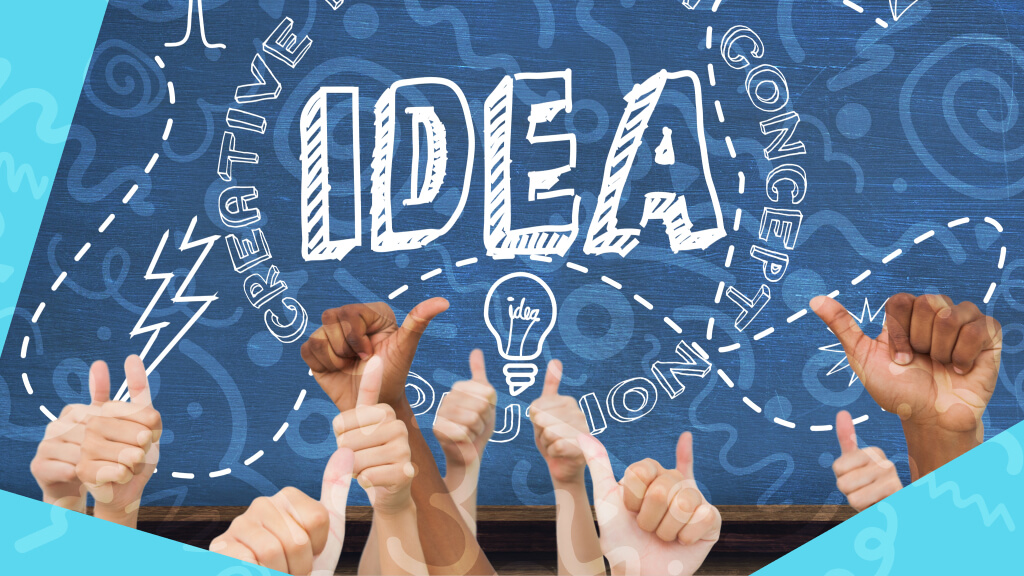
Creating an engaging presentation requires more than just delivering information—it’s about capturing your audience's attention, making your message memorable, and encouraging interaction. To help you stand out and leave a lasting impression, here are some innovative presentation ideas that can elevate your content and captivate your audience.
1. Interactive Polls and Q&A Sessions
Engagement through interaction.
Integrating interactive elements such as live polls or Q&A sessions can significantly increase audience participation and engagement. These tools make your presentation more dynamic and allow you to tailor your content based on real-time feedback.
How to Implement:
- Live Polls: Use platforms like Slido or Mentimeter to conduct live polls where the audience can vote on questions or provide opinions. Display the results immediately to spark discussions.
- Q&A Sessions: Allocate time for a Q&A segment where the audience can ask questions. Consider using a tool that allows anonymous submissions to encourage more candid questions.
Scenario: During a marketing strategy presentation, start with a live poll asking the audience about their biggest marketing challenges. Use the poll results to shape the rest of your presentation, addressing the most common issues.
2. Storytelling with Visuals
Bring your message to life.
Storytelling is a powerful technique for making your presentation memorable. Combine storytelling with compelling visuals to create a narrative that resonates with your audience and makes your message more impactful.
- Narrative Arc: Structure your presentation as a story with a clear beginning, middle, and end. Introduce characters, conflicts, and resolutions to make your content relatable.
- Visual Aids: Use high-quality images, videos, and infographics to illustrate key points and evoke emotions. Tools like Canva or Adobe Spark can help create visually appealing content.
Scenario: In a pitch for a new product, start with a story about a customer’s journey before and after using your product. Use images and video clips to illustrate the transformation, making the benefits of your product tangible and relatable.
3. Gamification
Make learning fun.
Gamification involves incorporating game-like elements into your presentation to make learning more engaging. This approach can turn routine information into an interactive experience, boosting motivation and retention.
- Quizzes and Challenges: Include quizzes or challenges throughout your presentation. Award points or prizes for correct answers to keep the audience engaged.
- Interactive Scenarios: Create scenarios or simulations where the audience can make decisions and see the outcomes. This can be particularly effective in training or educational presentations.
Scenario: During a workshop on project management, organize a team-based challenge where groups compete to solve a case study. Use a leaderboard to track progress and provide rewards for the winning team.
4. Live Demonstrations and Showcases
Show, don’t just tell.
Live demonstrations can make your presentation more engaging by providing practical, hands-on examples of your product or concept. This approach allows your audience to see your ideas in action and better understand their application.
- Product Demos: If you’re presenting a new product, demonstrate its features and benefits live. Allow the audience to interact with the product if possible.
- Live Simulations: For educational or technical presentations, conduct a live simulation to showcase how a process works in real time.
Scenario: In a tech conference presentation, perform a live demo of your software, showing its key features and benefits. Allow the audience to ask questions and interact with the software during the demo.
5. Audience Participation Activities
Encourage active involvement.
Involving your audience in activities can make your presentation more interactive and memorable. Participation activities can range from group discussions to hands-on exercises, depending on your presentation’s goals.
- Breakout Sessions: Divide the audience into small groups to discuss specific topics or solve problems. Have each group share their findings with the larger audience.
- Interactive Exercises: Incorporate activities such as role-playing, brainstorming sessions, or creative workshops to engage the audience actively.
Scenario: During a leadership training session, organize a role-playing exercise where participants act out different leadership scenarios. Facilitate a discussion afterward to reflect on the exercise and extract key lessons.
6. Incorporating Augmented Reality (AR)
Enhance the presentation experience.
Augmented Reality (AR) can create immersive experiences that captivate your audience and bring your content to life. This technology can be particularly effective for presentations involving complex data or concepts.
- AR Apps: Use AR applications to overlay digital content onto physical objects or environments. Tools like Zappar or ARKit can help integrate AR into your presentation.
- Interactive Models: Create interactive 3D models that the audience can explore using AR, enhancing their understanding of the subject matter.
Scenario: In a presentation about architectural design, use AR to allow the audience to view 3D models of building projects through their smartphones or tablets, giving them a better sense of the design and layout.
7. Utilizing Data Visualization
Simplify complex information.
Effective data visualization can help simplify complex information and make it more accessible. Using charts, graphs, and infographics can enhance understanding and retention.
- Infographics: Create infographics that summarize key data points and trends. Tools like Piktochart or Tableau can assist in designing effective visualizations.
- Interactive Charts: Use interactive charts and graphs that allow the audience to explore data in real time.
Scenario: During a financial report presentation, use interactive charts to display revenue trends and projections. Allow the audience to filter the data by different criteria to explore various scenarios.
8. Incorporating Live Feedback
Adapt and improve in real time.
Collecting live feedback during your presentation allows you to adjust your content based on audience responses and interests. This approach can help you address the most relevant issues and maintain engagement.
- Live Feedback Tools: Use tools like Mentimeter or Slido to gather real-time feedback from your audience. Pose questions or request opinions throughout the presentation.
- Instant Polls: Conduct quick polls to gauge the audience’s understanding or interest in specific topics, and adjust your content accordingly.
Scenario: In a product launch presentation, use live polls to ask the audience about their preferences or concerns regarding the product. Use the feedback to address these points in real time.
Innovative presentation ideas can significantly enhance your ability to engage and captivate your audience. By incorporating interactive elements, storytelling, gamification, live demonstrations, audience participation, AR, data visualization, and live feedback, you can create a presentation that is not only informative but also memorable and impactful. Tailor these ideas to fit your presentation’s goals and audience to ensure a successful and engaging experience.
Table of contents
Dragon Age 2: 7 Reasons Why It’s Underrated

Your changes have been saved
Email is sent
Email has already been sent
Please verify your email address.
You’ve reached your account maximum for followed topics.
Dragon Age: The Veilguard Reveals New Exploration Feature
How dragon age: the veilguard is tackling the blight, black myth: wukong— how to get kun steel, key takeaways.
- Framing the game through Varric's retelling adds a unique spin on the story presentation, enhancing the overall narrative.
- Cinematic style with cutscenes and voice acting make Hawke a compelling and engaging hero with a distinct personality.
- Fluid and action-packed combat in DA2 offers a fresh experience, sacrificing complexity for clarity and impact in battles.
Following Dragon Age: Origins must have been an incredibly difficult task. How does someone follow up on a game as intricately designed and expansive as the original Dragon Age, a game that lets players realize a protagonist with as much depth and freedom as they'd find in a tabletop title? For Bioware, or at least, for the EA executives directing Bioware, the answer was to streamline everything into a beat-em-up-styled ARPG, with voice acting and cinematic cutscenes and explosions.
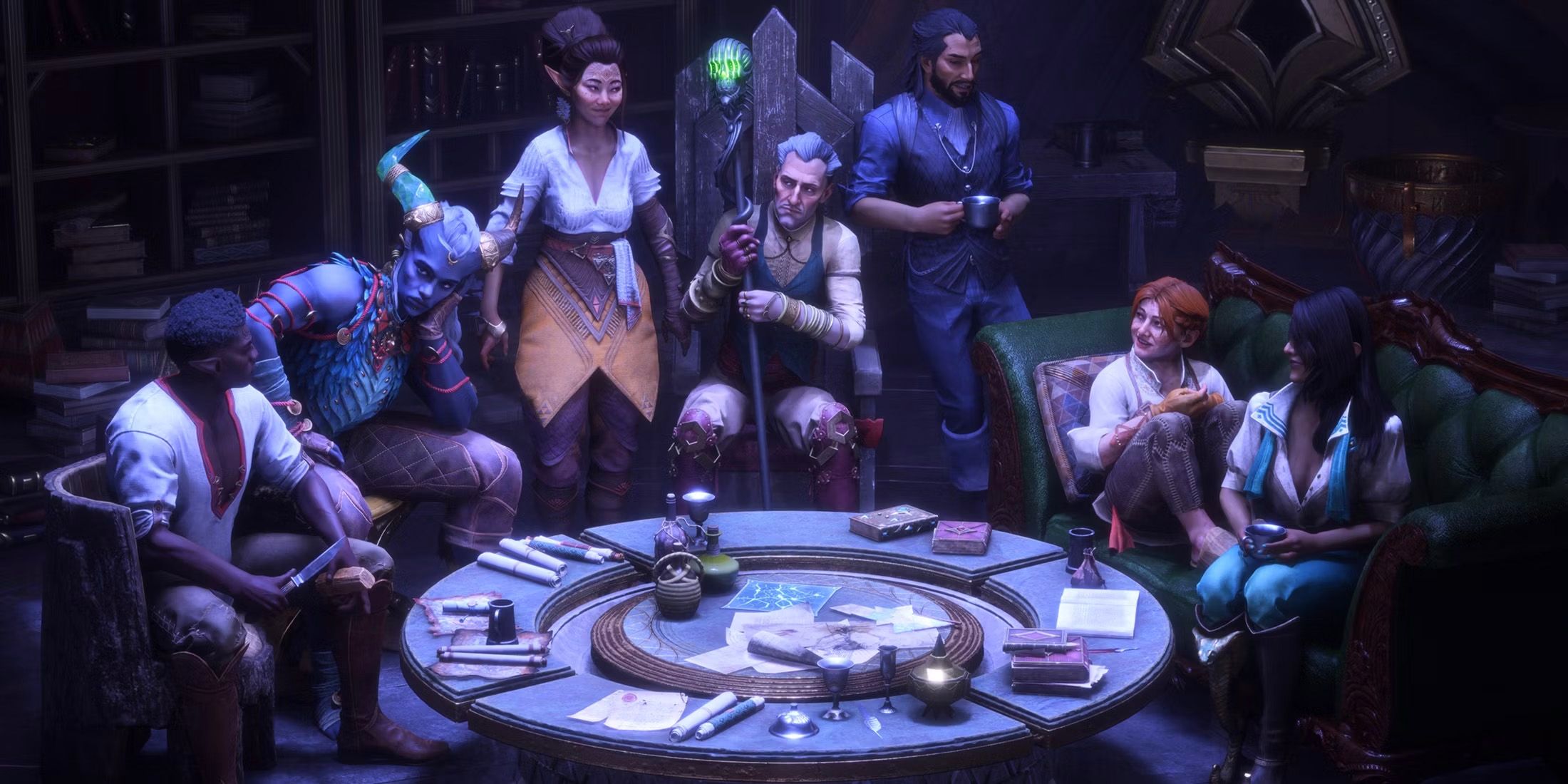
During a recent BioWare Discord Q&A, Dragon Age: The Veilguard director Corinne Busche explains how exploration abilities work.
Yes, it's neither a secret nor a surprise that players hungering for more CRPG goodness were left wanting by Dragon Age 's second installment. However, the game still has an incredible amount of polish and merit . Here are just a few of the reasons why Dragon Age 2 is slept on more than it deserves.
7 The Novel Presentation
Framing the game as a retelling is a unique spin.
The first thing players learn as they begin Dragon Age 2 is that the story is not being framed directly through the protagonist, Hawke's, eyes. Instead, the whole game is a stylized retelling from one of the most important characters in the Dragon Age series, Varric.
The heavily embellished action in the introductory sequence, mimicked throughout the story, as well as the greater emphasis overall on spectacle and grandeur in the game, all circle back to the words of Varric. It was an interesting way of presenting the new style to the audience and provided at least some justification for the heightened pace of combat compared to the original title.
6 The Cinematic Style
Cutscenes and voice-acting frame hawke as a hero.
Following on from the idea behind the game's presentation is, of course, the presentation itself. DA2 is filled with a grander score and more fluid, dynamic movement than its predecessor. A voiced protagonist means that conversations flow more smoothly and are more engaging, admittedly at the cost of the dialogue freedom Origins offered.
Hawke's personality, shaped by the player and projected to the world through these updated game presentations, has made them a fan-favorite among Dragon Age characters. A cocky Hawke leaping over enemies or a violent Hawke brutalizing foes leaves a very strong impact on the player regarding the kind of character they're creating throughout the story.
5 The Fluid Combat
Action-packed and fluid-fighting.
The combat in Origins was very complex and gave room for lots of customization, but its slowness was not the finest part of the game. To those who found Origins combat stifling, the fluid and fast-paced combat of DA2 was a breath of fresh air.
Combat now happens in real-time and with the right level of punch and impact following up every swing of a sword or blast from a staff. The streamlining of equipment and skills sacrifices complexity for the sake of clarity, and each node on the upgrade tree still feels like a markedly fresh layer onto whichever combat archetype the player is focusing on. The punchy, forceful combat marks another pillar holding up the hard magic atmosphere of this more grounded title.
4 The Well-Realized Setting
Kirkwall has an identity of its own.
DA2 has a tighter and smaller-scale setting than its predecessor, and that's okay. Not every RPG needs to be about saving the world . But Kirkwall, through the player's exploration of it over the course of years, fighting in its undercity and trading in its markets, takes on a life of its own as fleshed out and realized as any character.
The decisions Hawke makes as he gains more and more prominence in Kirkwall, especially as the narrative comes to its climactic finale, shape the citizenry of Kirkwall and their demeanor, which in turn influences the place where Hawke lives, engages with his companions, and sees most of the story unfold.
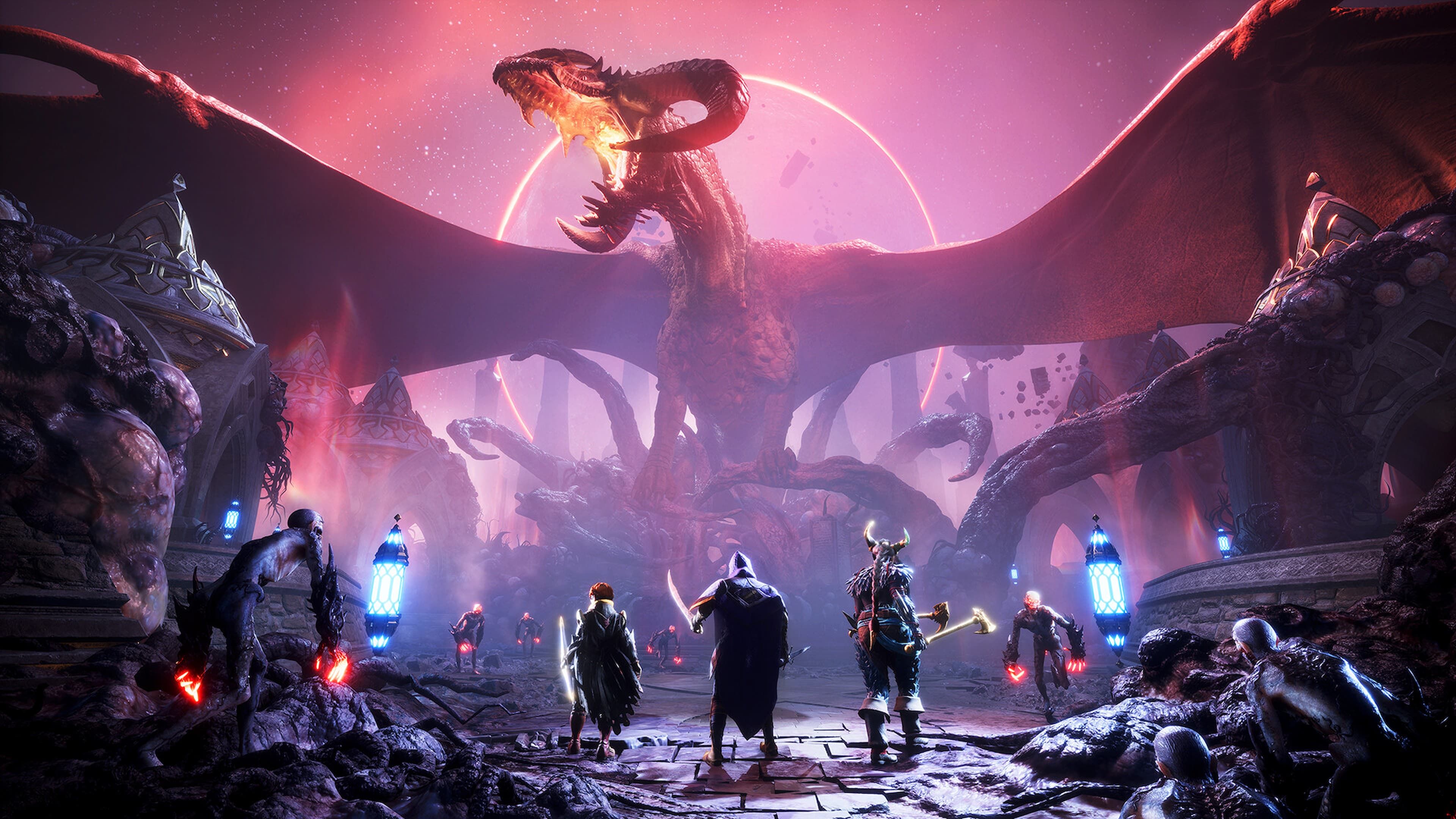
What Class Will You Be Playing In Dragon Age: The Veilguard?
In RPGs, I always start as the greatsword guy whenever possible, which is why I'll be spending my first playthrough as yet another Human Male Warrior wielding a two-handed weapon in Dragon Age: The Veilguard. If I ever bother with a second playthrough, then I'm probably going to play as a rogue next.
3 The Companions
Classic bioware storytelling still shines through the characters.
While combat might be decidedly distinct from its predecessor, the title's dedication to strong character work remains intact. Hawke is depth and verisimilitude through the different personalities and attitudes he can develop throughout the game, but what makes him feel like a part of Kirkwall - as opposed to an outlier - is how his companions are all able to undergo similar levels of development.
The shifting, fluid attitudes of Hawke's comrades may not always land them in the best places , but damned if they don't tell good stories along the way. Whether comradery or romance is the goal, every companion has a branching story for Hawke to engage in.
2 Rivalries
A unique spin on companion affection.
Dragon Age 2 does not care how much affection Hawke's companions have for him. It merely cares how strongly they feel towards him. Rather than simply deduct affection points or something along those lines with companions, if Hawke's actions upset the people close to him, they shift in a scale that measures love and hatred both, with apathy in the middle.
Companions that feel negatively towards Hawke get just as many dialogue opportunities and unique interactions as characters that feel strongly towards them. It's also worth noting that romances are available for both positive and negative relationships, for the enemies-to-lovers fans out there. DA2 rewards the player for leaving a lasting impression on their companions - whatever that impression might be.
1 Choice and Consequence
Both within the game itself and beyond.
As mentioned earlier on this list, DA2 does not spare any details to the writing fans had come to expect from the last game, even if the combat and game flow differ. While the implementation of voice-acting and the dialogue wheel has restricted the options for the main character to express, there are still a variety of branches for each main quest and side quest to take.
Beyond this, the characters' outlook towards the player, gauged by the friendship/rivalry system, influences the choices they make in the story. This all culminates in a unique stream of events for Hawke, which can then go on to influence the world-state in Dragon Age: Inquisition , causing these choices to have an impact that reaches beyond their own game.

The Blight is one of the oldest foes in Thedas, but its origins are still largely a mystery that Dragon Age: The Veilguard needs to solve.
Cinematrix No. 165: September 7, 2024
Tap a clue to see a headshot or get more details.
The Cinematrix uses data from TMDB . Want to play more grid games? Visit Movie Grid .
Contact us at [email protected] with questions or feedback.
- vulture cinematrix
- vulture games
- cinematrix archive
What is your email?
This email will be used to sign into all New York sites. By submitting your email, you agree to our Terms and Privacy Policy and to receive email correspondence from us.
Sign In To Continue Reading
Create your free account.
Password must be at least 8 characters and contain:
- Lower case letters (a-z)
- Upper case letters (A-Z)
- Numbers (0-9)
- Special Characters (!@#$%^&*)
As part of your account, you’ll receive occasional updates and offers from New York , which you can opt out of anytime.
- Enter Our Giveaway
- Meta Quest 4
- Google Pixel 9
- Google Pixel 8a
- Apple Vision Pro 2
- Nintendo Switch 2
- Samsung Galaxy Ring
- Yellowstone Season 6
- Recall an Email in Outlook
- Stranger Things Season 5
Best practices for making awesome PowerPoint slides
Whether you’re presenting a slideshow to your executives, clients, or peers, you want to convey your message clearly and successfully, and at the very least prove that you know how to use PowerPoint . Unfortunately, many mistakes can be made when creating PowerPoint presentations.
Choose the fonts wisely
Select pleasing colors.
- Don’t overuse animations and effects
Use a standard presentation rule
From hard-to-read fonts to colors that hurt the eyes of your audience, here are some best practices to keep in mind for your next PowerPoint slideshow.
Using a fancy, dramatic, or even whimsical font can be tempting. But you must consider the readability of the font. You want your audience to easily see your headings and bullet points. Consider the two basic font styles: serif and sans serif.
Serif fonts are more decorative, have a classic appearance, and are frequently used in print publications. Each letter has a stroke that extends from a point in the letter. Popular serif styles include Times New Roman, Garamond, Georgia, and Baskerville.
Sans serif fonts are more precise, have a clean appearance, and are frequently used in digital publications. Each letter is clear-cut without wings or curves at its points. Popular sans serif styles include Arial, Verdana, Tahoma, and Calibri.
Because of the extended strokes, serif fonts can appear a bit blurry on a screen. This makes a sans serif font the favored choice. The bottom line is that you should remain consistent and use the same type, serif or sans serif, for all fonts in the slideshow.
The colors you use in your PowerPoint presentation can be just as important as the content. You want to use those that enhance the appearance of the slideshow, not distract or give your audience a headache.
As Microsoft’s Robert Lane explains in his article about combining colors in PowerPoint, mixing red and blue or red and green can cause eye strain. Plus, red and green mixtures are difficult to see for those with color blindness.
The article mentions that warm colors like reds, oranges, and yellows are eye-catching, whereas cool colors like blues, greens, and purples draw less attention. Additionally, lighter colors are more noticeable than dark.
One of the easiest ways to choose the colors for your presentation is to use a built-in theme. Select the Design tab and you’ll see a collection of Themes in the ribbon.
Once you select a theme, you can then use the Variants section to choose a different color scheme. Each scheme includes eight complementing colors. You can also pick the font style you want to use in the Variants drop-down menu.
Tip : You can also check out the Design Ideas if you need help with the layouts for your slides.
Don’t overuse animations and effects
Animations can be attention-grabbing additions to a slideshow. But if you overuse or misuse them, they can be detrimental to your presentation and actually turn off viewers. The best thing to do is consider your audience and slideshow’s purpose.
For instance, if you are presenting the slideshow to a classroom of 8-year-old students, animations can grab and hold their attention more than simple images or words. However, if you’re presenting to your company’s executive team or board of directors, animations can come across as unprofessional. Also, be wary of embedding videos in PowerPoint — only do so when relevant.
If you really want to include animations, make them subtle or purposeful. As an example, you may want to expand on each bullet point in your list. You can create an animation to display the bullet points one by one and only when you click.
To do this, select the first bullet point, go to the Animations tab, and choose the Appear effect. Then, in the Timing section of the ribbon, choose On click in the Start drop-down list. Do the same for each bullet point in your list.
This creates a simple animation that benefits your presentation. It doesn’t distract but instead keeps your audience focused on your current talking point.
What is the 10/20/30 rule of PowerPoint? What is the five-by-five rule? What about the 5/5/5 and seven-by-seven rules? Rules, rules, rules. These are different standards that many recommend using when it comes to creating PowerPoint presentations.
- The 10/20/30 rule : Have no more than 10 slides, a presentation no longer than 20 minutes, and a font size no smaller than 30 points.
- The five-by-five rule : Have no more than five words per line and five lines per slide.
- The 5/5/5 rule : Have no more than five words per line, five lines per slide, and five text-heavy slides in a row.
- The seven-by-seven rule : Have no more than seven words per line and seven lines per slide.
What each of these rules basically means is: Keep it simple.
The first rule, 10/20/30, is a good rule to follow for your overall presentation. While it may not always be possible, the more succinct a presentation, the more successful it will be.
The last three rules are helpful ones to follow when you’re adding text to your slides. As you know, presentations are visual. Using too much text means your audience is reading more than watching.
Hopefully, these best practices will help you create a memorable and effective slideshow. For other ways to enhance your presentation, look at how to add audio to the slides or how to include music in PowerPoint .
Editors’ Recommendations
- The best PowerPoint templates
- How to download Microsoft PowerPoint
- Apple’s Vision Pro to get bespoke Microsoft 365 apps at launch
- PowerPoint will use ChatGPT to create entire slideshows for you
- Microsoft might put ChatGPT into Outlook, Word, and PowerPoint

If you're using Microsoft Office on your Windows PC, then you might want to keep your eye out for potential new security issues.
Microsoft has just backtracked on a decision it made earlier in 2022, and will no longer be blocking Visual Basic for Applications (VBA) macros in Office files by default across Word, PowerPoint, Excel, Access, and Visio.
Microsoft needs your help to shape the future of its Office suite of products. Five new default fonts are in the works for Microsoft 365 -- which covers Word, Excel, and PowerPoint -- and Microsoft is seeking out feedback for which one is best.
The five new potential default font families are now available as a download for testing and have various themes. The list includes fonts with the unique names of Tenorite, Bierstadt, Skeena, Seaford, and Grandview. There's a separate artist behind each one, and the designs span different geometric, human, and industrial shapes, according to Microsoft.
Many of the apps from the Microsoft 365 suite now run natively on Apple's new M1-powered MacBooks. Outlook, Word, Excel, PowerPoint, and OneNote are now all able to take full advantage of Apple's custom ARM-based silicon.
These new Microsoft 365 apps for Apple M1 Macs are all universal apps, which means that they will also run on traditional Macs with Intel processors. This also means that the Office apps on Apple's M1 Macs -- like the new MacBook Air, 13-inch MacBook Pro, and Mac mini -- should all feel snappier and faster than when they were previously running under emulation with Rosetta 2.
- Category: Announcements
The Xbox 360 Store Will Close July 2024, But You Can Keep Playing Your Favorite Games
This November will mark 18 years since Xbox 360 launched. It was a generation-defining console that invited many to jump into gaming for the first time and connect with friends around the world. Over the years, we’ve heard stories of players who found a lifelong love of games, starting with the likes of Kameo , Gears of War , Fable 2 and other Xbox 360 classics. We’re thrilled so many fans keep playing their favorite Xbox 360 games on Xbox 360, or on newer consoles via Backward Compatibility.
As we head toward 2024, we have a change to share about the Xbox 360 experience:
- On July 29, 2024, Xbox will stop supporting the ability to purchase new games, DLC, and other entertainment content from the Xbox 360 Store on the console and the Xbox 360 Marketplace (marketplace.xbox.com)
- Related to this change, the Microsoft Movies & TV app will no longer function on Xbox 360, which means TV and movie content will no longer be viewable on your Xbox 360 after July 29 th , 2024.
Between now and July 2024, you can continue purchasing games and DLC from the Xbox 360 Store and at the Xbox 360 Marketplace.
This change will not affect your ability to play Xbox 360 games or DLC you have already purchased . Xbox 360 game content previously purchased will still be available to play , not only the Xbox 360 console but also Xbox One and Xbox Series X|S devices via backward compatibility.
A lot has changed since the Xbox 360 launched in 2005. Technology has evolved, expectations from players have shifted, and we are focused on making Xbox Series X|S the best place to play now and in the future.
What has not changed is our commitment to preserving your ability to play the content you have already purchased on your preferred device, which means we are committed to supporting Xbox 360 gameplay for the foreseeable future – and you will still be able to play and re-download previously purchased content and connect with friends.
We hope to get ahead of some of your questions below:
Can I still play my Xbox 360 games after July 2024?
Yes, you will still be able to play the games you purchased on Xbox 360. If you purchased the game digitally or have a physical disc, you can still jump in and play. If you’ve deleted a game that you have purchased, but you want to play again, you’ll still be able to re-download it.
What about multiplayer games via the Xbox network? Can I still play with my friends?
Yes. Even after July 2024, you will still be able to play games and connect with friends through multiplayer on the games you purchased, as long as the publisher still supports the online servers. You can still save your games and progress to the cloud, and if you choose to continue any of those available games on Xbox One or Xbox Series X|S, those cloud saves will transfer over.
Can I still buy and play Xbox 360 backward-compatible titles?
There is no impact to purchasing or playing backward-compatible Xbox 360 titles. After July 29, 2024, you will still be able to purchase hundreds of great backward-compatible Xbox 360 and Original Xbox games and DLC on Xbox One, Xbox Series X|S, and Xbox.com . We believe in celebrating gaming’s rich history and have worked hard to preserve as many games as possible through our backward-compatibility program. You can find the full list of backward-compatible titles here .
For those who wish to continue playing Xbox 360 games on Xbox Series X|S, we’ve taken the time to enhance those titles so they look and play better than ever before, while staying true to the original version. You can play those Xbox 360 titles with FPS Boost, Auto HDR, and faster loading times.
How can I continue to stream and download Microsoft Movies & TV content I purchased on Xbox 360?
The Microsoft Movies & TV app is available on Windows devices running Windows 10 or later, Xbox One, and Xbox Series X|S. Any content that you’ve purchased from the Xbox 360 Store will remain in your library and be available to view on such devices. In addition, all purchased Movies & TV content eligible for Movies Anywhere can always be streamed and downloaded on the Movies Anywhere app or site. For more information, see: Movies Anywhere on Microsoft Movies & TV .
Where can I get more information?
If you have more questions, please visit our support page at https://support.xbox.com/help/xbox-360/store/xbox-360-marketplace-update
- Sports Betting
- Sports Entertainment
- New York Yankees
- New York Mets
- Transactions
Recommended
Yankees’ gerrit cole excited to face ‘longest friend in the game’.
CHICAGO — If Gerrit Cole wanted to turn the opposing pitcher on days he starts into an unlikeable target, that would be impossible on Sunday.
Jameson Taillon is too good of a friend, and too nice of a person, for Cole to take that approach.
Instead, the Yankees ace will be trying to just enjoy the day on Sunday when he duels against Taillon for the first time in their careers in the series finale at Wrigley Field.

“My longest friend in the game, probably my best friend in the game,” Cole, who will also be turning 34 on Sunday, said Saturday afternoon before the Yankees’ 2-0 win . “I can’t root against him. And I don’t really want to root less for him. So I’m probably just going to try to not think about it. But I will sneak a few — I’ll definitely watch him.
“I enjoyed pitching against Justin [Verlander] and Charlie [Morton] in the past and other ex-teammates. Jamo’s just a little different, because we were in Pirate City [the Pirates minor league complex in Bradenton, Fla.] together to start it all off. So I’m just hoping it’s a good day.”
Taillon was the Pirates’ first-round pick in 2010, with Cole following as the club’s first-round pick in 2011. After spending time in the minor leagues together, they shared a rotation in Pittsburgh in 2016 and 2017 before Cole was traded to the Pirates.
They then reunited in The Bronx from 2021-2022 before Taillon became a free agent and signed a four-year, $68 million contract with the Cubs.
On Thursday’s off day, Taillon and Cole’s wife Amy surprised him with an early birthday party, which included the two pitchers and their wives taking a boat out in Chicago.

On Friday, Taillon sent Cole a coffee at Wrigley Field.
“He’s just an unbelievable friend,” Cole said. “I mean, I think he’s watched 250 of my major league starts out of 300, and I might be shooting that low.
“He has people that adore him in Pittsburgh, people here [in the Yankees clubhouse] adore him, I know he’s obviously well-liked over there [in the Cubs clubhouse]. I’m so proud of him. He’s overcome two Tommy Johns, testicular cancer and he won the division-clinching game for us [in 2022].
“Things that could break a man haven’t broken him. He’s not just survived but he’s a great pitcher and he’s gonna be a 10-year major league vet. He’s represented the Yankees with grace and class and he’s a great ambassador for the Chicago Cubs. I just love the guy. I’m super proud of him.”
Presentation
Different Types of Slides for Your Presentations

Table of Contents
Presentations are a great way to share information and ideas. Whether you’re selling a product, teaching a class, or showing off your work, the slides you use can make a big difference.
There are many different kinds of slides you can add to your presentations, each with its own purpose and advantages. By knowing the different types of slides and how to use them well, you can create interesting and informative presentations that will stick with your audience.
Different Types of Slides
There are many different types of slides that you can use in your presentations. Some of the most common types include:
Opening Slides
1. title slide.

The title slide is your chance to make a strong first impression and set the tone for your presentation. It should clearly convey the topic, your identity, and relevant details. A good title is both practical and creative.
The main title is the focal point and should be concise yet descriptive. Use a large font size that’s easy to read from a distance. If needed, add a subtitle for more context. Clearly state your name, job title, and affiliation. Include the date and venue for reference.
Design your slide to reflect your brand or personal style using logos, colors, and fonts. Keep it clean and uncluttered for a professional look. Remember, less is more. Use high contrast for readability and avoid distracting background images. Consider adding subtle effects like fade-in or morph for visual interest.
2. Agenda Slide

Agenda slides serve as a valuable tool for guiding your audience through the structure of your presentation. By outlining the main topics and their expected duration, you can help them anticipate the flow of information and manage their expectations.
This is especially beneficial for lengthy presentations or academic talks where a clear roadmap can enhance understanding and engagement.
When creating an agenda slide, consider including the following elements:
- Clear Topic List: Present a concise and well-organized list of the main topics to be covered.
- Optional Timings: Indicate the estimated duration of each section to provide a sense of pacing.
- Visual Progress Indicator: Use checkmarks, arrows, or other visual cues to highlight the current topic and show what’s ahead.
- Distinctive Headings: Use clear and concise headings to visually separate different sections.
- Hyperlink Integration: If using PowerPoint, consider adding hyperlinks to specific slides to ensure smooth navigation and avoid abrupt jumps.
Learn more on How to Create Agenda Slides in Powerpoint .
Transitional Slides
Transitional slides act like bridges that connect different parts of your presentation. They help your audience smoothly move from one topic to the next. These slides are important because they:
- Clearly Signal a Change: Let your audience know that you’re moving on to something new.
- Keep the Audience Engaged: Prevent sudden jumps between topics, helping them stay focused.
- Make Your Presentation More Visually Interesting: Add variety and visual appeal.
Here are some examples of transitional slides:
3. Quote Slide

Quote slides incorporate wisdom, authority, or inspiration from renowned sources into your presentations. They can provide strong support for your arguments or motivate your audience.
These slides are perfect for emphasizing a point, sparking thought, or introducing a new direction in your presentation. Use them to highlight the importance of an idea.
Here are the elements of a quote slide:
- The Quote: Clearly presented and attributed to the speaker or writer. The text should be easy to read and emphasized to stand out.
- Author’s Name and Credentials: Provide context by including the author’s name and, if relevant, their qualifications or why they are an expert on the topic.
- Related Imagery or Background: An image or design that matches the theme of the quote can make it more impactful.
Consider using a quote presentation template with a professional layout. You can find something directly on SlidesAI . For readability, ensure there is a good contrast between the text and the background. Text boxes with backgrounds are often used. If you use an image, choose one that enhances the text, not competes with it.
4. Image Slides
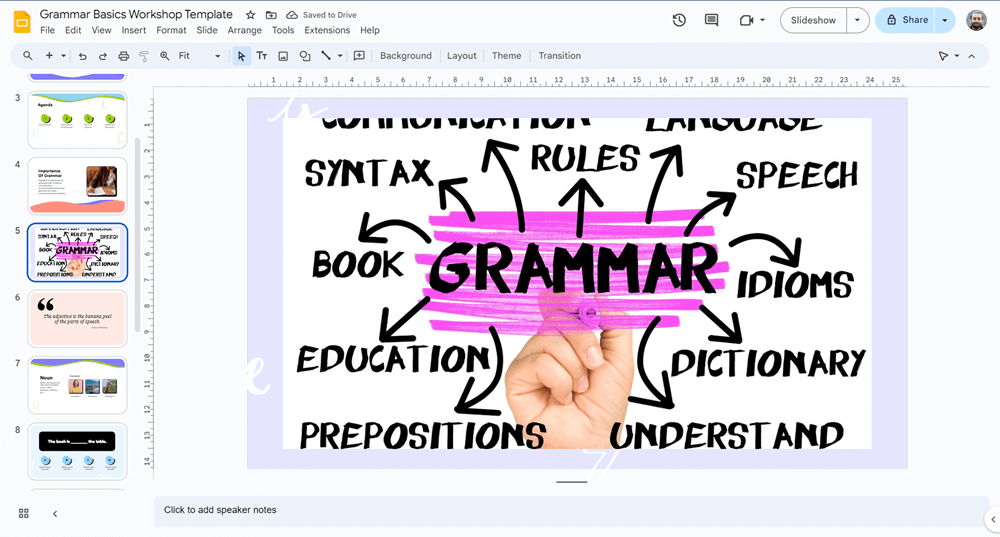
Image slides can significantly make your presentations better by gaining attention with their visual appeal and transitions. For a smooth flow, use a full-screen image with a fade effect. To create a more dynamic experience, experiment with the Morph transition between slides featuring overlapping images.
You can also build anticipation with a thematic image series that subtly connects your topics. Remember to keep these transitions concise and impactful to maintain your audience’s attention.
Closing Slides
5. q&a slide.

Q&A slides are often used in presentations for various reasons. For instance, some presenters like to ask questions to the audience after their presentation and answer any questions they may have.
Other presentations might encourage the audience or panel members to ask questions throughout the presentation. If you’re planning to incorporate Q&A into your presentation, consider using some well-designed templates to make a positive impression.
6. CTA Slides

A call-to-action slide, or CTA slide for short, serves to encourage viewers to take a specific step after your presentation. This could range from initiating a conversation to purchasing a product or service, or even engaging in a project.
Typically placed at the end, following the concluding remarks and thank you slide, the CTA aims to spark immediate action. Here’s what makes a strong CTA slide:
- A Clear Direction: The heart of the CTA itself should be direct and persuasive. Think of something like “Register Now,” “Join Our Team,” or “Visit Us Online.”
- Reasons to Act: Briefly remind viewers of the benefits they reap by taking action. This strengthens the appeal and motivates them to follow through.
- Contact Information or Links: Make it easy for them to act! Include all necessary links or contact details so viewers know exactly where to go next.
- Visually Appealing Design: Grab their attention! Use a design that pops and features large, easy-to-read text. Opt for strong, action-oriented language to drive the message home.
7. Summary Slide
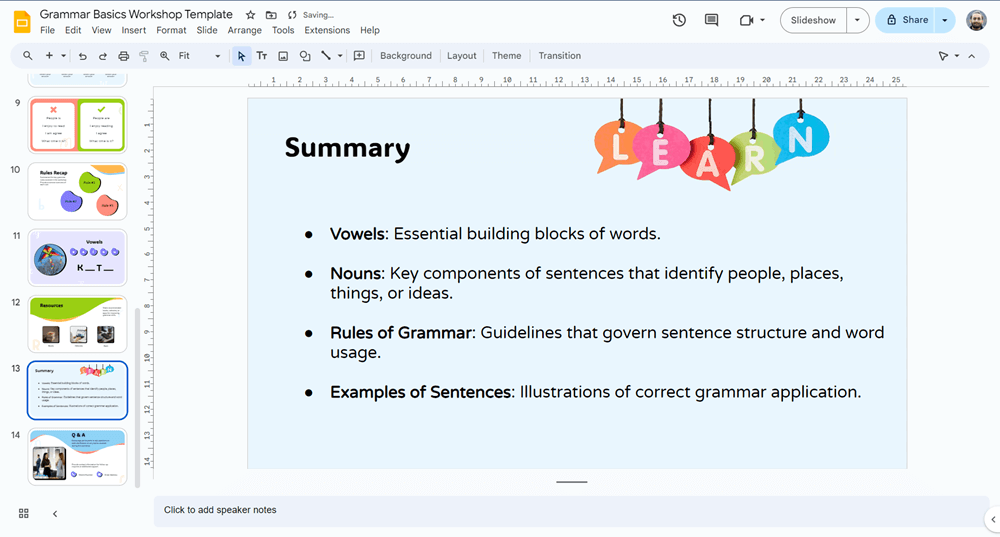
A summary slide is a great way to give your viewers an overview of the presentation once it ends. By recapping everything that was presented, summary slides make it easier to remember the most important takeaways.
A summary slide should include:
- Important Points: Clearly summarize the main points covered in your presentation.
- Visual Recap: Use simple visuals like graphics, charts, or callouts to visually represent significant data or conclusions.
- Concluding Remark: End with a sentence or two that encapsulates the overall message or conclusion of your presentation
- Maintain consistency in styling throughout your presentation for a cohesive look.
- Use color or size variations to emphasize the hierarchy of concepts summarized.
Closing Thoughts
Understanding the different types of slides and how to use them can significantly enhance your presentations. Feel free to mix and match slides based on your needs and presentation style. By choosing the right slides, you can create a more engaging presentation that leaves a lasting impression on your audience.
Create presentation slides with AI in Seconds in Google Slides
10M+ Installs
Works with Google Slides

Frequently Asked Questions
Which are the important slides for any presentation.
The core slides include:
- Title Slide: Captures attention with your presentation title, your name, and affiliation (if applicable).
- Agenda Slide: Briefly outline the key points you’ll cover, setting expectations for your audience.
- Closing Slide: Summarize your main takeaways and leave a lasting impression.
I have a ton of data. Should I use a text-heavy slide or a chart?
Charts win every time! Bullet points and dense text overload audiences. Visualize your data with clear charts (bar graphs, pie charts) to make it easily digestible.
Can I use images and videos in my slides?
Absolutely! High-quality visuals like pictures, infographics, and short videos can boost engagement and illustrate complex concepts. Just ensure they’re relevant and add value.
How can I make my slides more visually appealing?
Maintain a consistent color scheme, use high-resolution images, and avoid clutter. Explore presentation software features like animations and transitions, but use them sparingly to avoid distraction.
How can I find high-quality visual templates for my slides?
There are many resources available! Many presentation software programs like SlidesAI offer built-in image libraries. You can also find free stock photo websites or purchase royalty-free images from online marketplaces. Remember to check licensing requirements before using any visuals.
Are there any slide types I should avoid?
Slides overloaded with text are a major turn-off for audiences. Aim for visuals and concise points. Similarly, avoid excessive animations and transitions, which can be distracting.
Related Posts

Streamline Your Presentations with Automated Presentation Software
What are Automated Presentation Tools? Automated presentation tools are software applications or platforms that use artificial intelligence and automation technology to generate visually compelling and professional presentations from textual content. These technologies speed up presentation development procedures, save time, and improve presentation quality by automating several tasks, including slide layout design, formatting, and content summarising. […]

How to Time Slides on Google Slides
Presentations can be a powerful tool for sharing information and captivating your audience. But a presentation that drags on or rushes through key points can lose its impact. This blog will guide you through mastering the art of slide timing in Google Slides. We’ll explore how to set the perfect pace for your presentation, whether […]
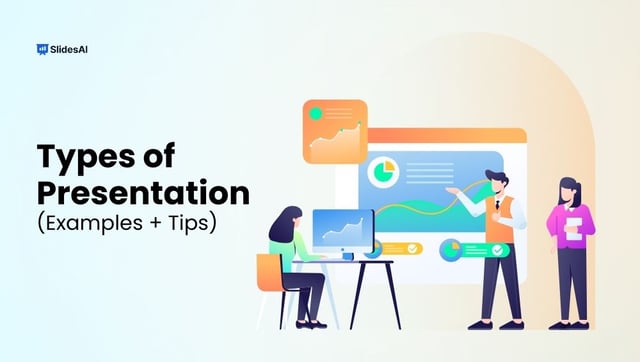
8 Types of Presentation with Examples and Tips
Every presentation is different, reflecting your unique business and the information you share. But, some common presentation types are used across various fields and teams. Before diving into specific slides or organization, consider the type that best suits your audience.
Save Time and Effortlessly Create Presentations with SlidesAI


COMMENTS
14 Fun & Interactive Presentation Games for Teams and ...
Top 10 PowerPoint Presentation Games (2022)
Heart, Gun, Bomb - Interactive presentation games. This one's a great game to use in the classroom, but if you're not looking for students' games for presentation, it also works wonders in a casual work setting. Heart, Gun, Bomb is a game in which teams take turns to answer questions presented in a grid. If they get an answer right, they either ...
Tailor your choice of games to align with your presentation goals, ensuring they enhance your message rather than distract from it. Now, let's explore 15 interactive presentation games that you can incorporate into your presentations to engage your audience effectively: 01. Polling and Surveys.
15 Interactive Presentation Ideas to Elevate Engagement
20 Interactive Presentation Games
4. Wheel of Fortune Game for PowerPoint. The Wheel of Fortune is a word puzzle game, Wheel of Fortune sees players guessing letters to complete a phrase. To create this game as a PPT presentation, you can use text boxes in PowerPoint for the puzzle, and animations to reveal letters as they're guessed.
21 Interactive presentation games. These ideas are great for any kind of event - from a sales kickoff meeting to a work retreat. If you are planning a seminar or industry event, consider some of these options as additions to conference activities that attendees love. 1. Live trivia.
5 Interactive PowerPoint Game Templates For ...
Here are eight more ideas for your next class, workshop, or meeting. 1. Process of elimination. This presentation game for 10 or more players helps the audience get to know each other. This game provides valuable insights into your audience members while also giving them a chance to stretch their legs.
20 interactive PowerPoint activities to add awesome ...
Here are some effective ways to make presentations more interactive and get students involved: 1. Use polls/surveys. 2. Use quizzes, leaderboards, and points to make the content feel more game-like and fun. 3. Pose questions and cold call on students to answer and discuss their thinking. 4.
Audience activities and games, such as 'Cross the Line', 'Fishbowl Discussion', 'Bring it On', and the 'Talking Stick' method, significantly enhance presentations by actively involving the audience. These activities foster personal sharing, respectful dialogue, and group engagement. They also encourage audience members to contribute their ...
10 Free PowerPoint Game Templates
With ClassPoint inside PowerPoint, you can open the Leader Board to reveal the top standings & podium to motivate students with friendly competition. How: Click on the Leader Board trophy from the toolbar and watch confetti burst revealing the top star standings. Note: there is a current class and a total stars leaderboard; if you create a ...
50 Fun Icebreakers For Your Next Presentation
Even more fun presentation game ideas: for extra fun, add a simple choreography, for example clapping or waving your hands. 9. Quiz game. A quiz is an often used but very effective interactive presentation game. Announce in advance that a quiz game will be played at the end of the presentation. This keeps the audience paying attention ...
Top Free PowerPoint Game Templates for a fun Presentation
Step 1: Create your free AhaSlides account. Step 2: Pick your desired template, or you can start with a blank one and use the AI slide generator to help create quiz questions. Step 3: Fine-tune, test and present it in front of the live audience. Your participants can access the quiz easily via smartphones.
12 Interactive PowerPoint Activities Your Students will Love
How To Make a Good Presentation [A Complete Guide]
Free PowerPoint Games And Templates To Teach English
Meeting Kick-Off: Start your meetings with icebreakers to get everyone engaged and set a positive tone. For example, "Two Truths and a Lie" can break the ice effectively. Team-building Events: During team-building activities, icebreakers help foster connections and boost team spirit. "Human Bingo" is a fun choice.
Gamification involves incorporating game-like elements into your presentation to make learning more engaging. This approach can turn routine information into an interactive experience, boosting motivation and retention. ... Scenario: In a presentation about architectural design, use AR to allow the audience to view 3D models of building ...
However, the game still has an incredible amount of polish and merit. Here are just a few of the reasons why Dragon Age 2 is slept on more than it deserves. 7 The Novel Presentation
Movie Grid is a daily trivia game where you use the clues to pick a movie for each spot on the grid. Come back every day for a new game. Can you name a Richard Pryor movie with a "Y" in the title?
If you use Microsoft PowerPoint for your slideshows, then you know that creating a presentation with a template can save you a lot of time. A template gives you a jumpstart on the design, layout ...
The Xbox 360 Store Will Close July 2024, But You Can ...
CHICAGO — If Gerrit Cole wanted to turn the opposing pitcher on days he starts into an unlikeable target, that would be impossible on Sunday. Jameson Taillon is too good of a friend, and too ...
By knowing the different types of slides and how to use them well, you can create interesting and informative presentations that will stick with your audience. Different Types of Slides. There are many different types of slides that you can use in your presentations. Some of the most common types include: Opening Slides 1. Title Slide